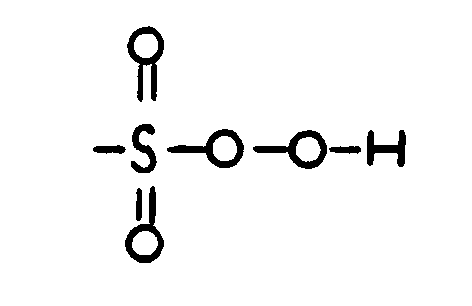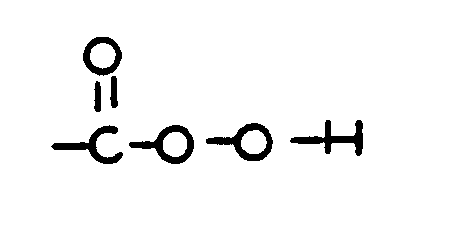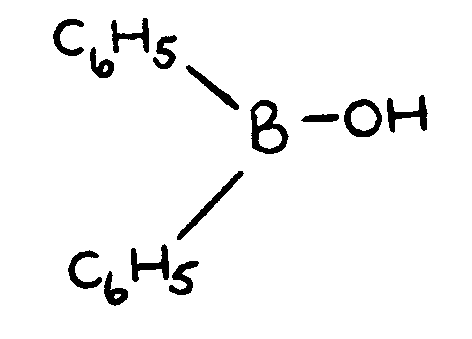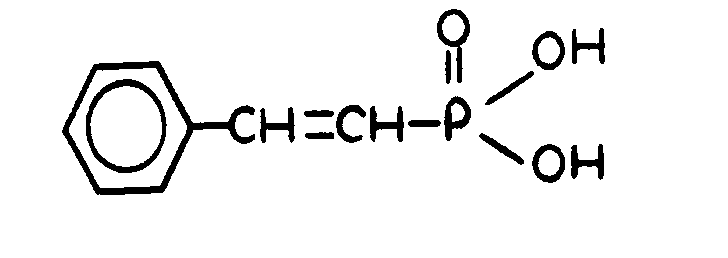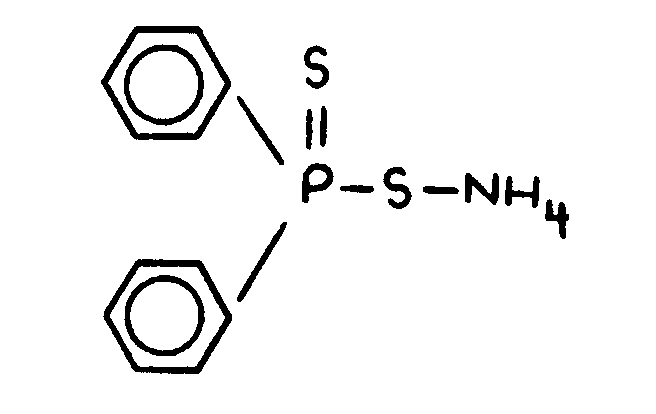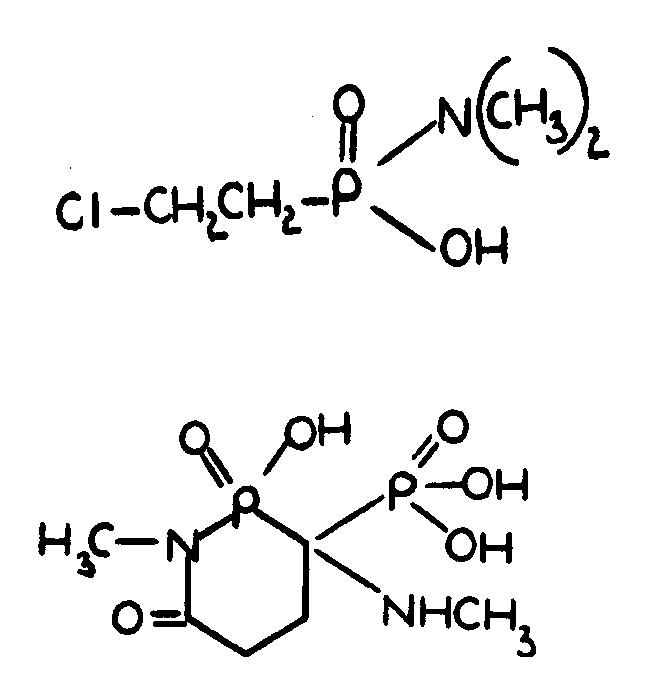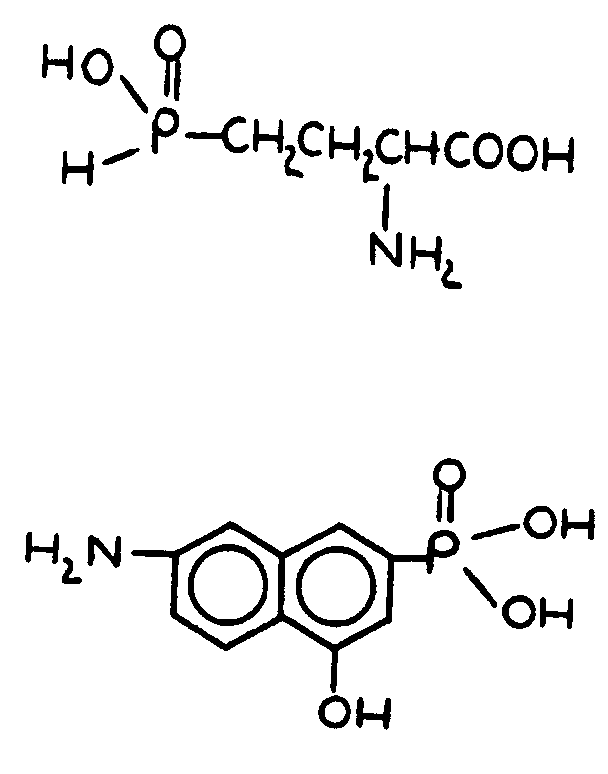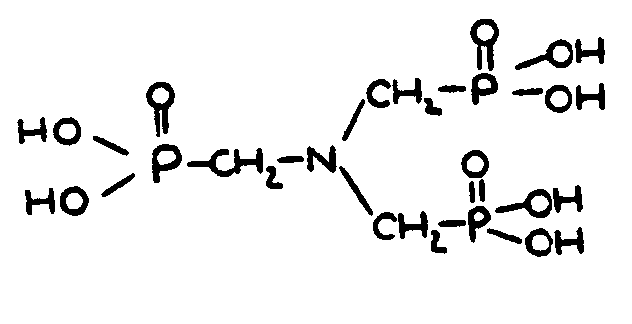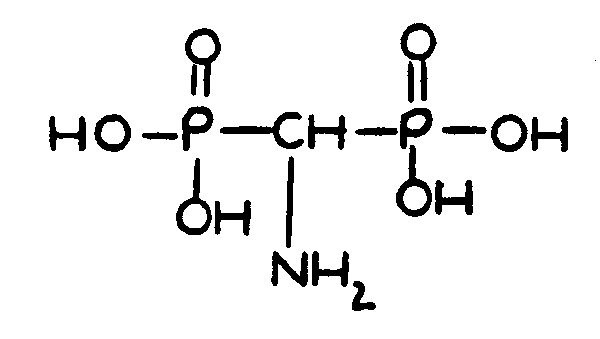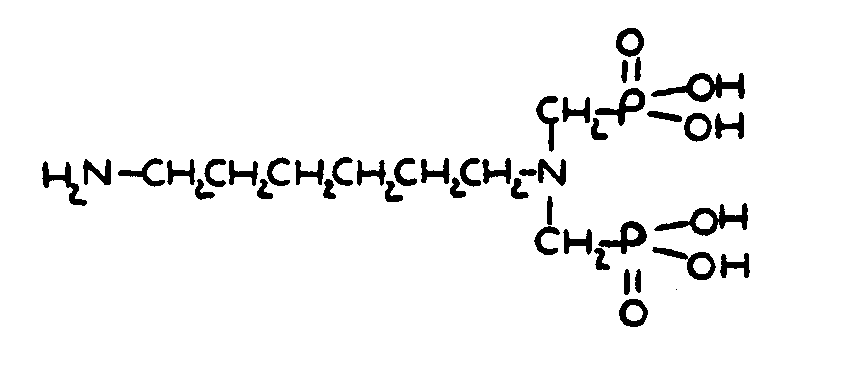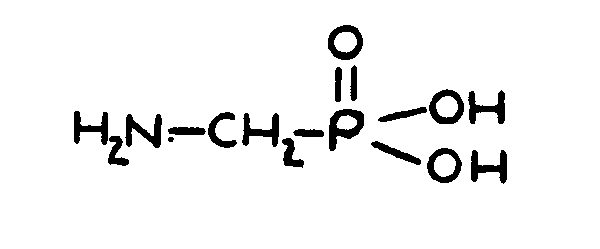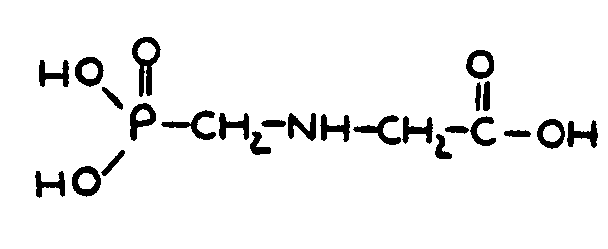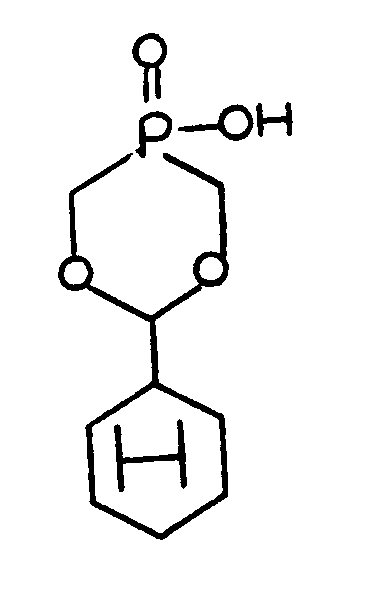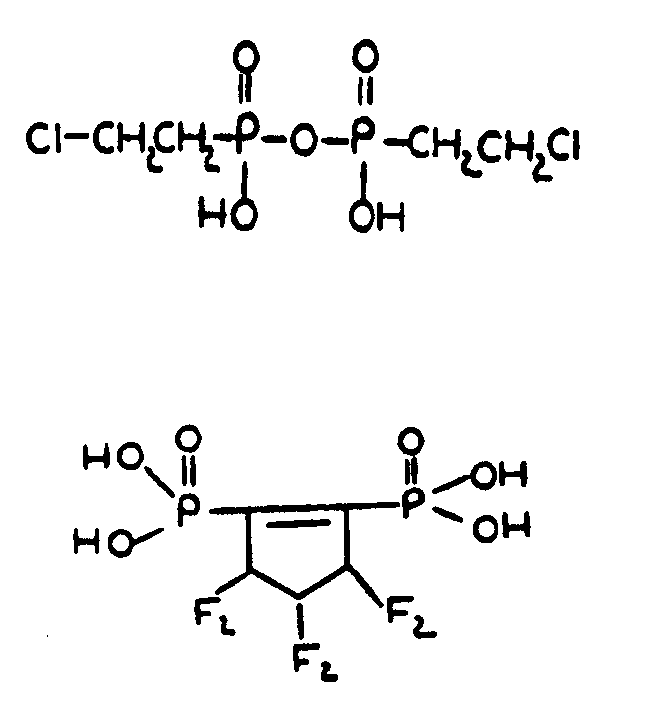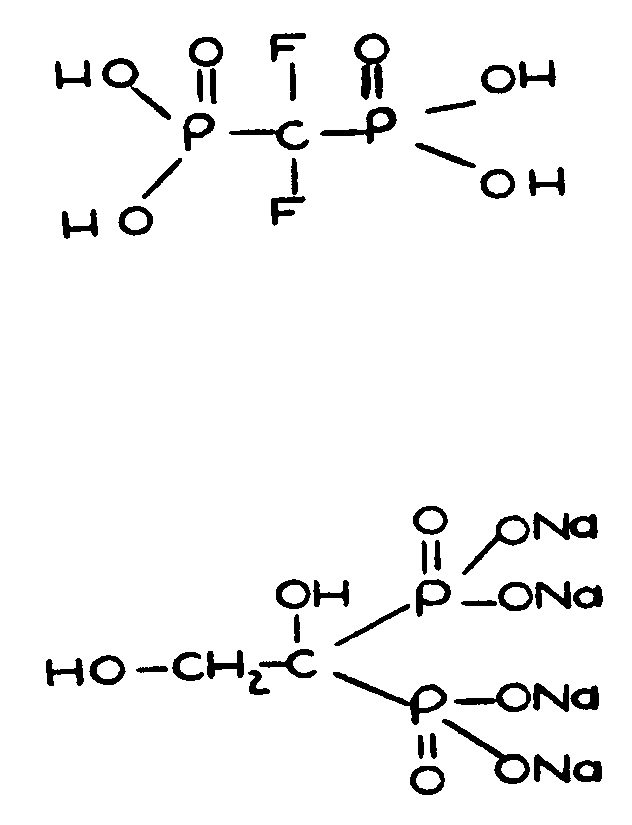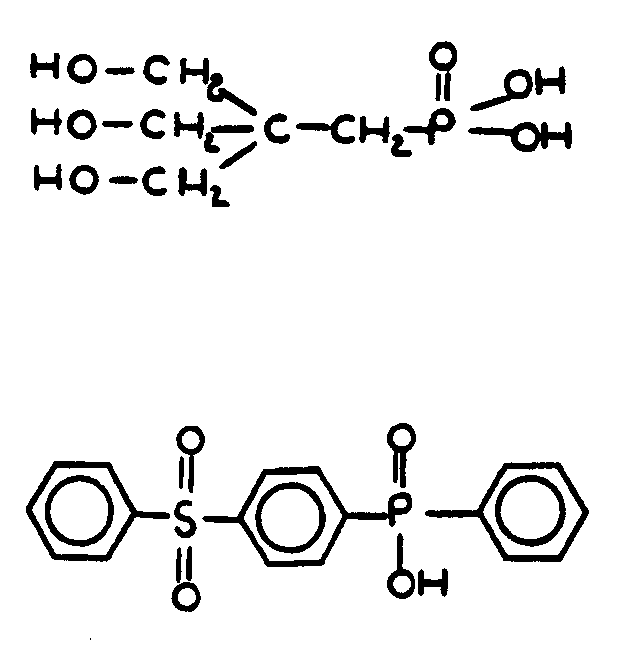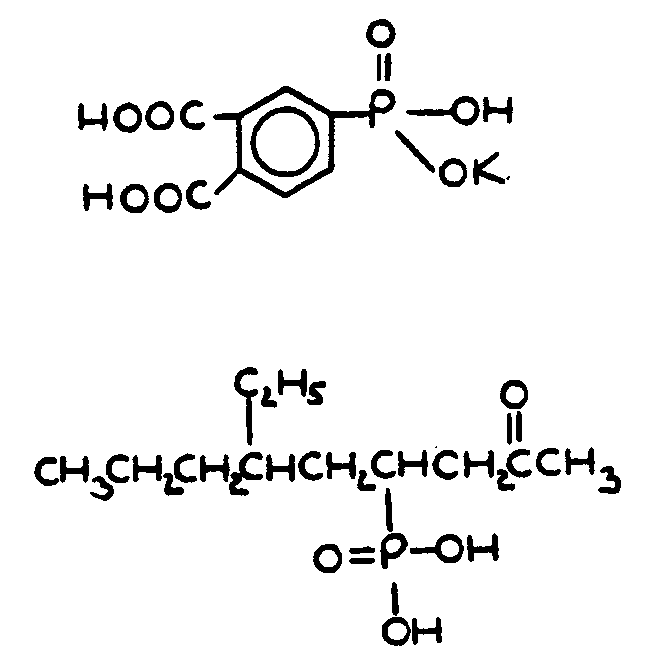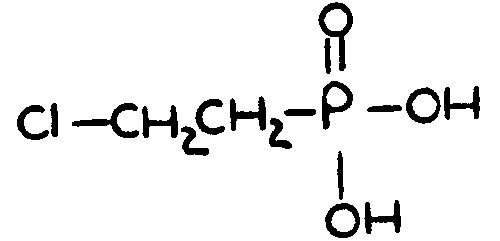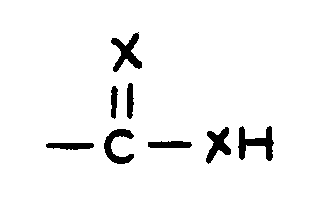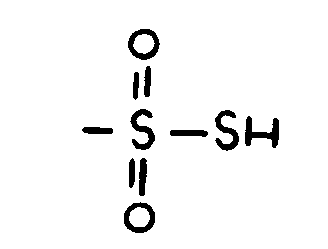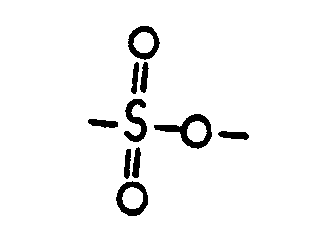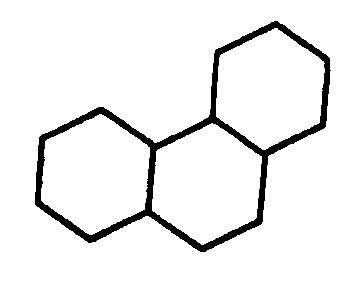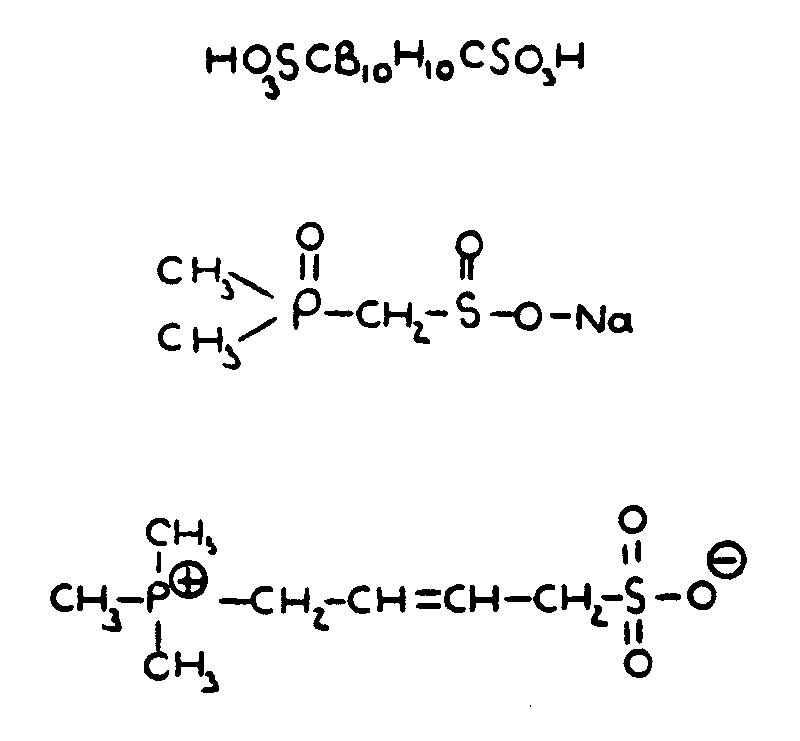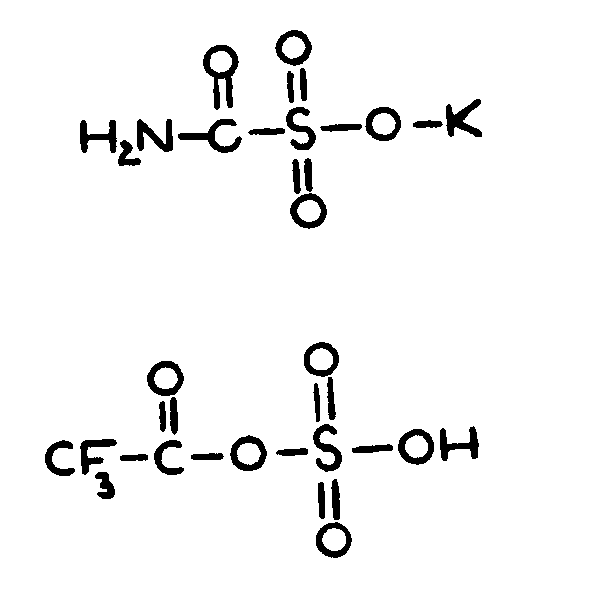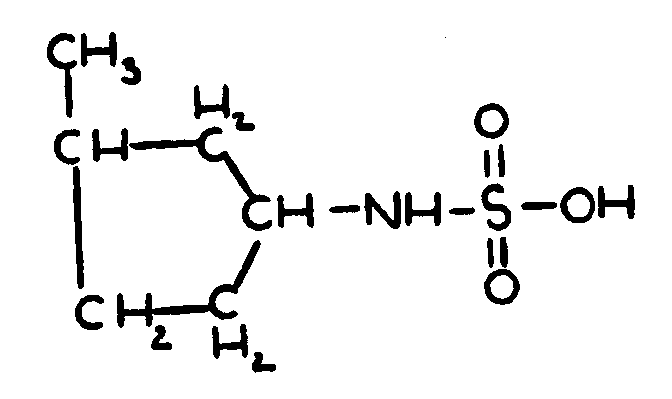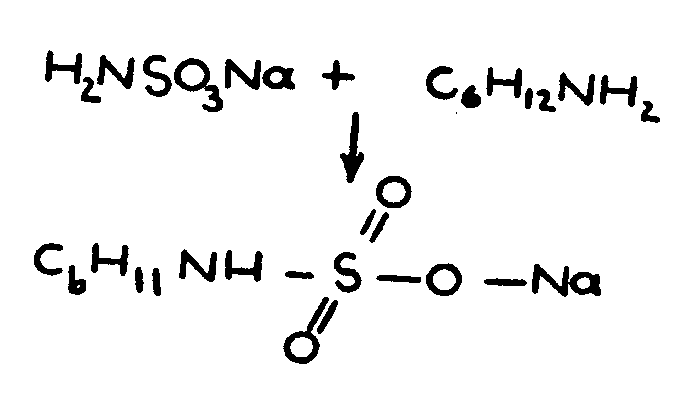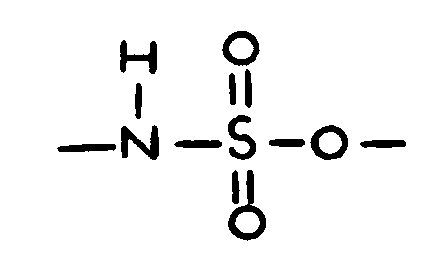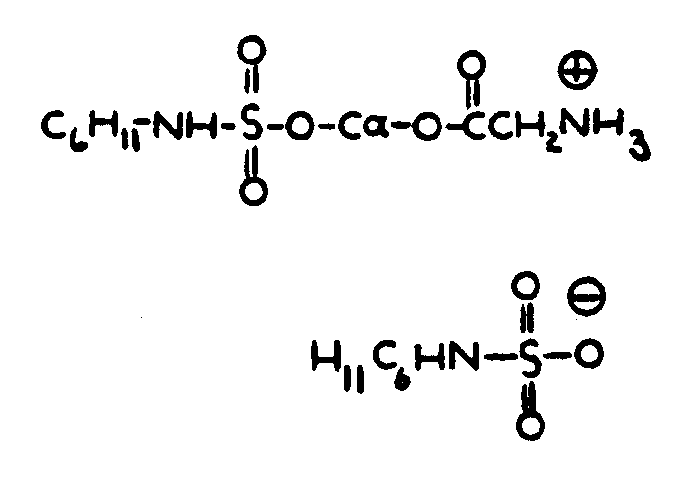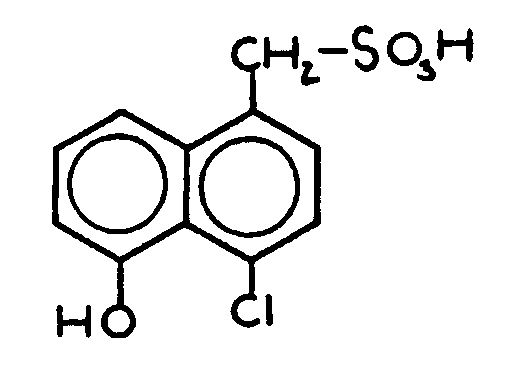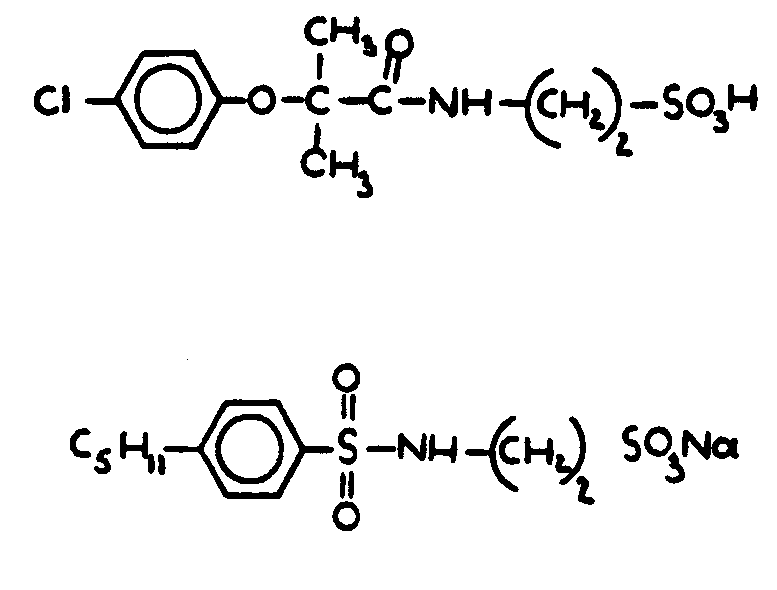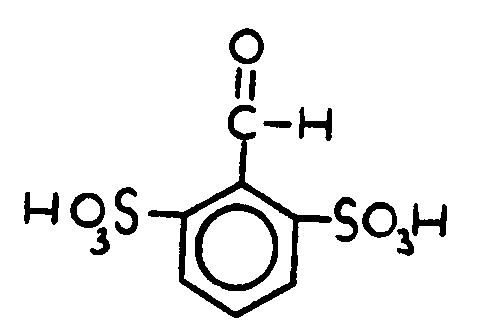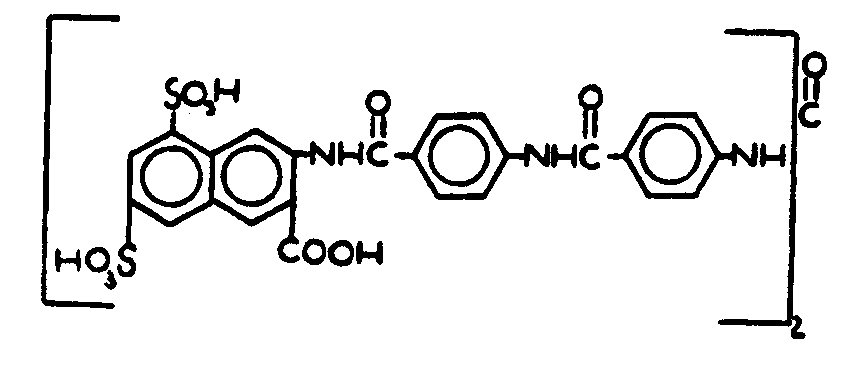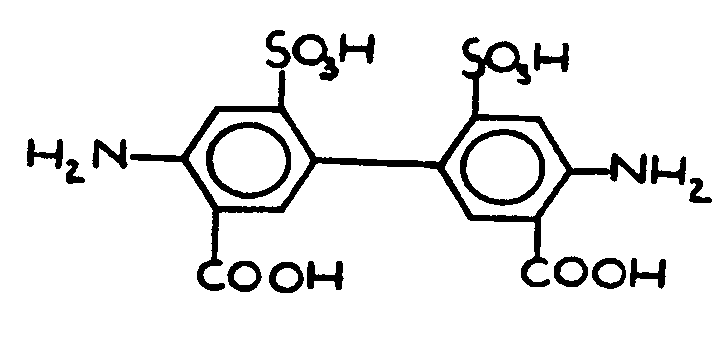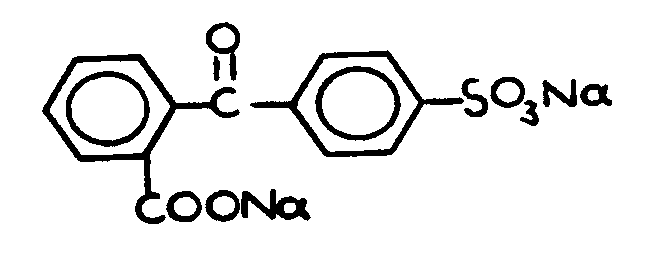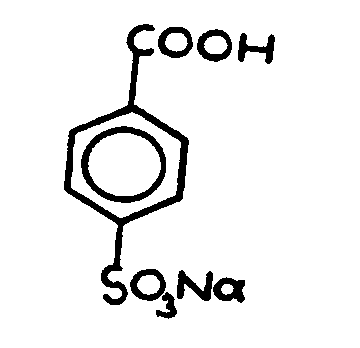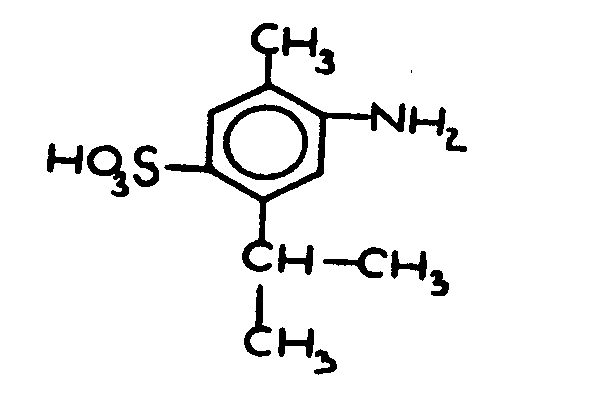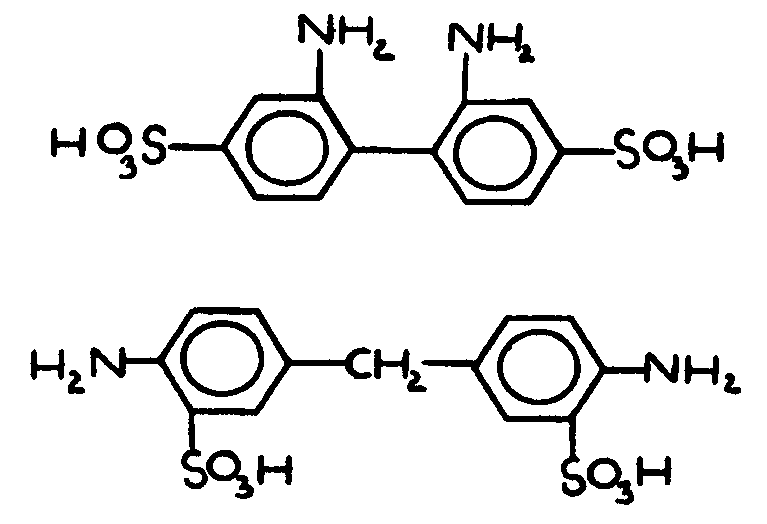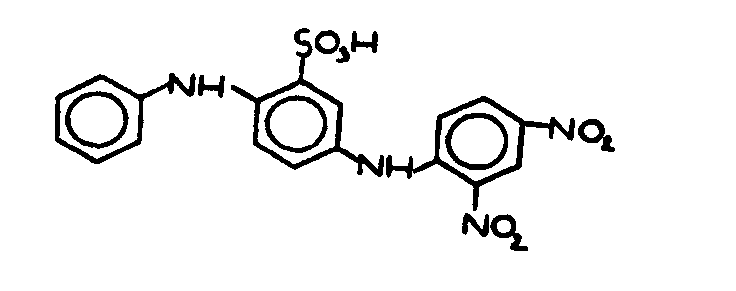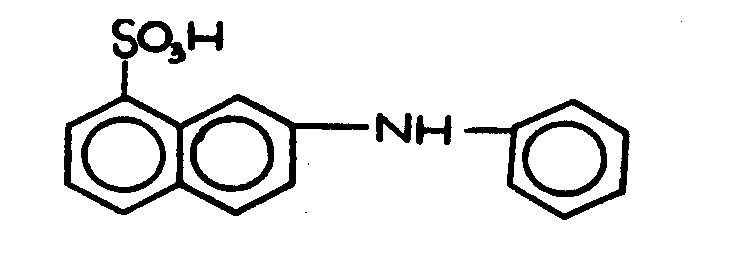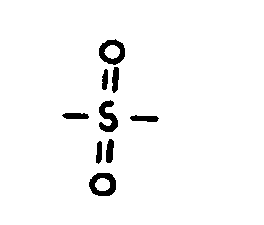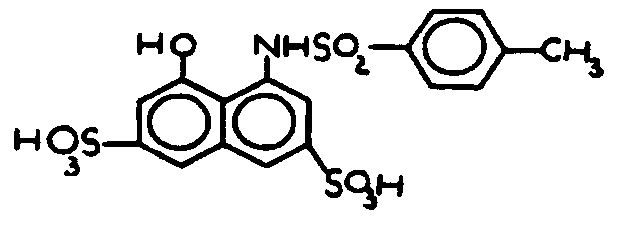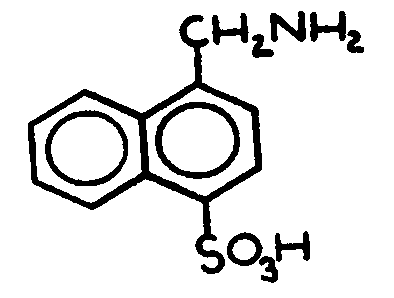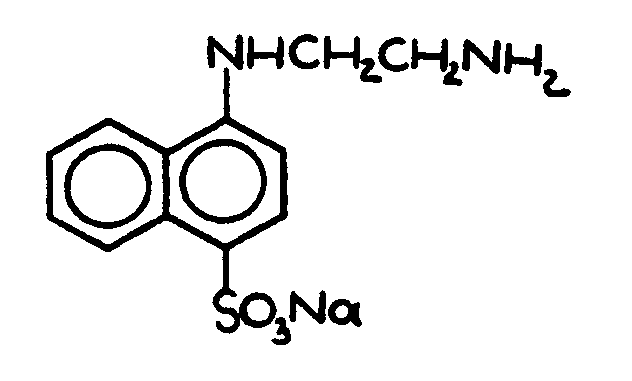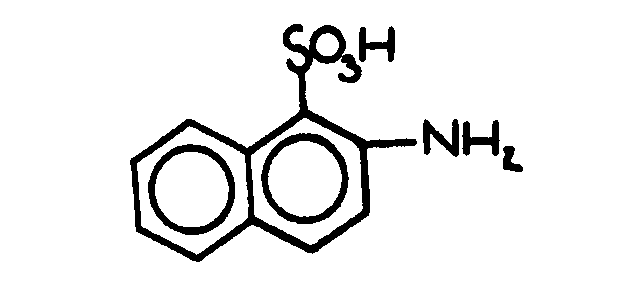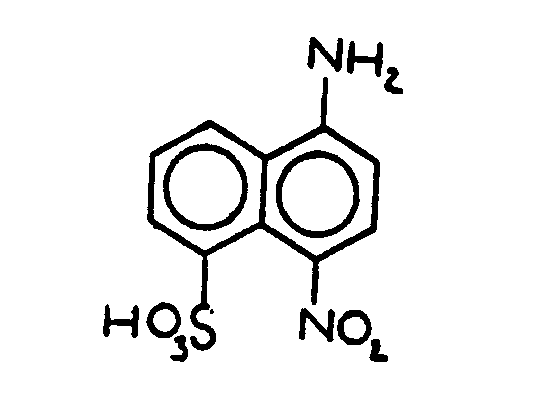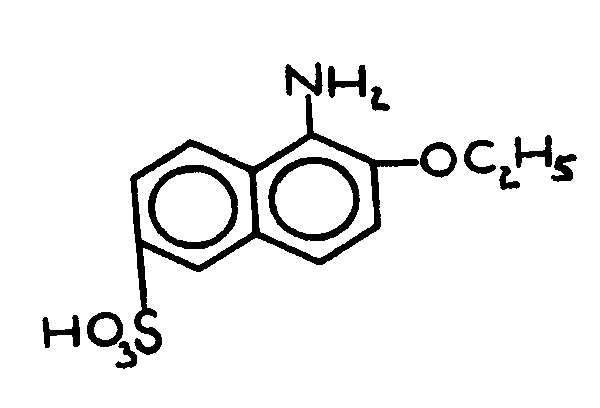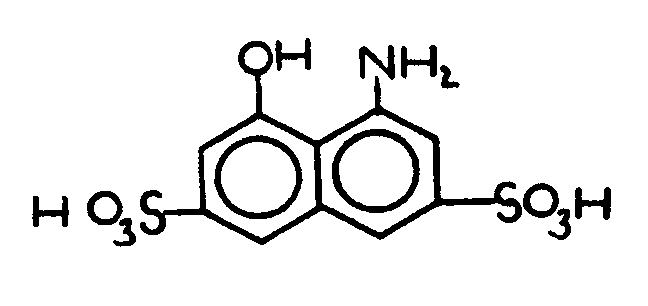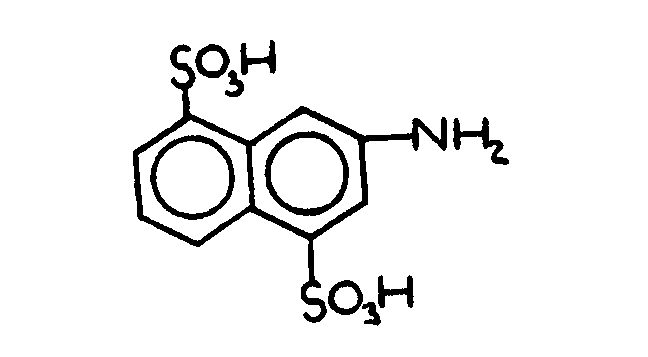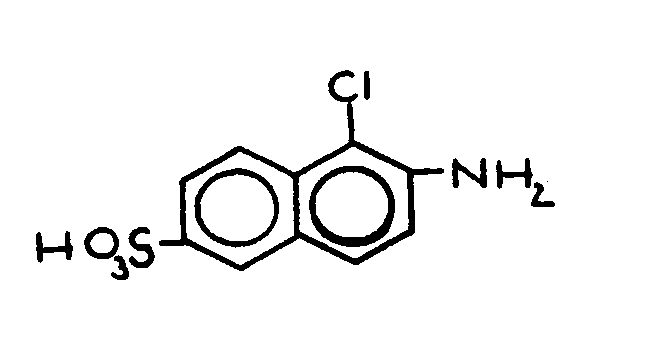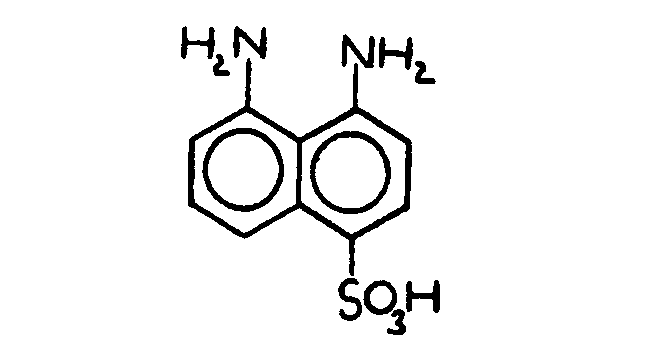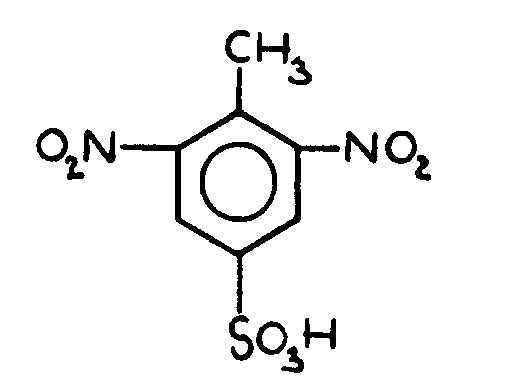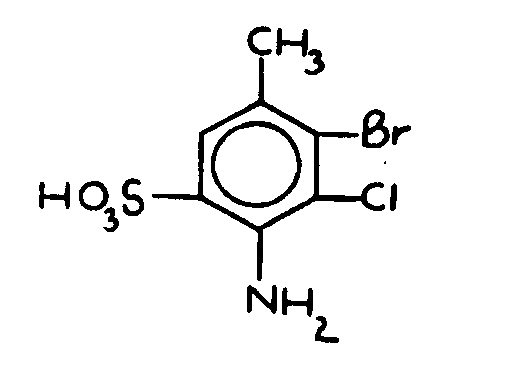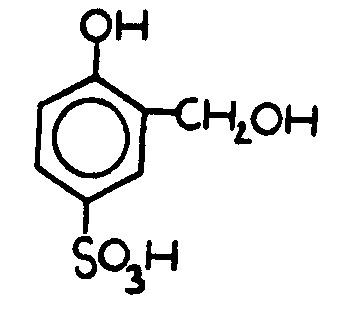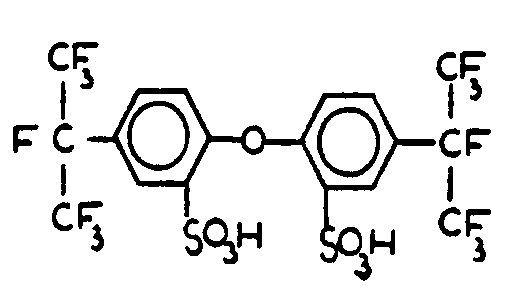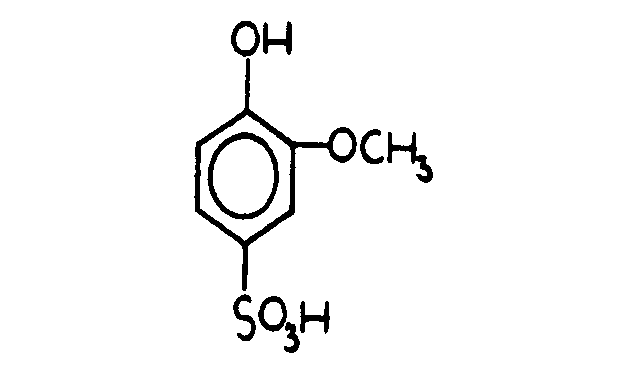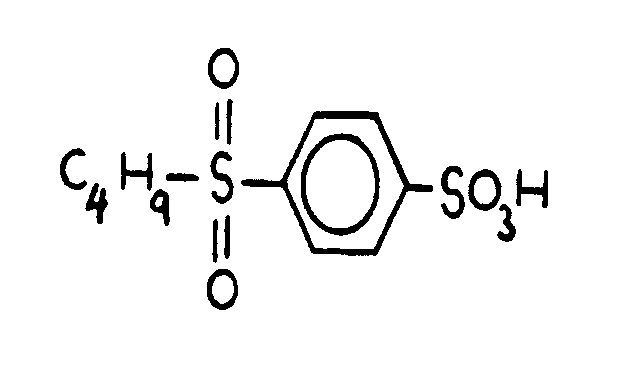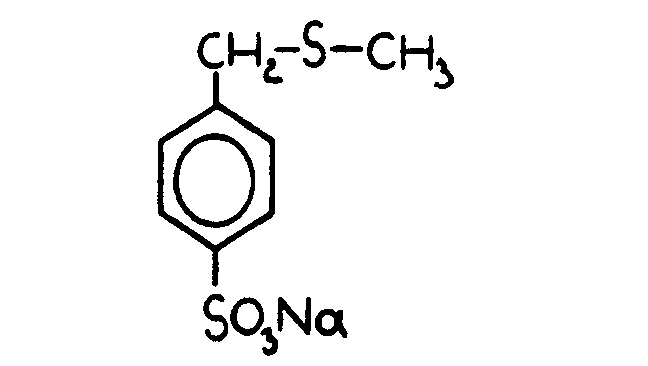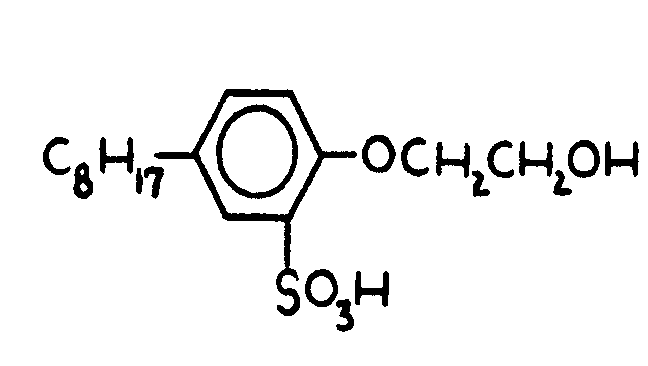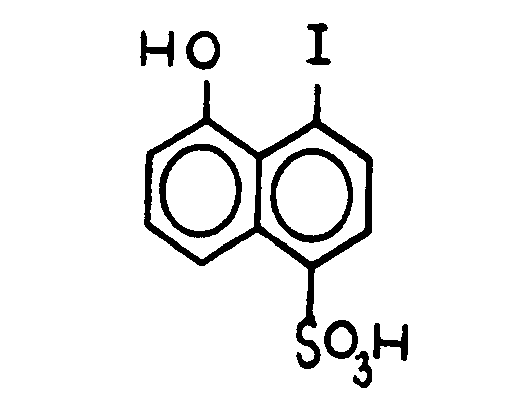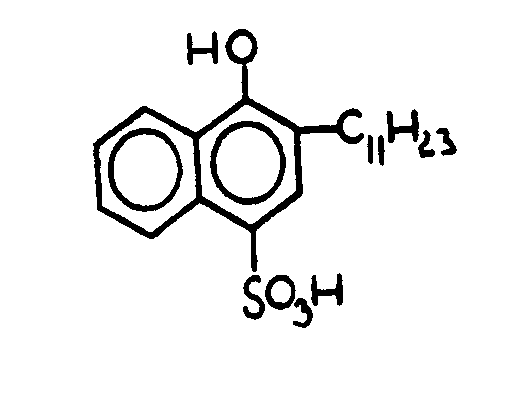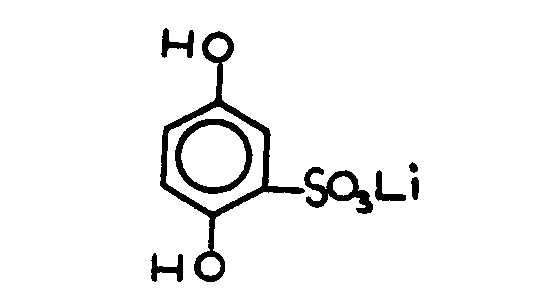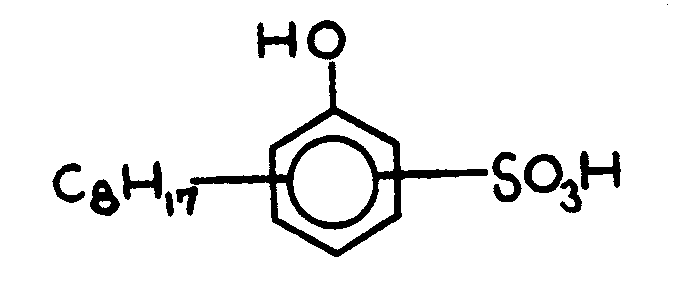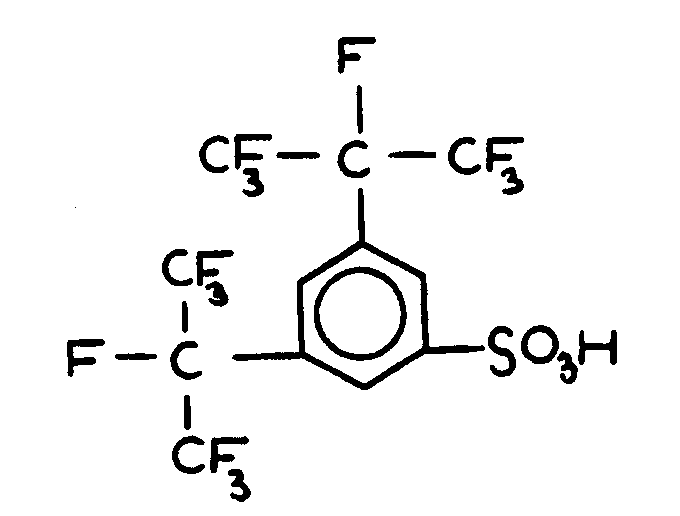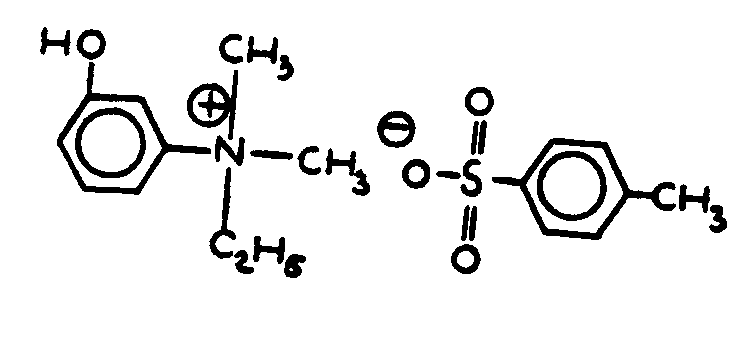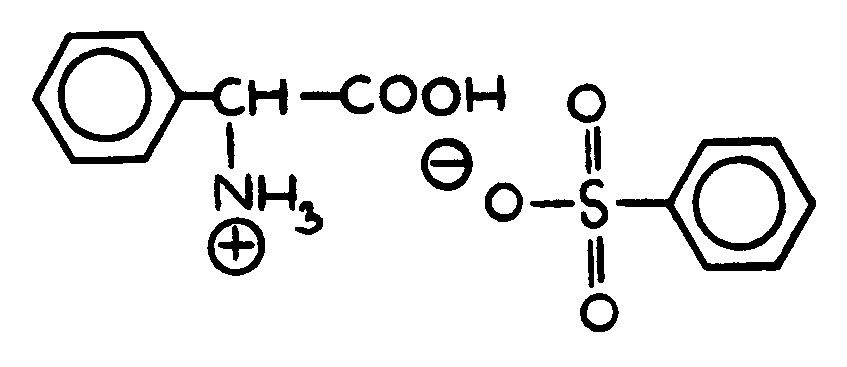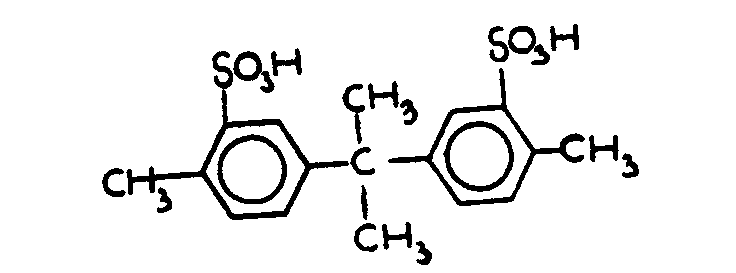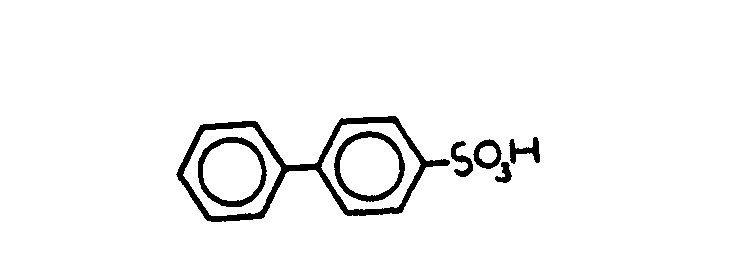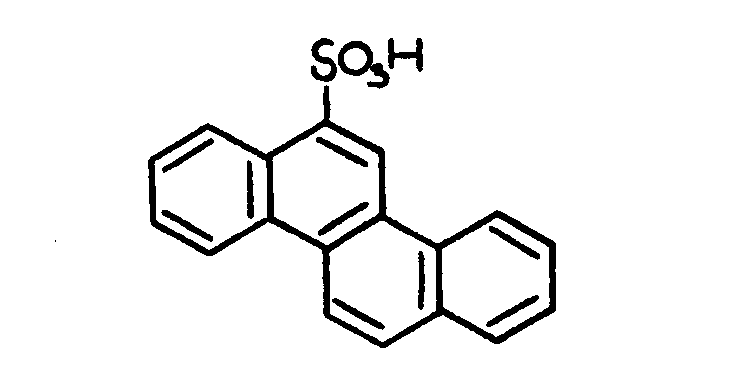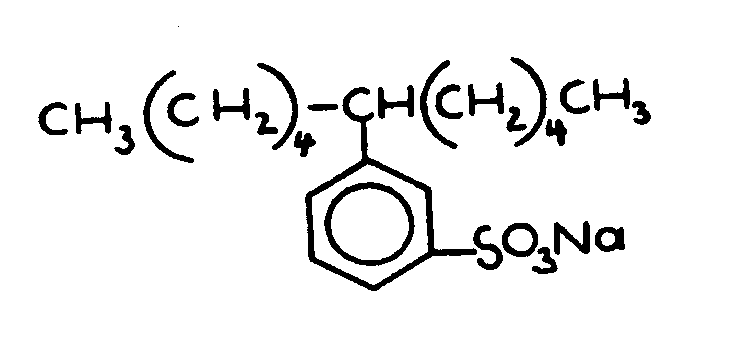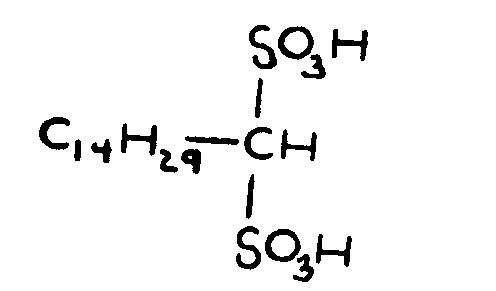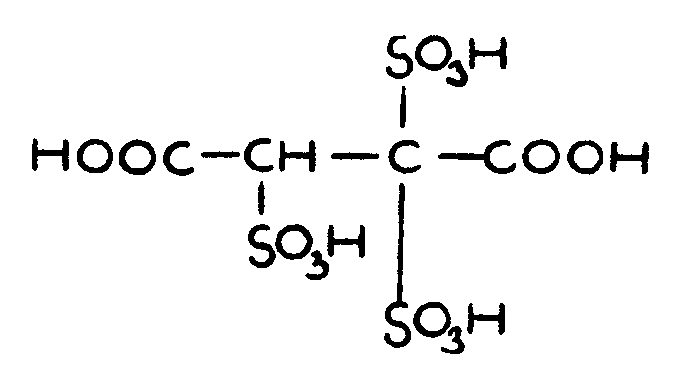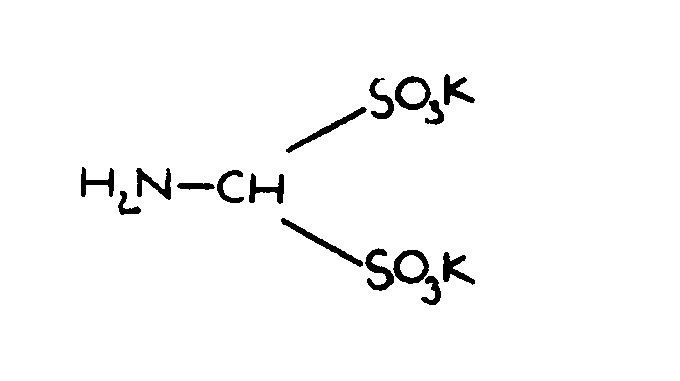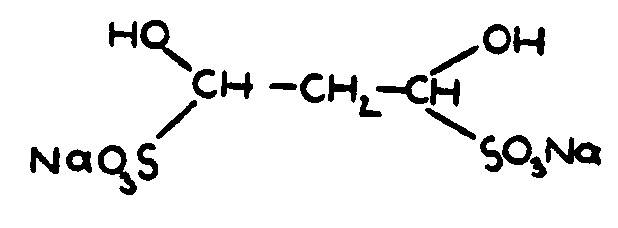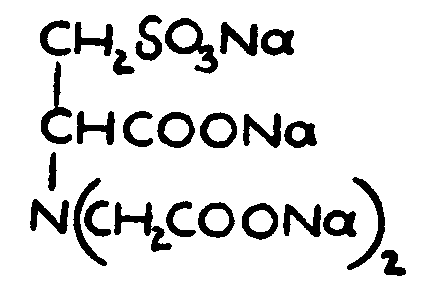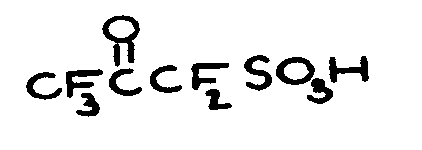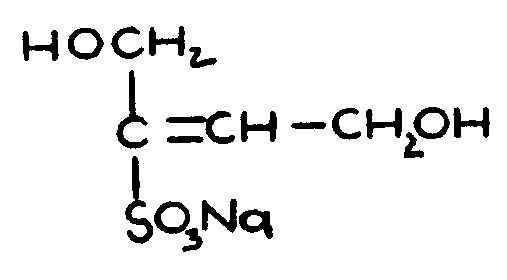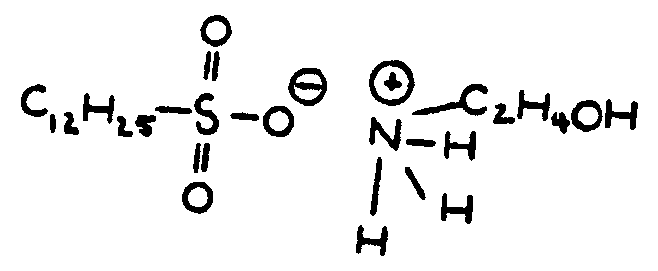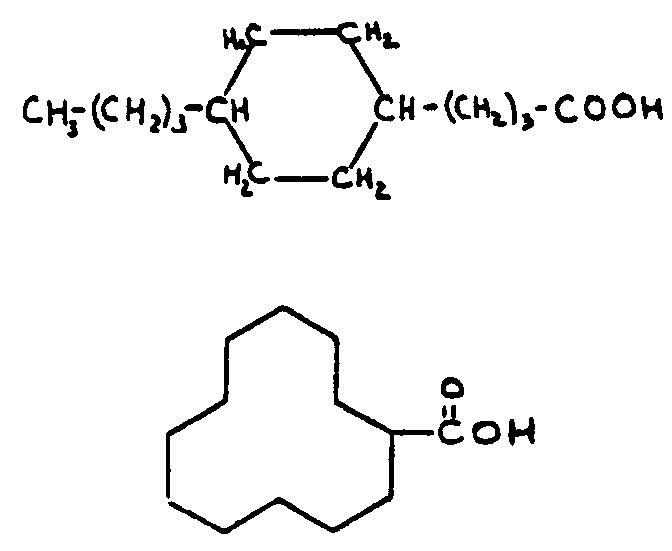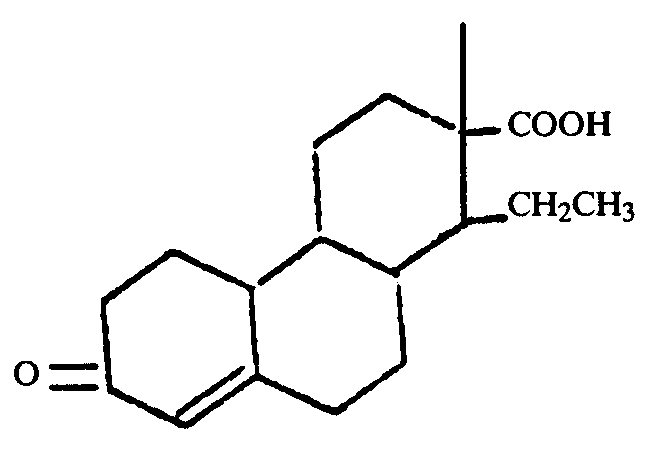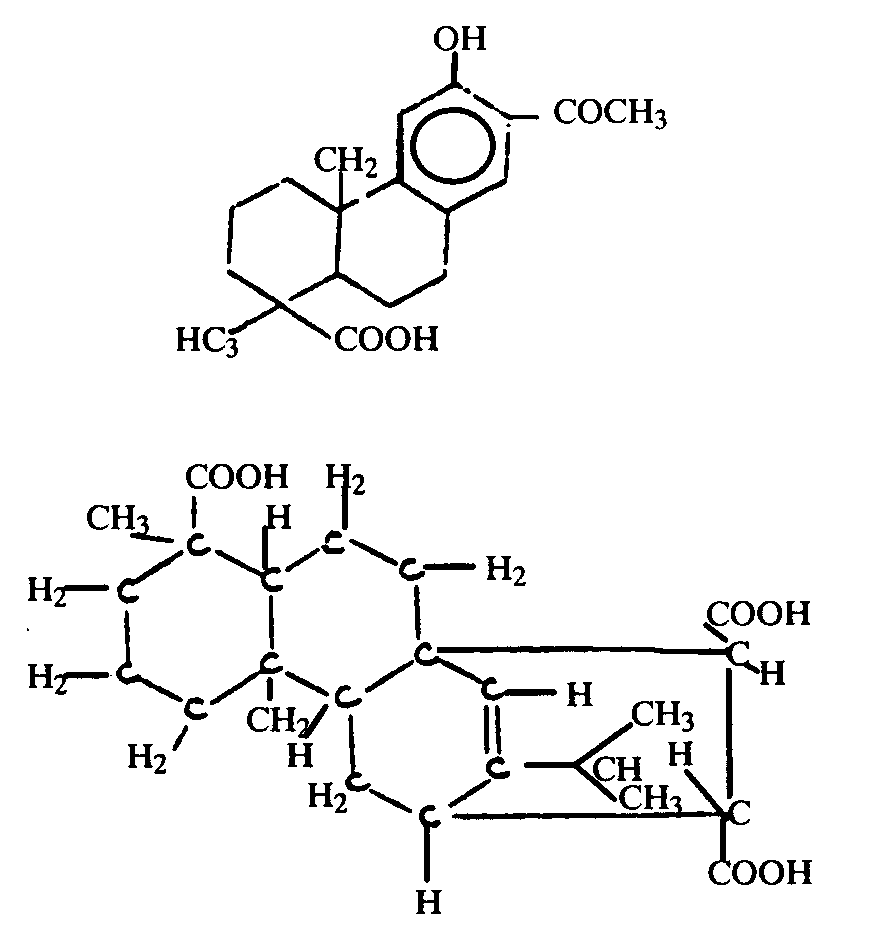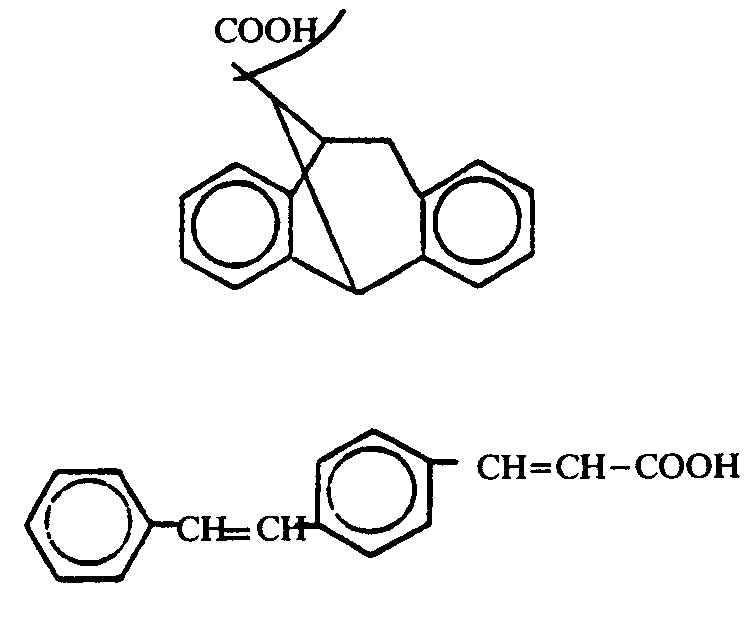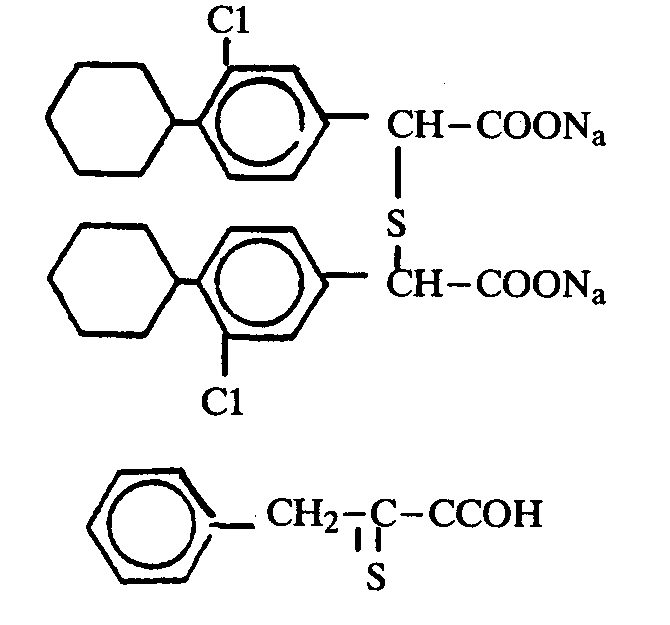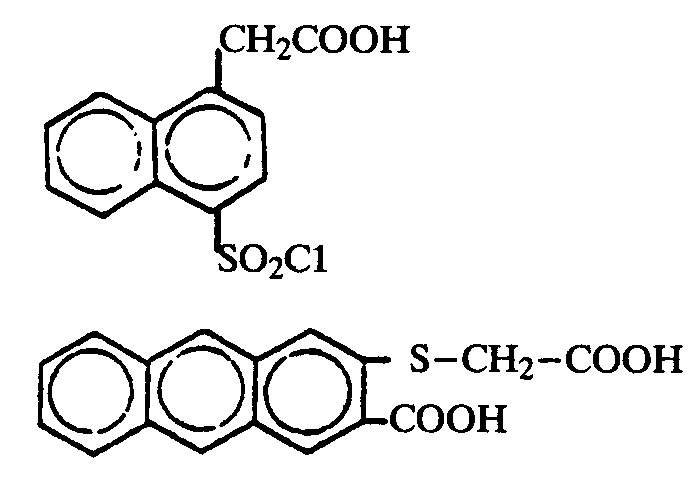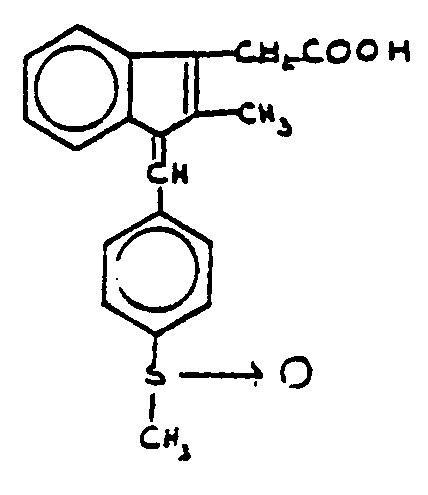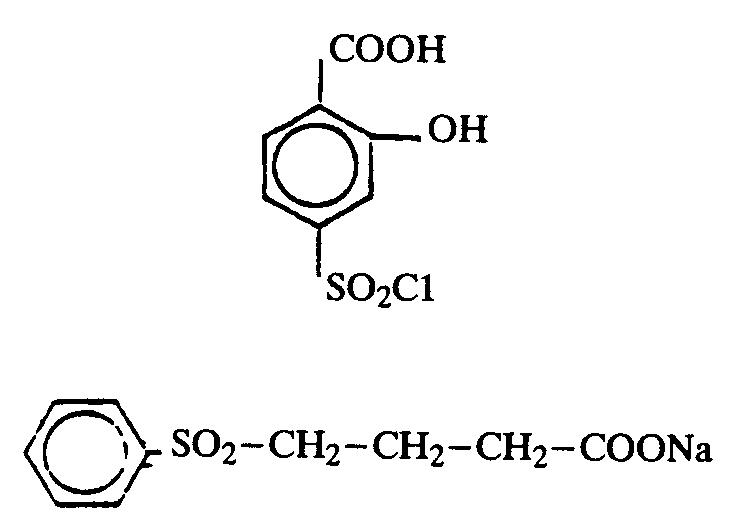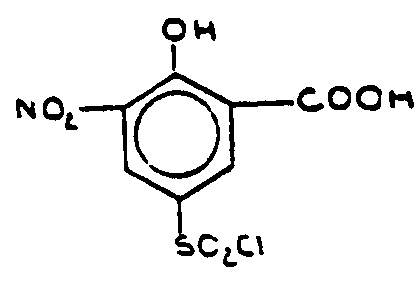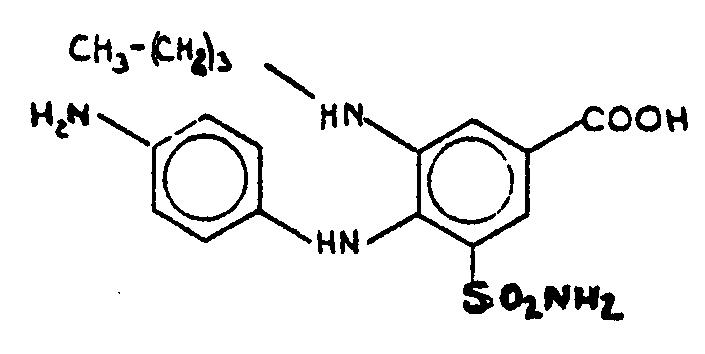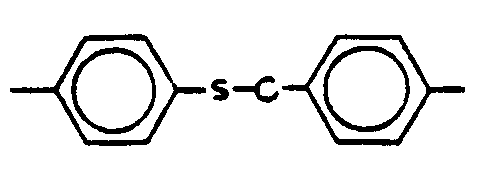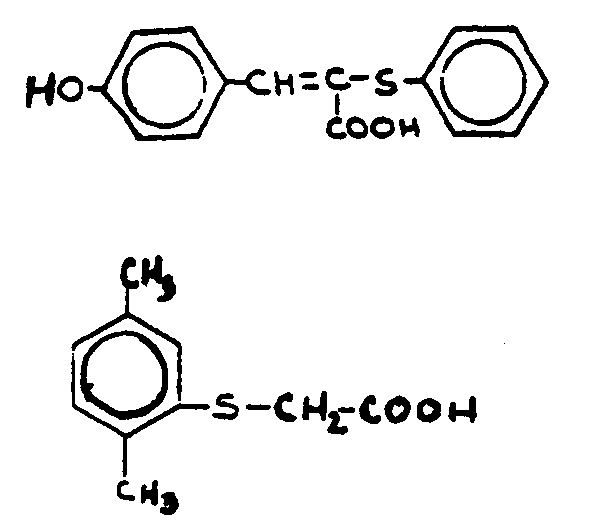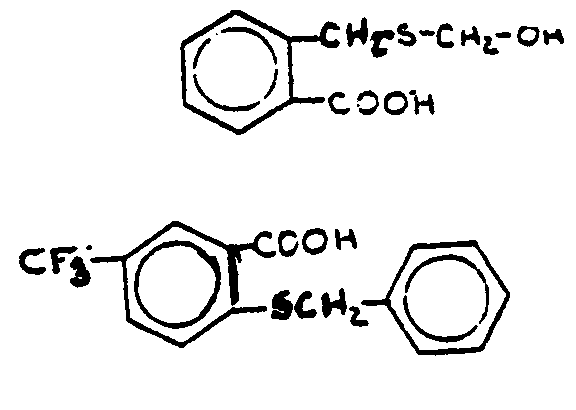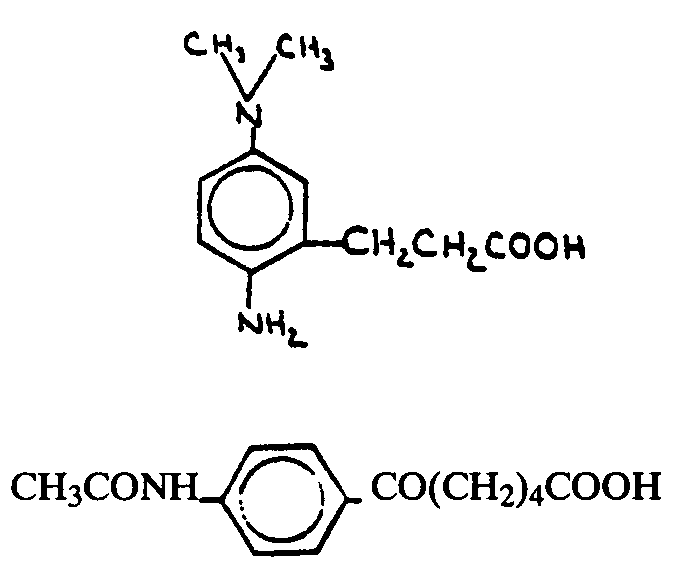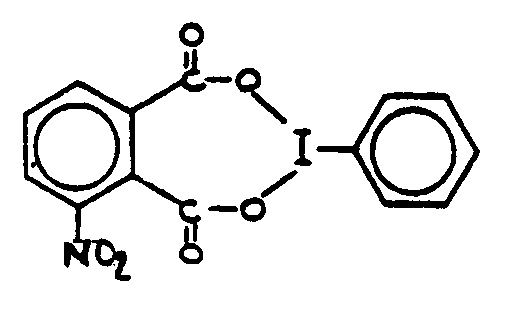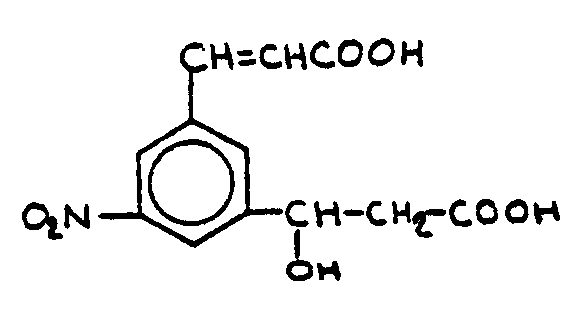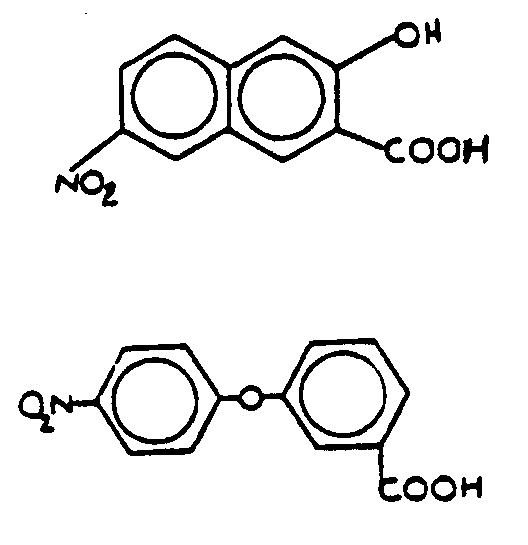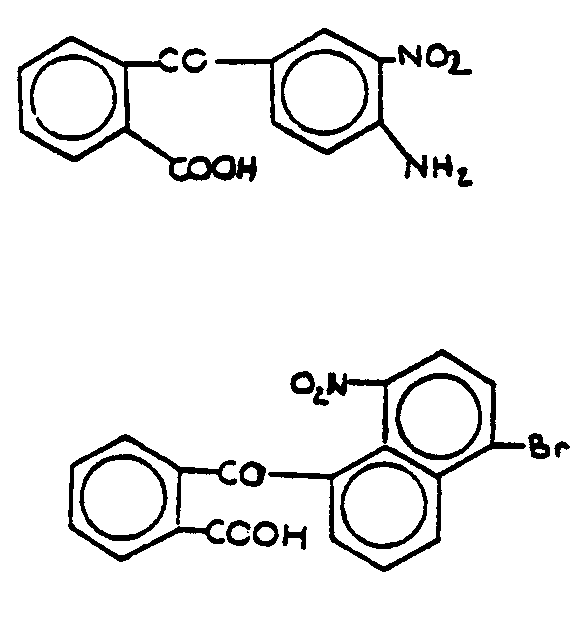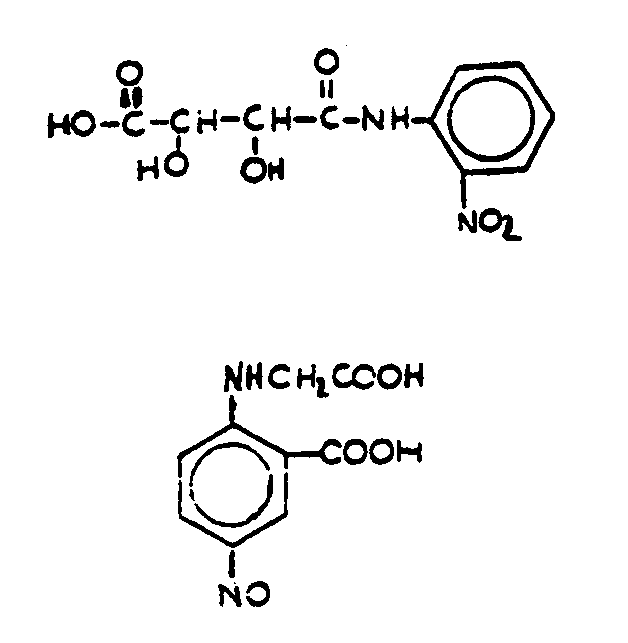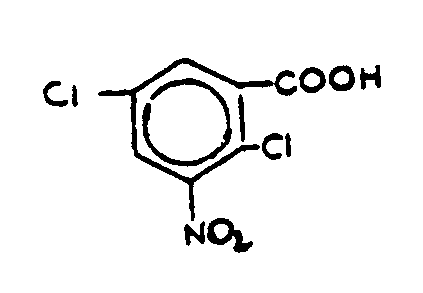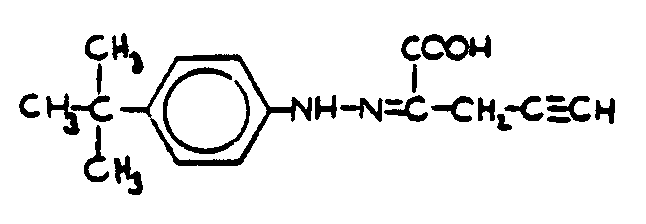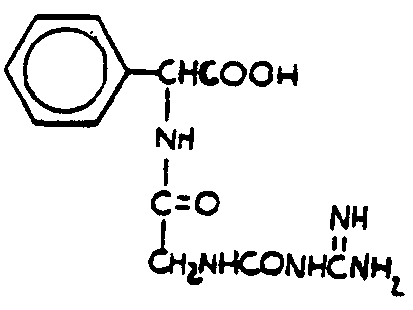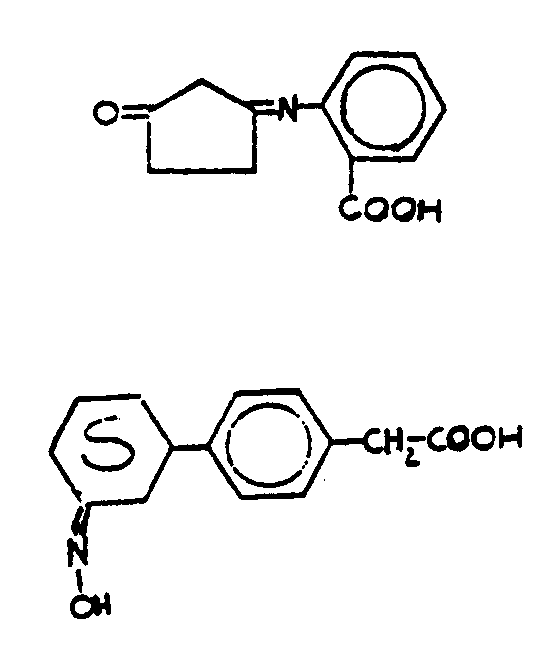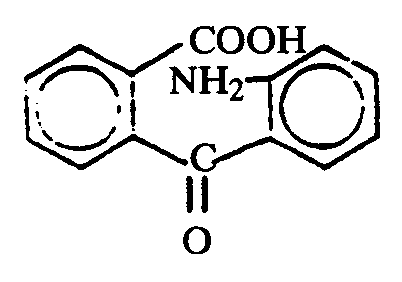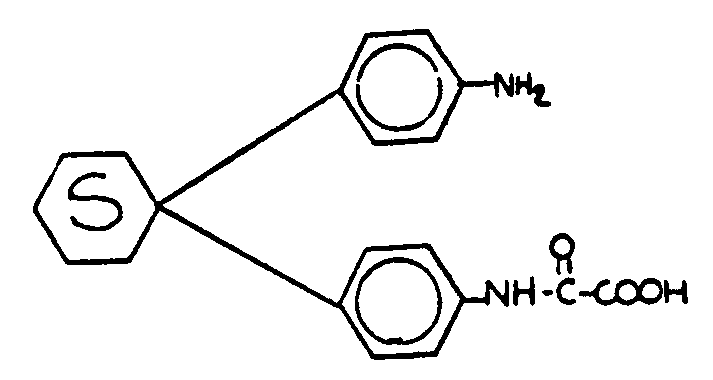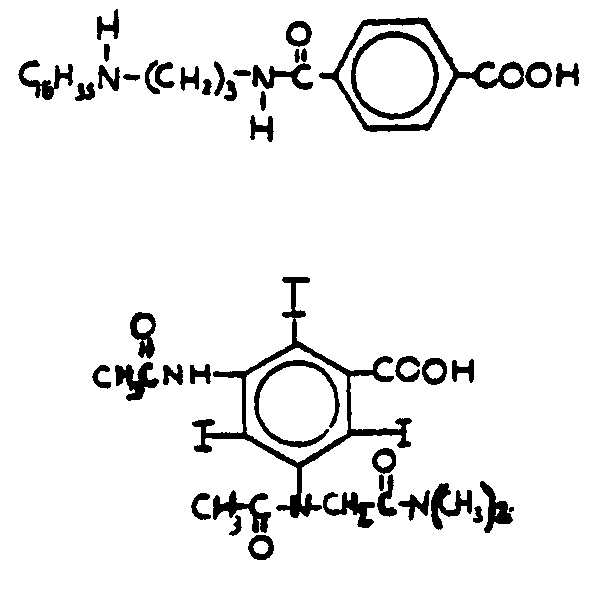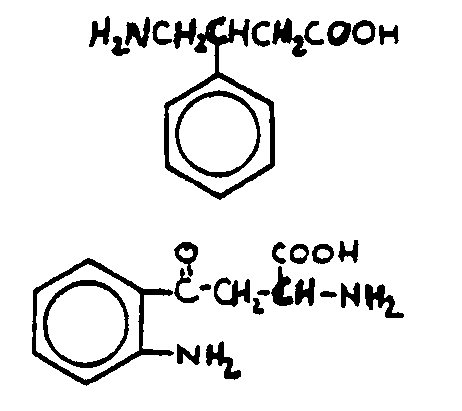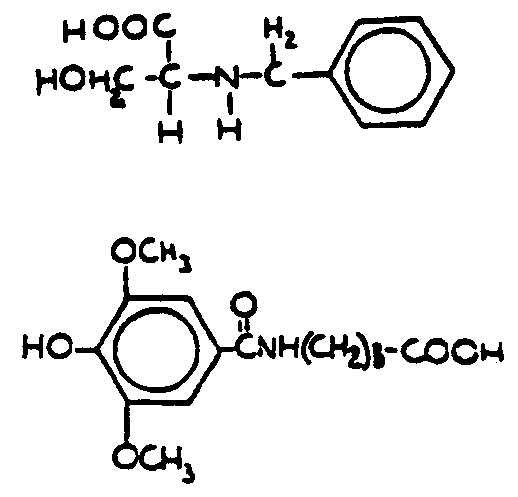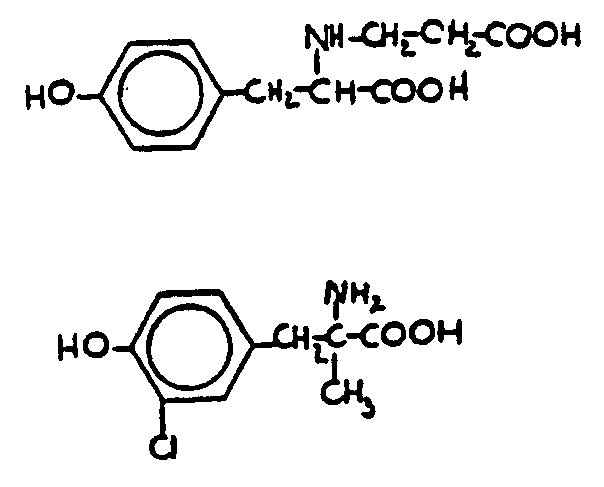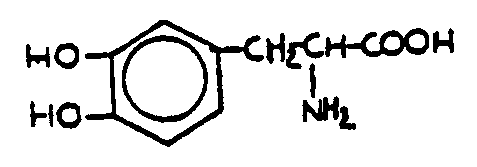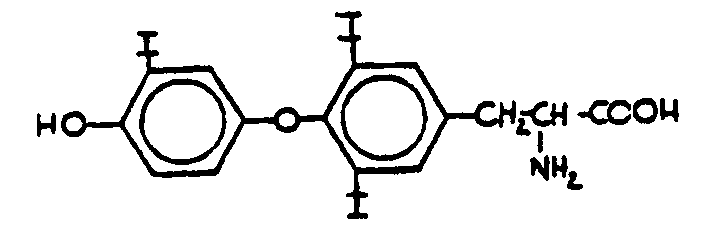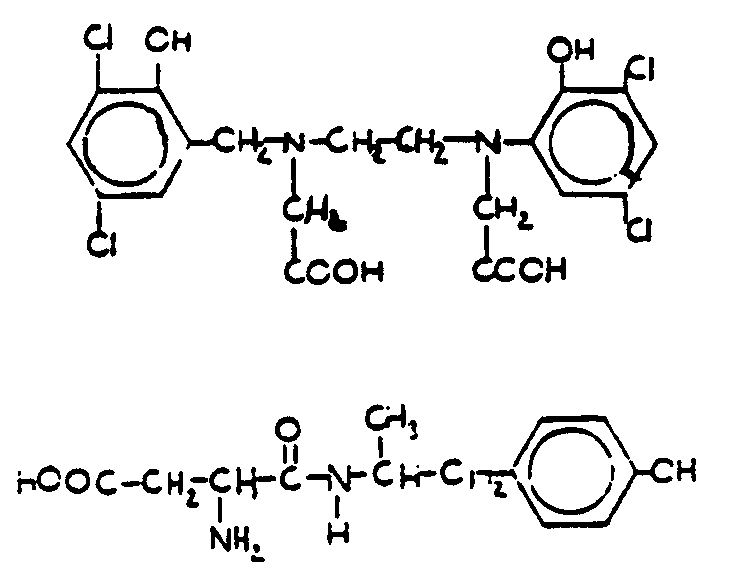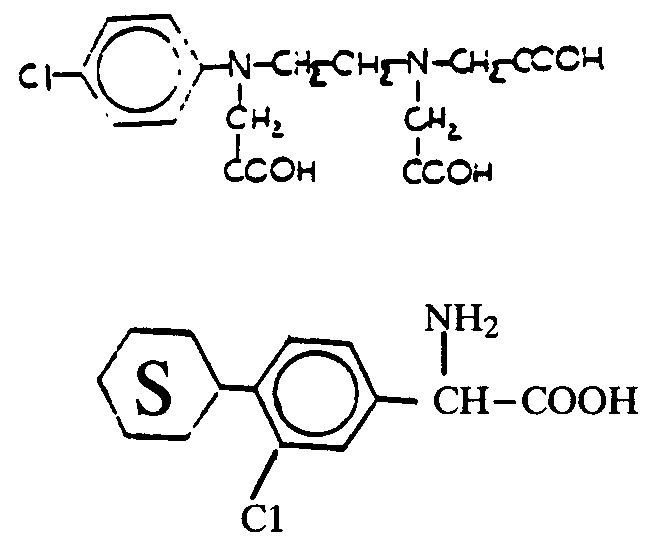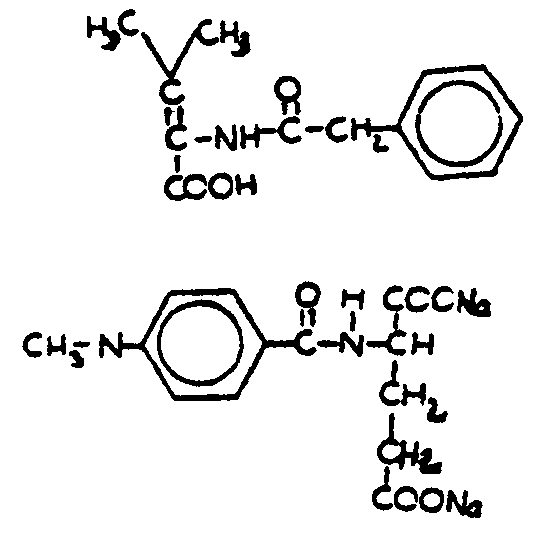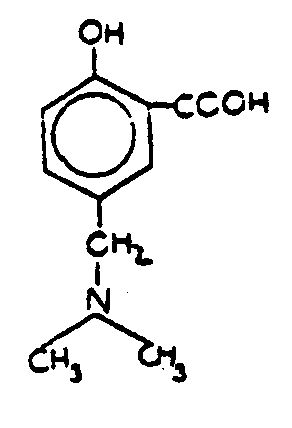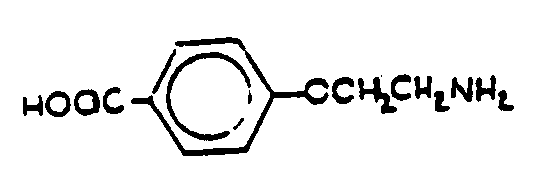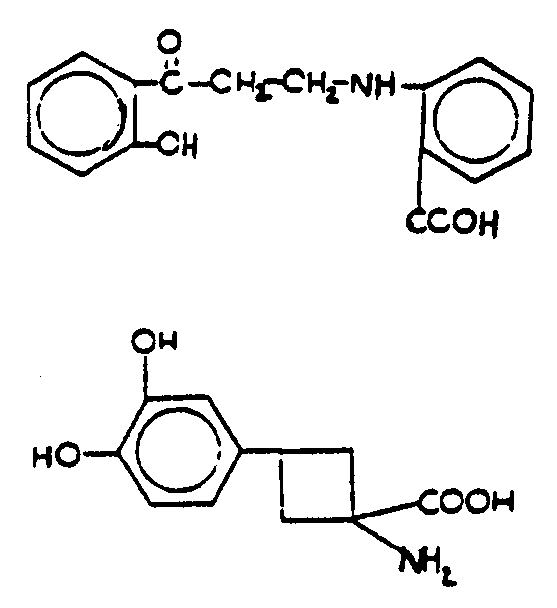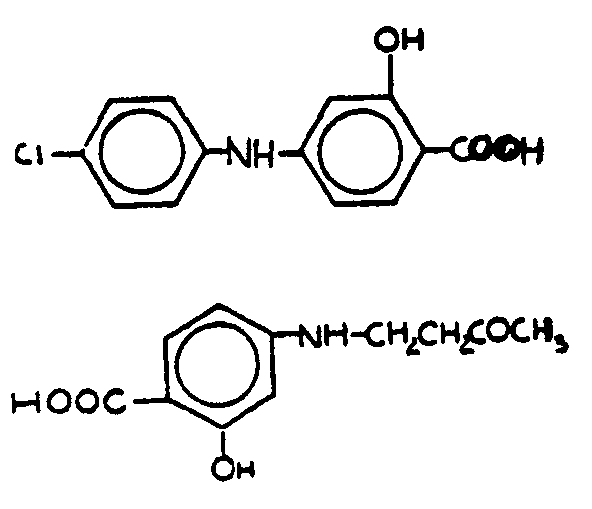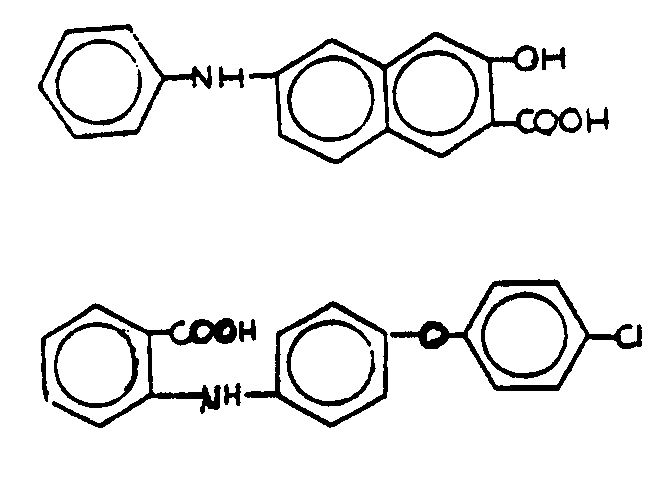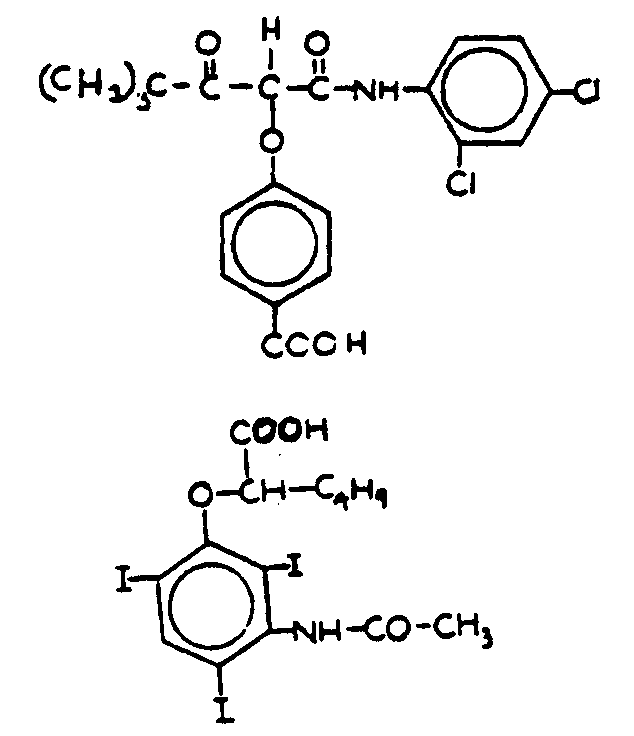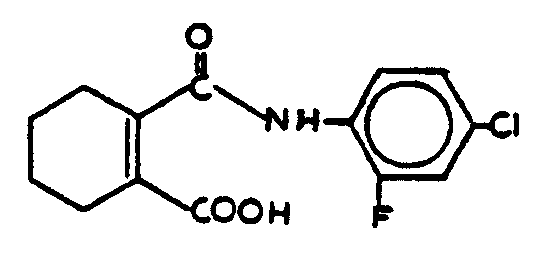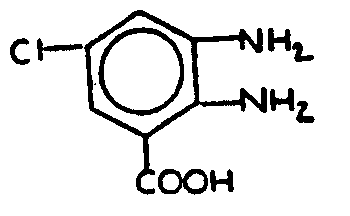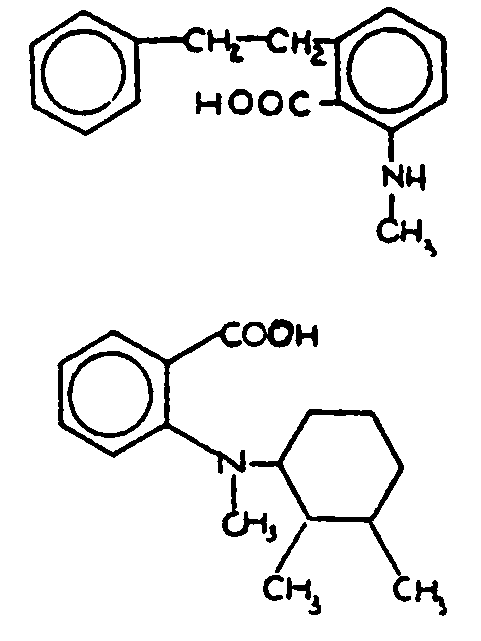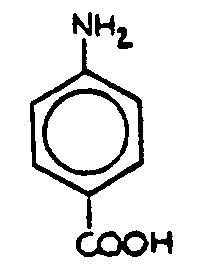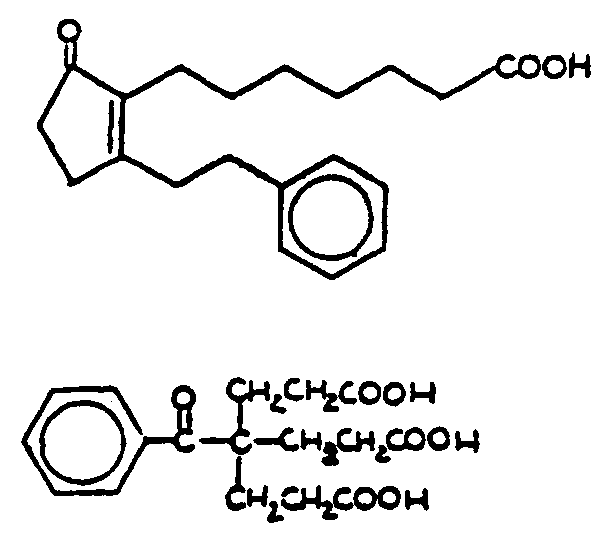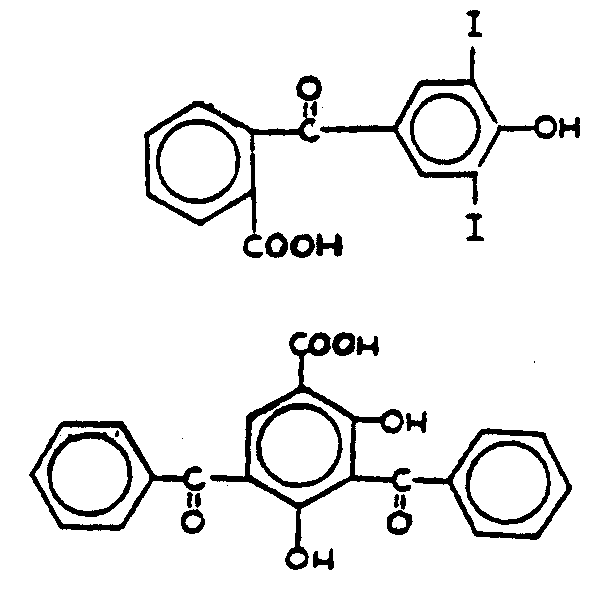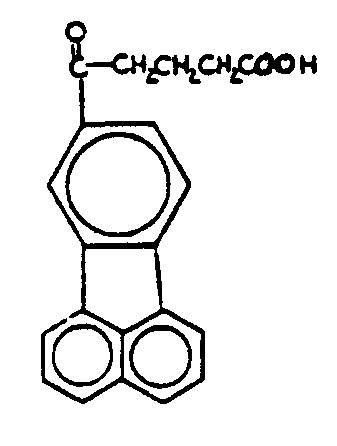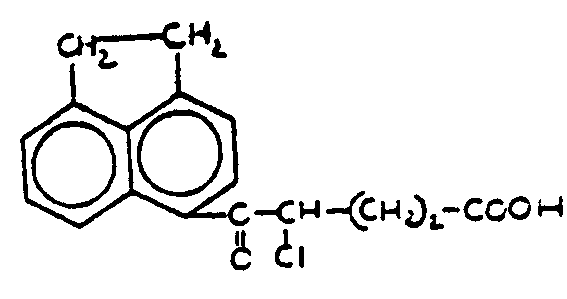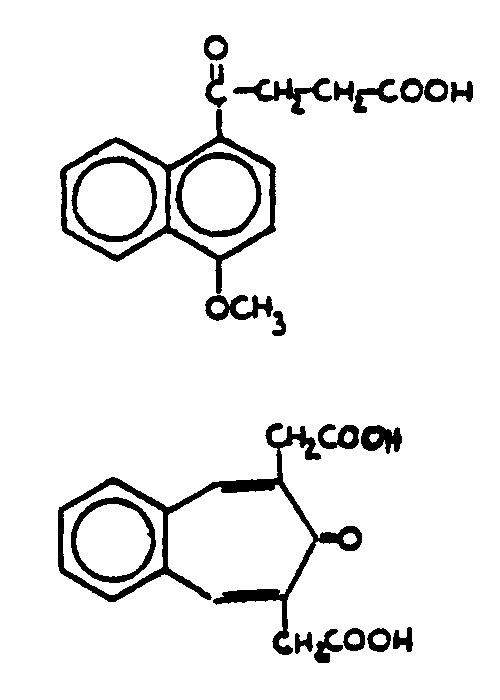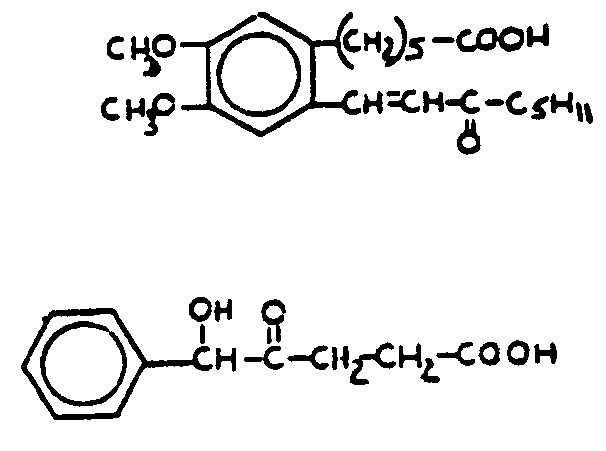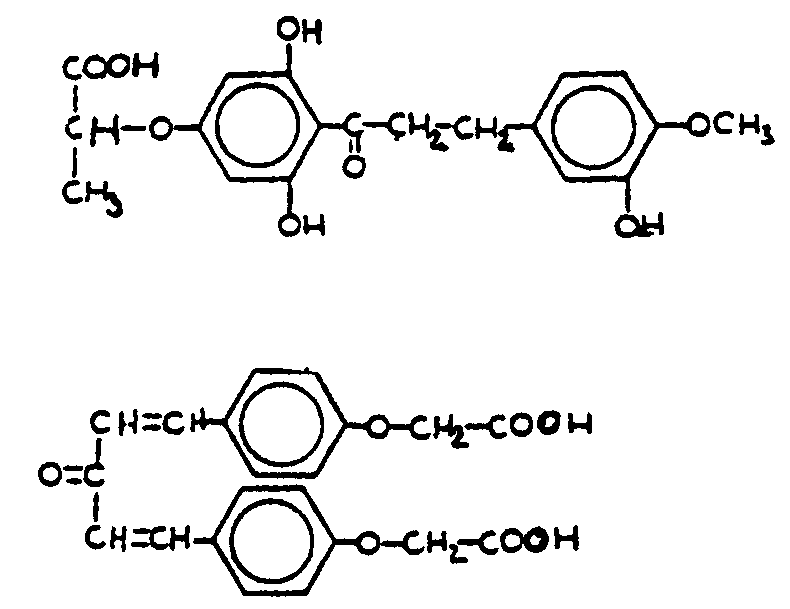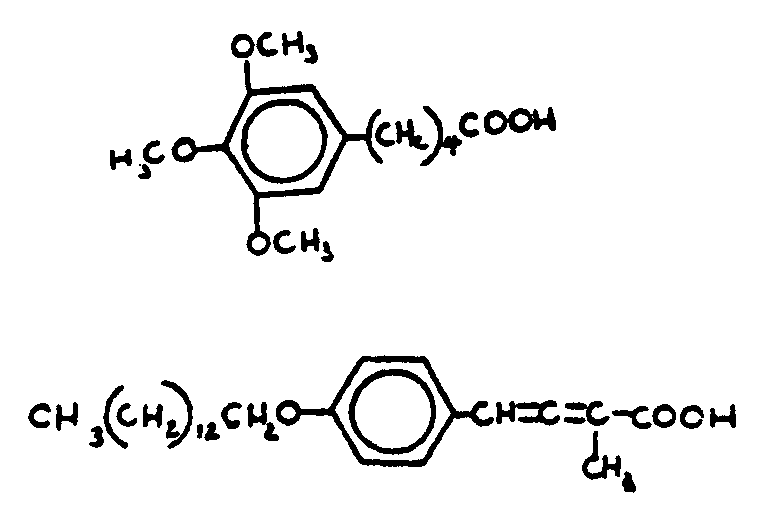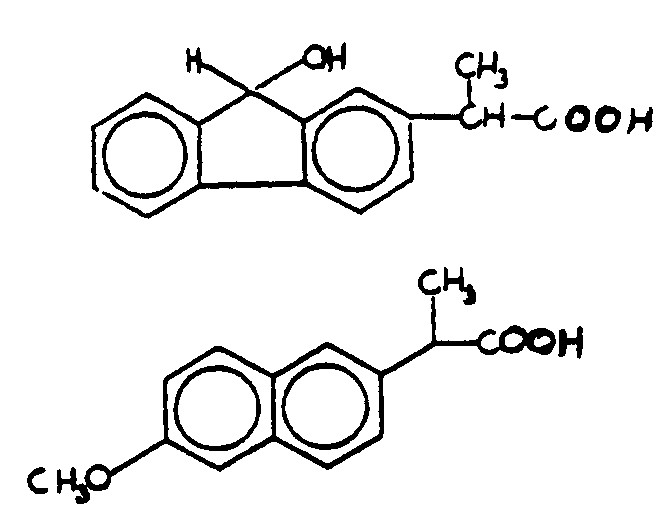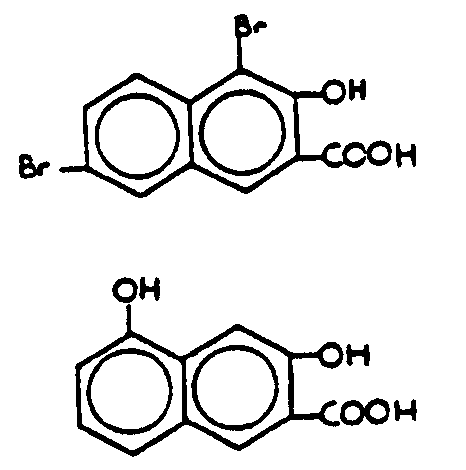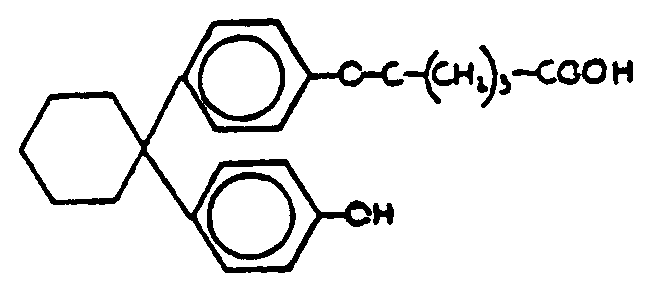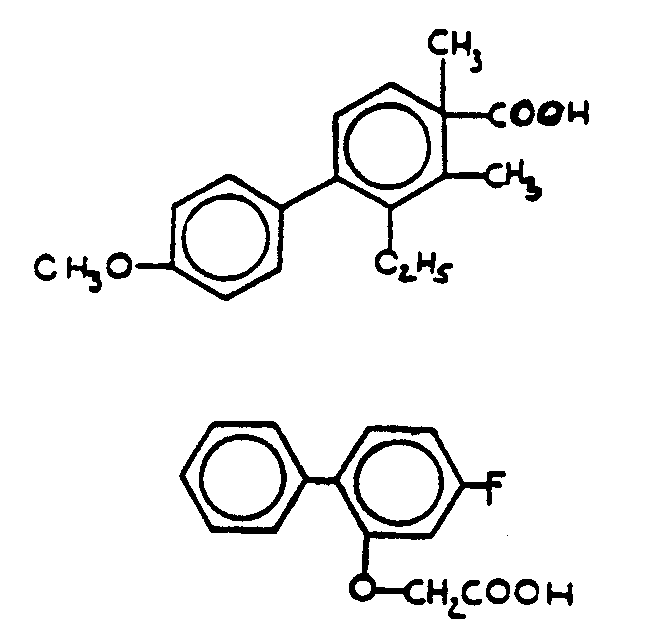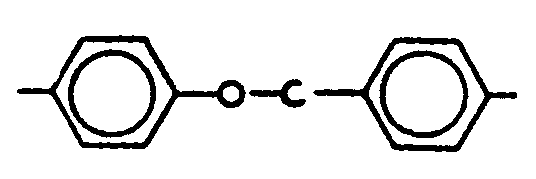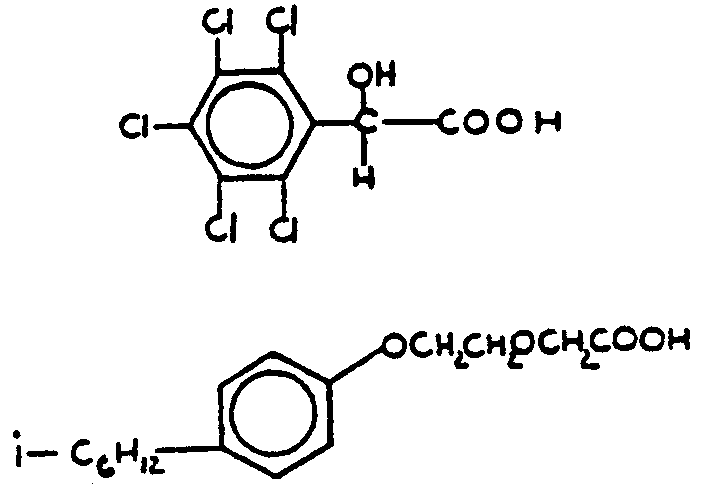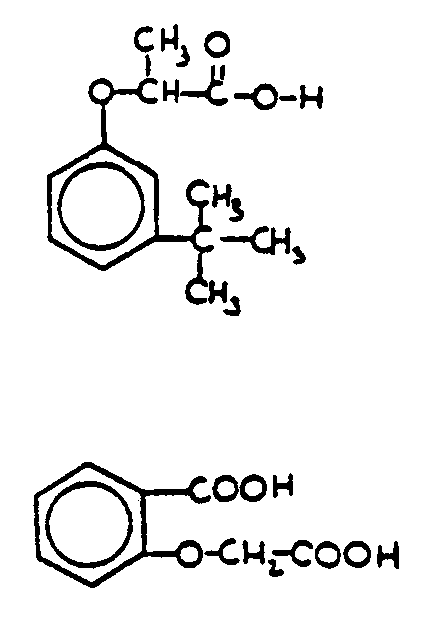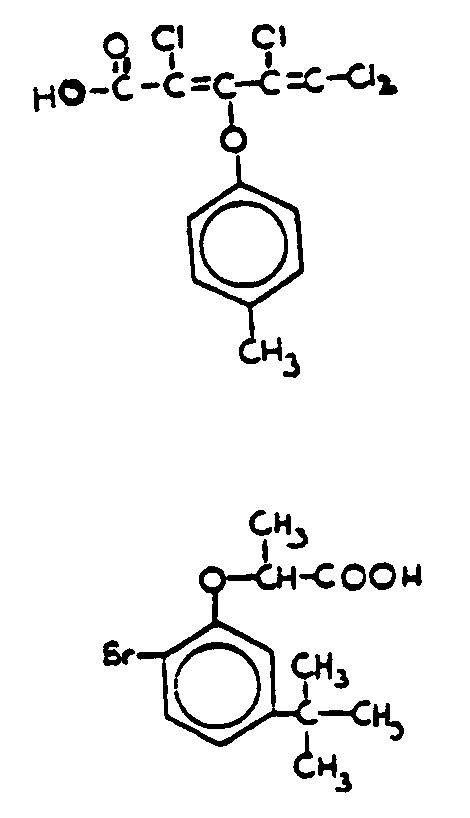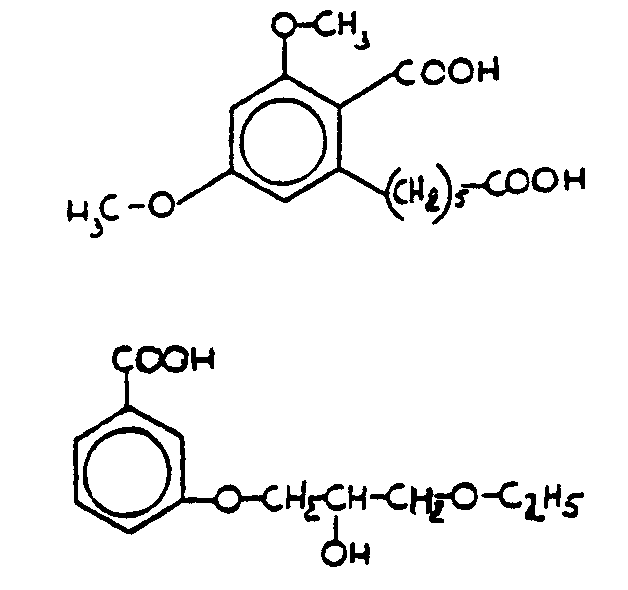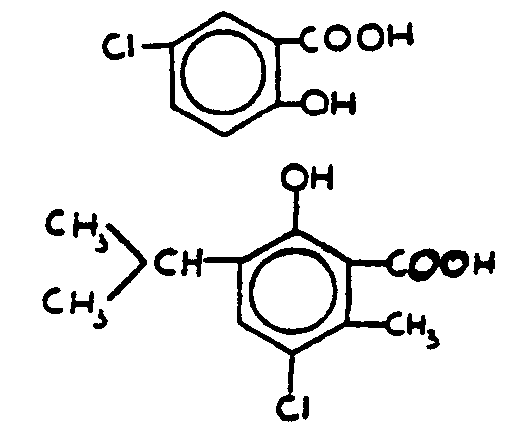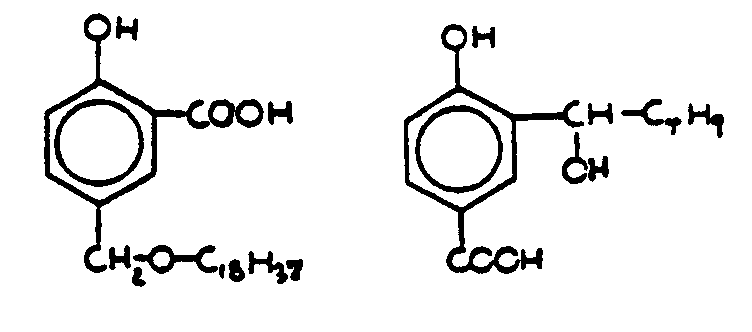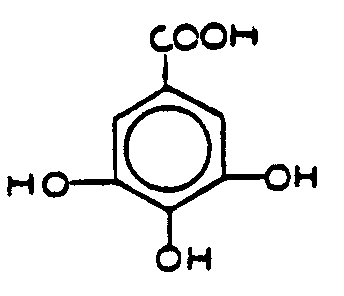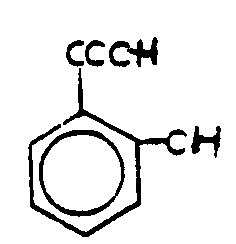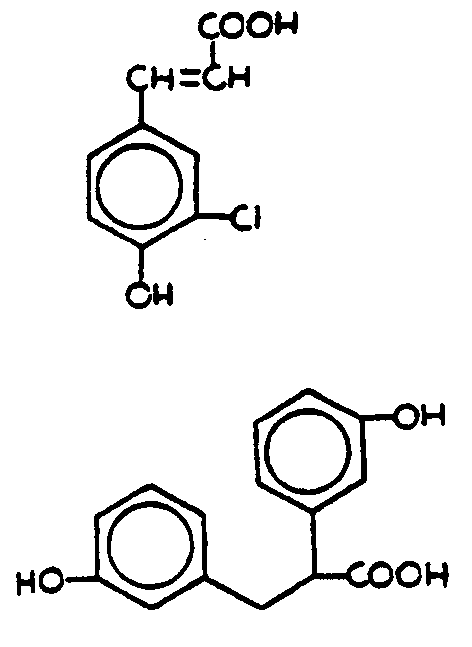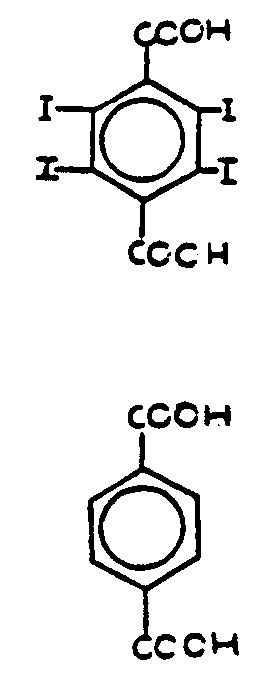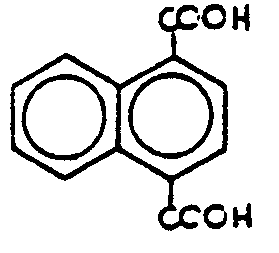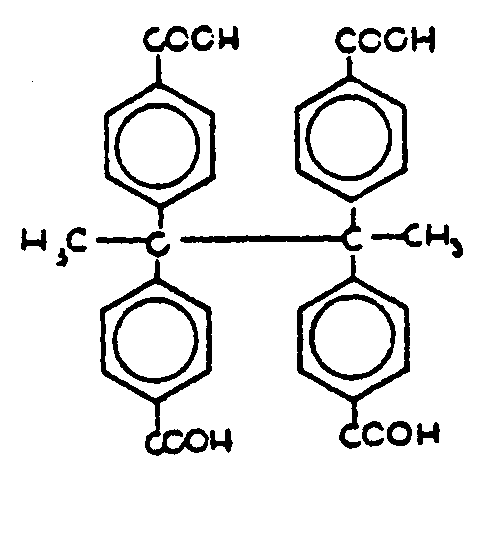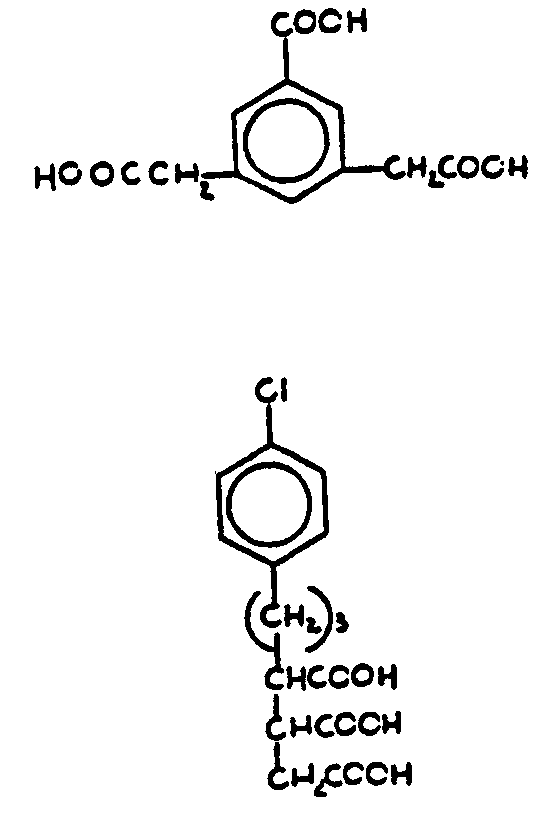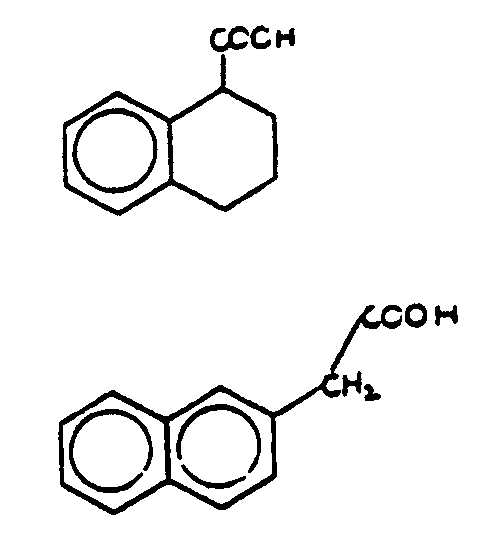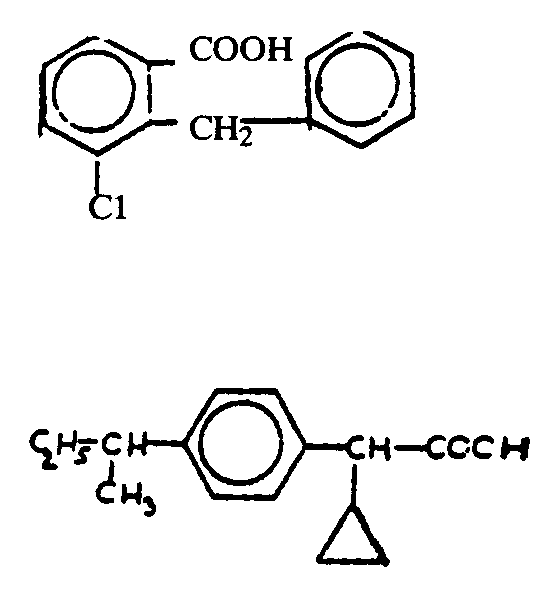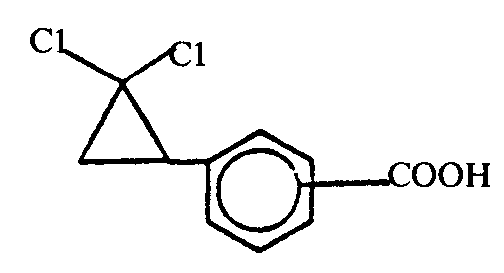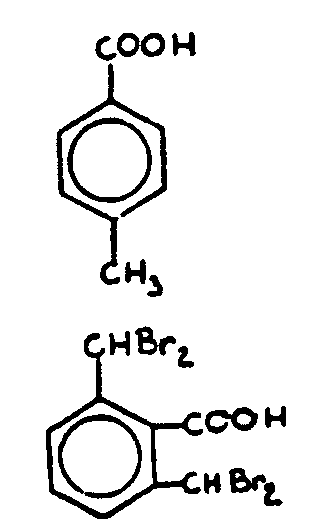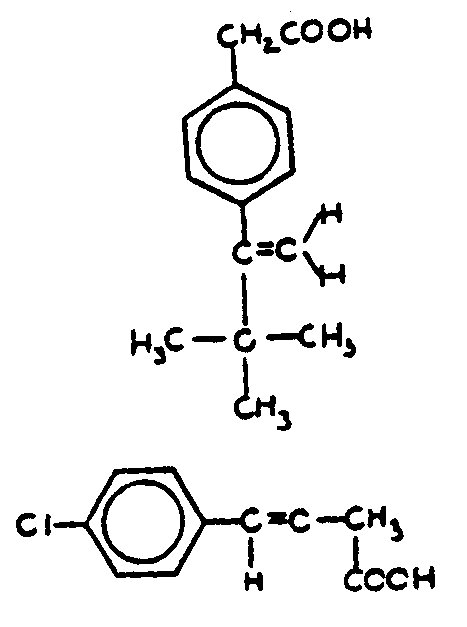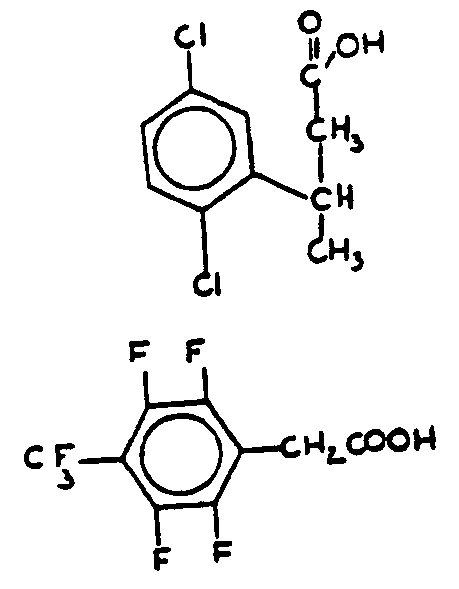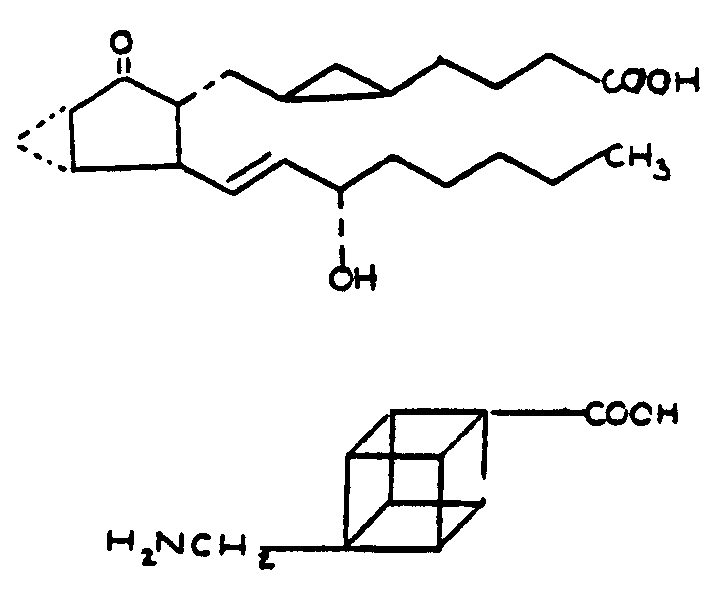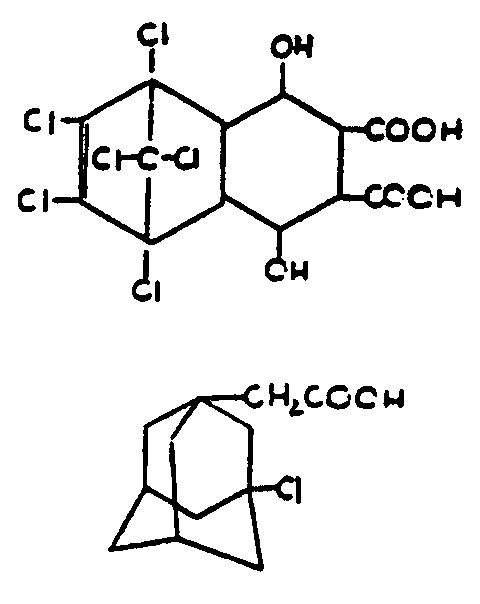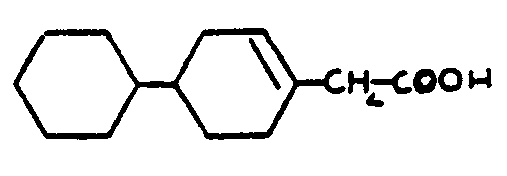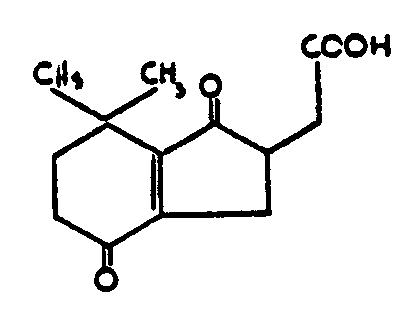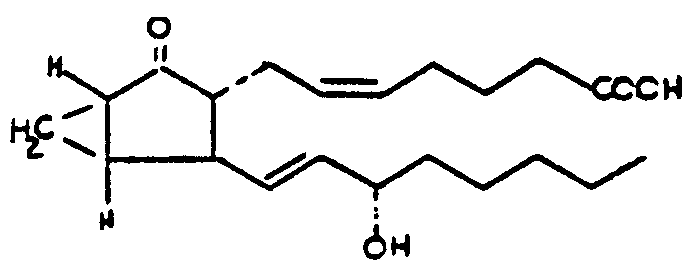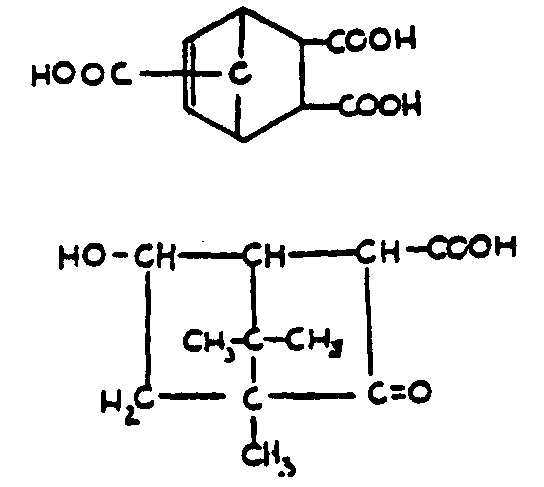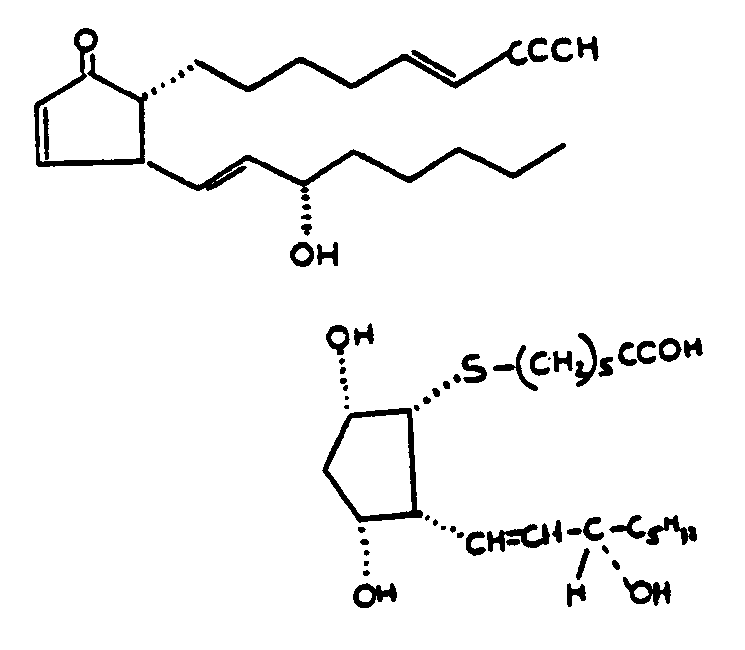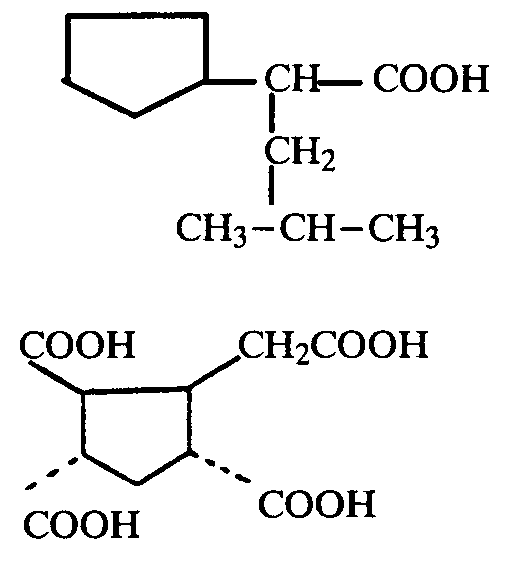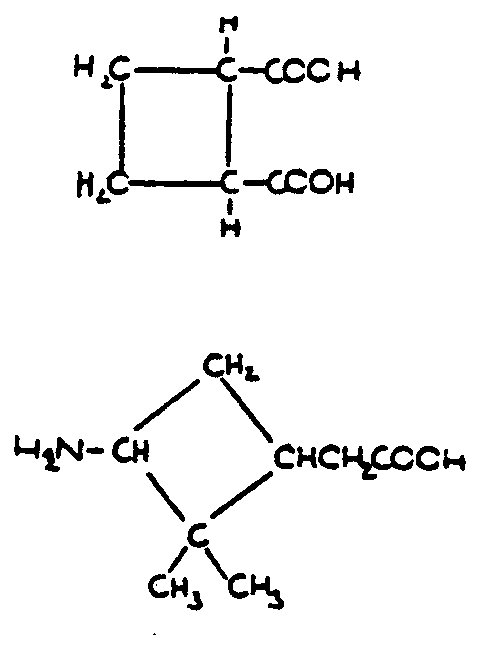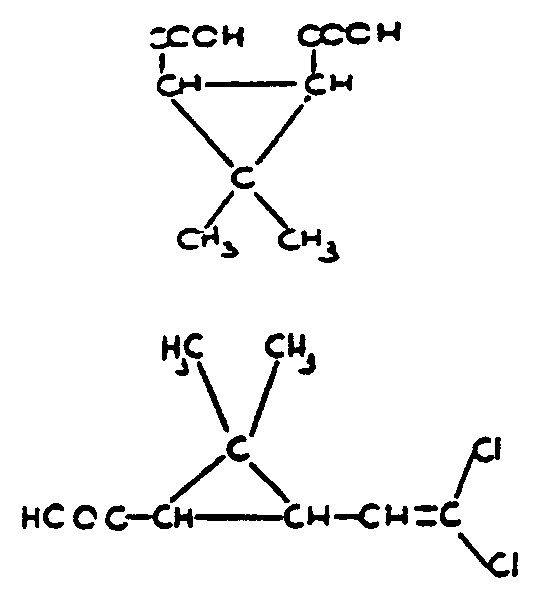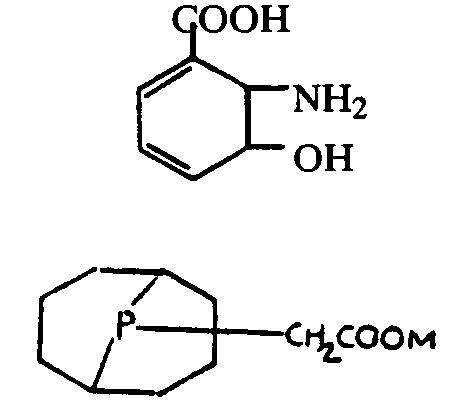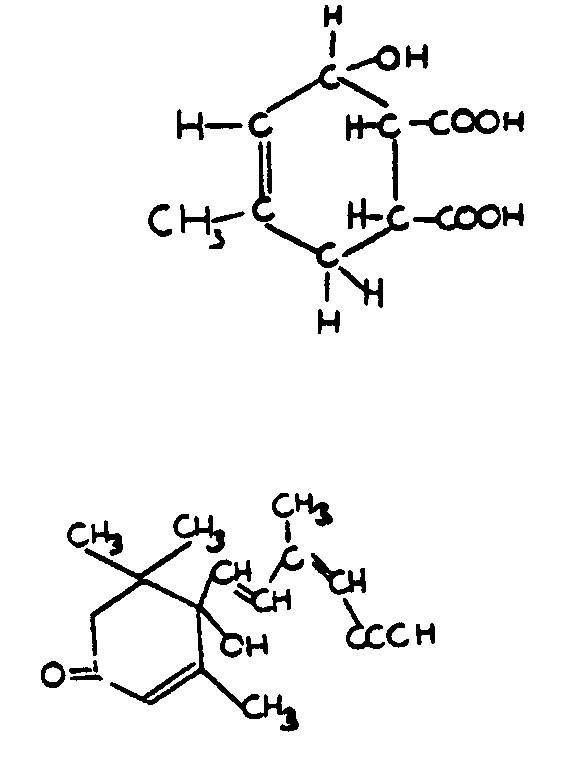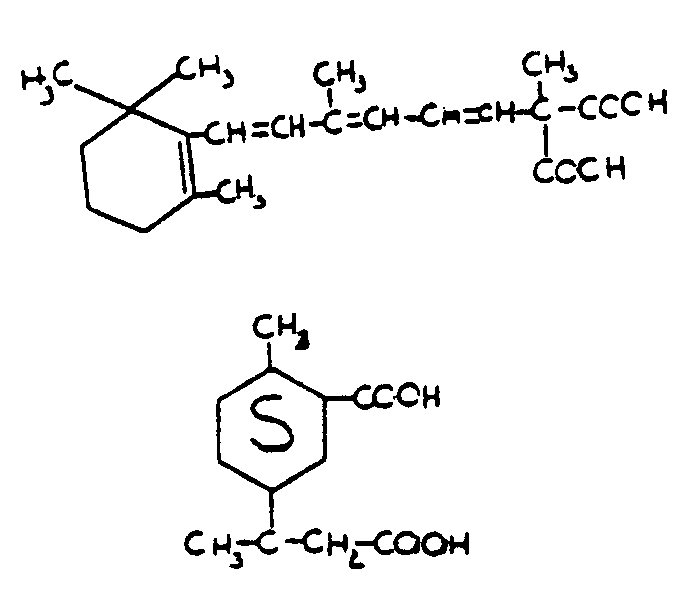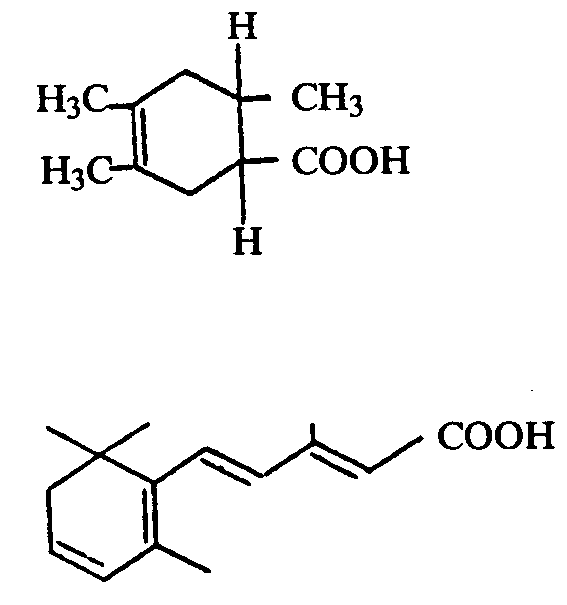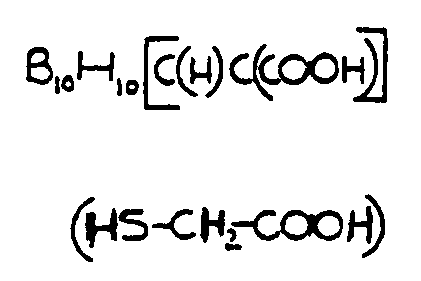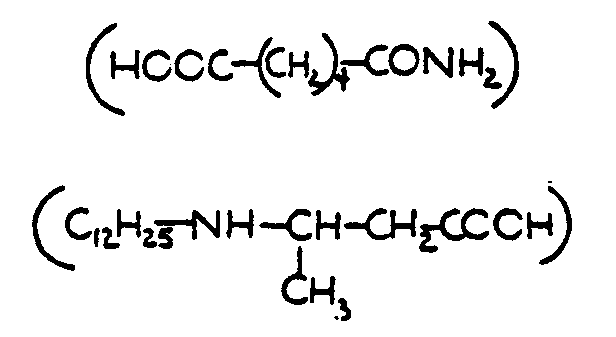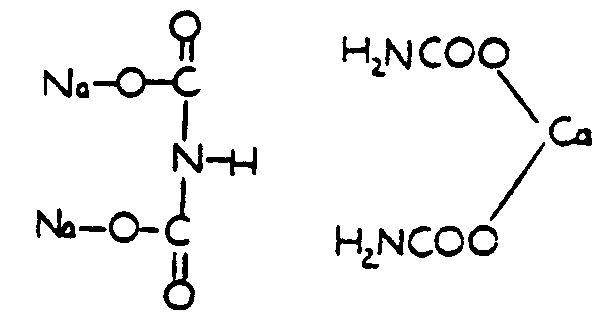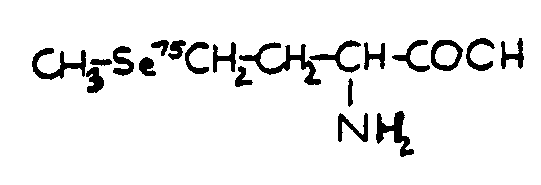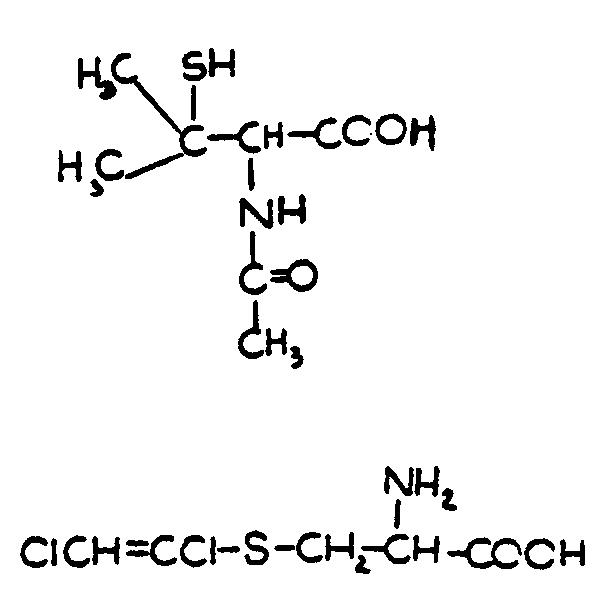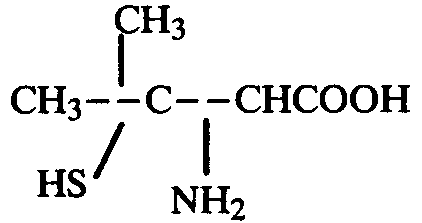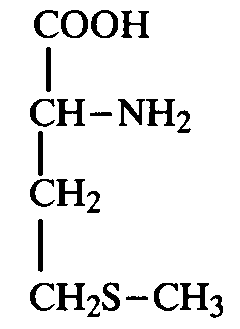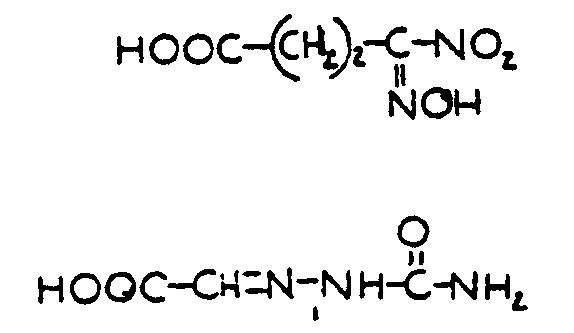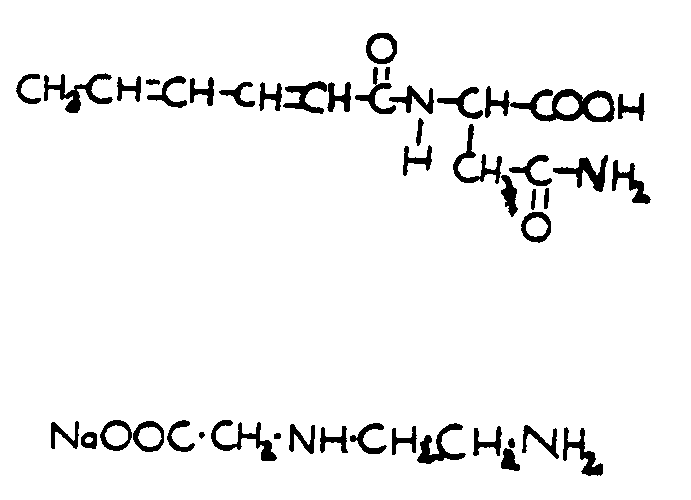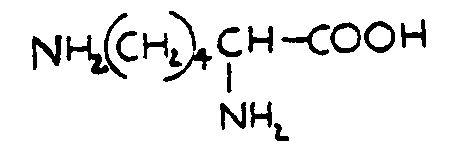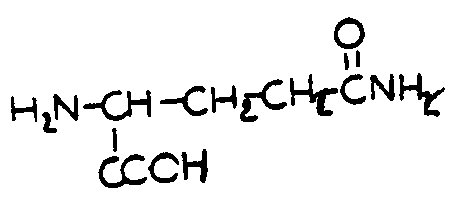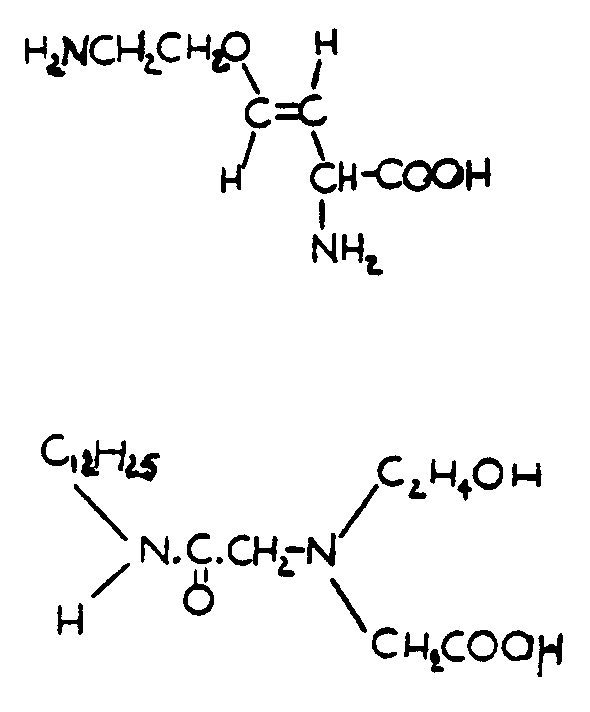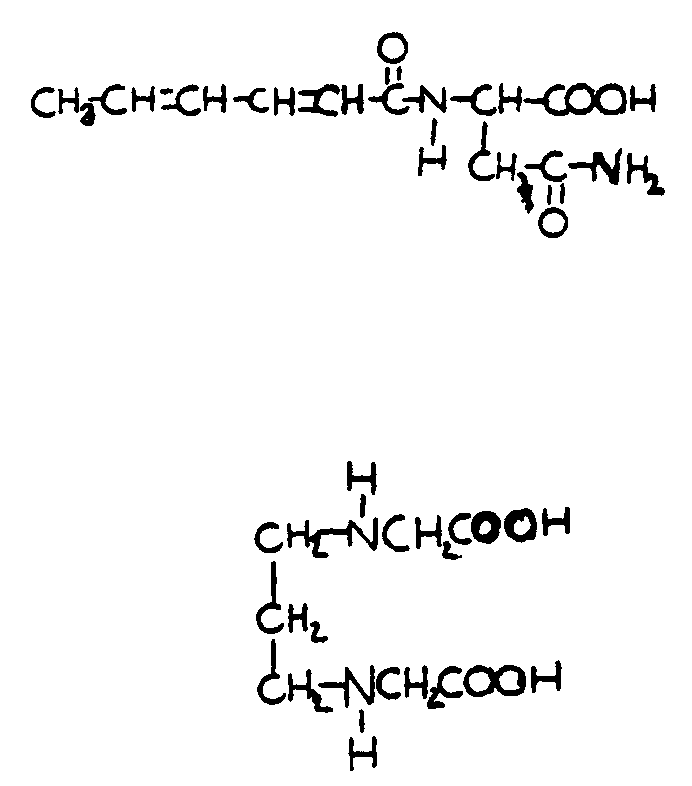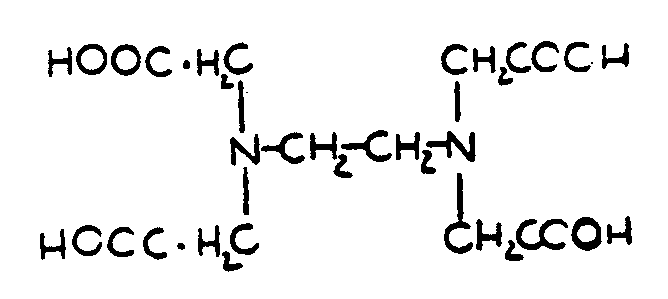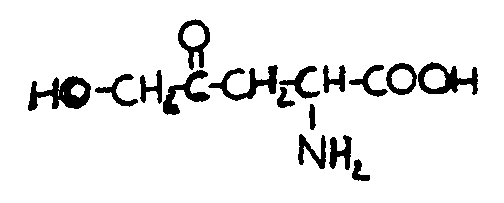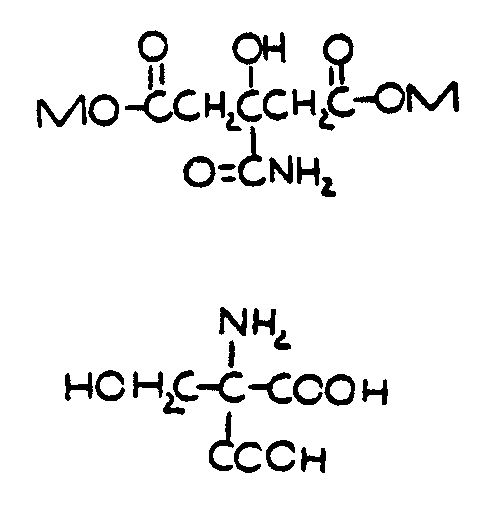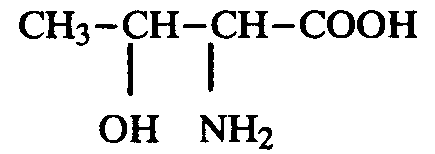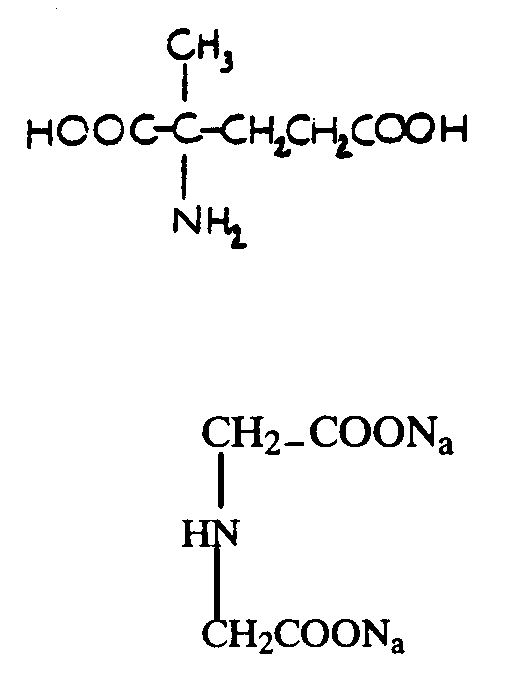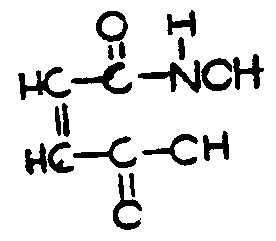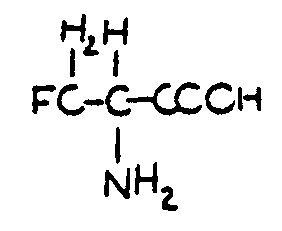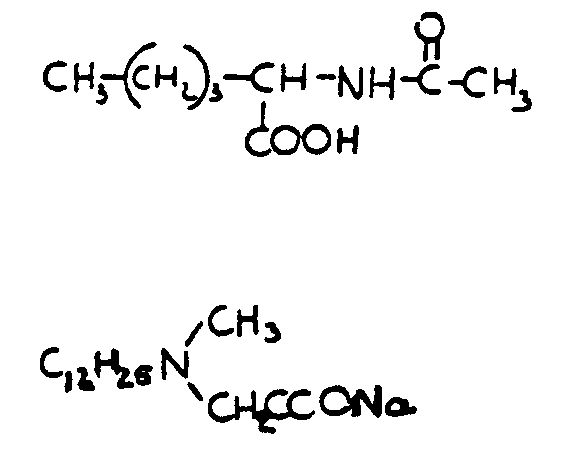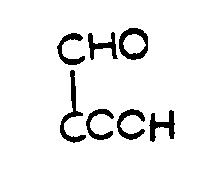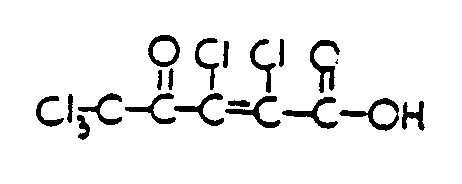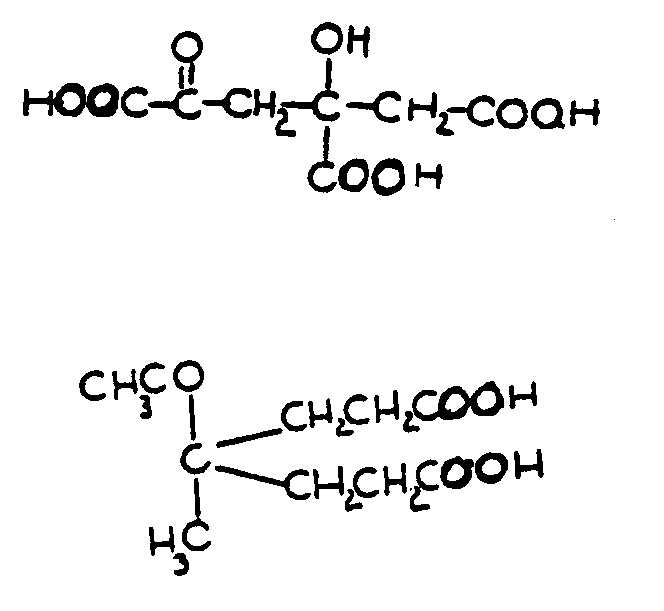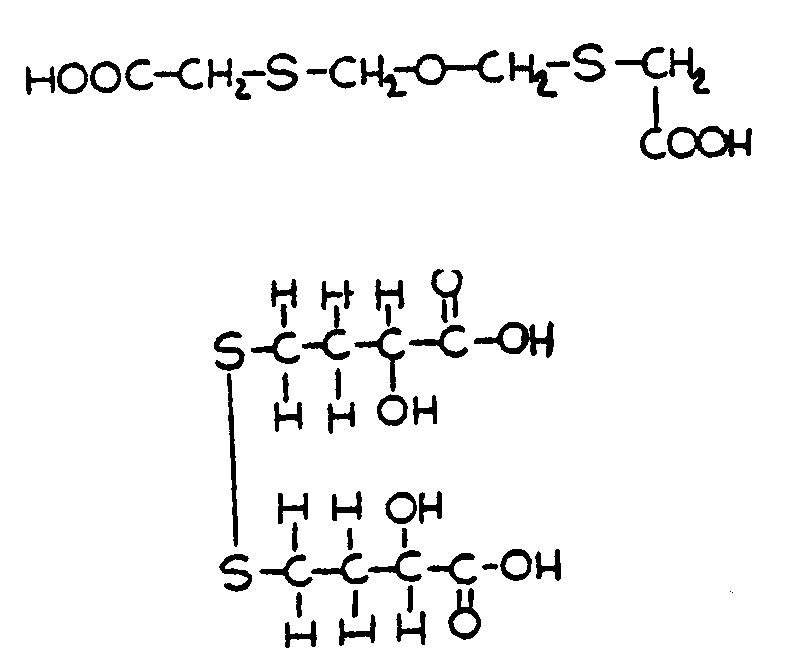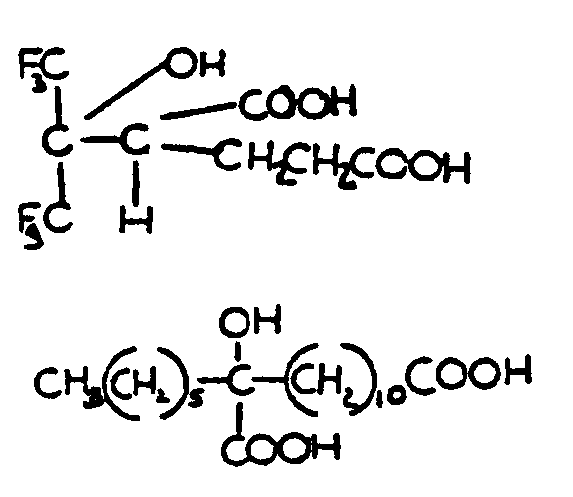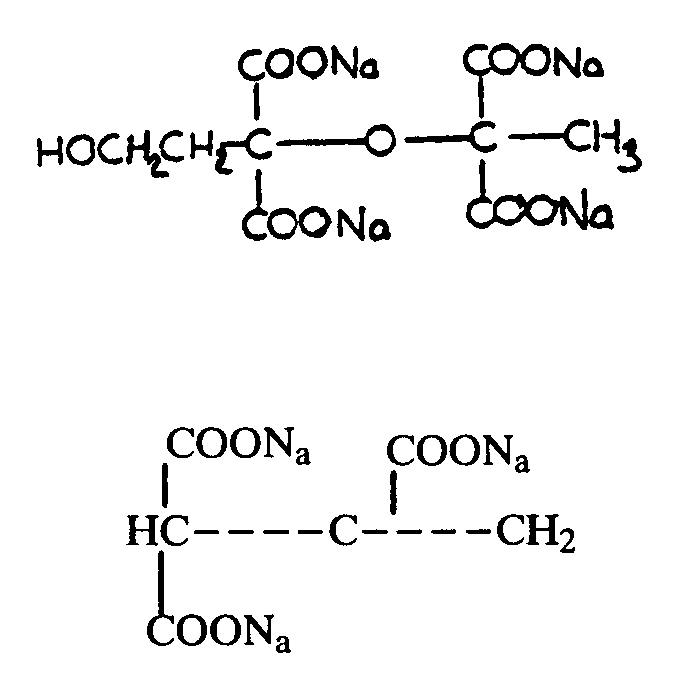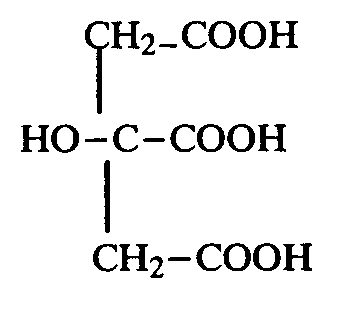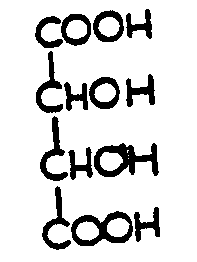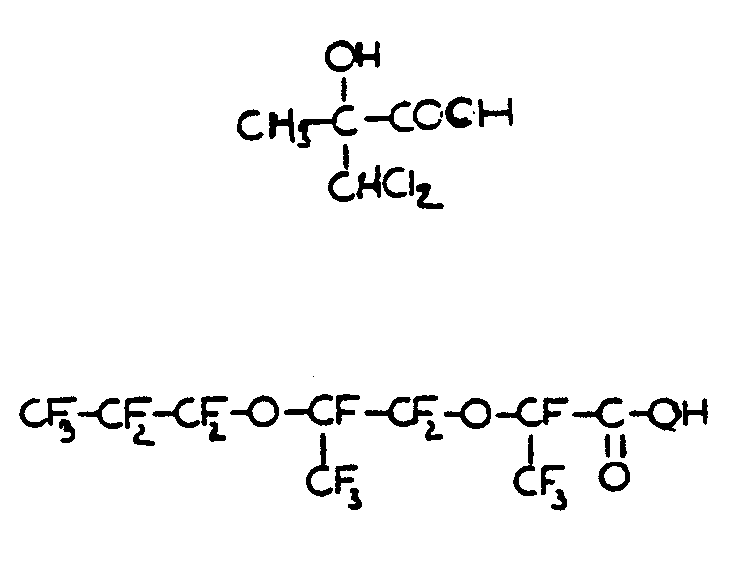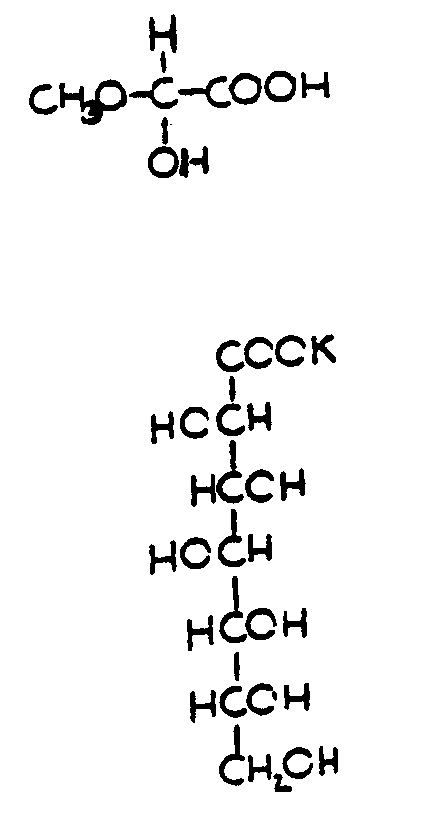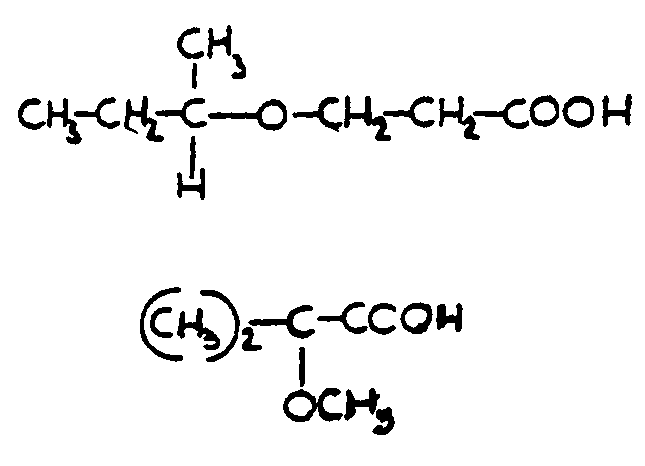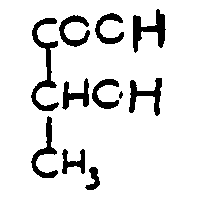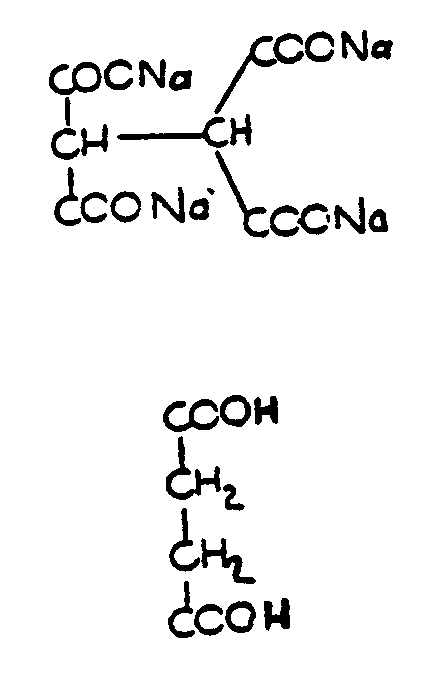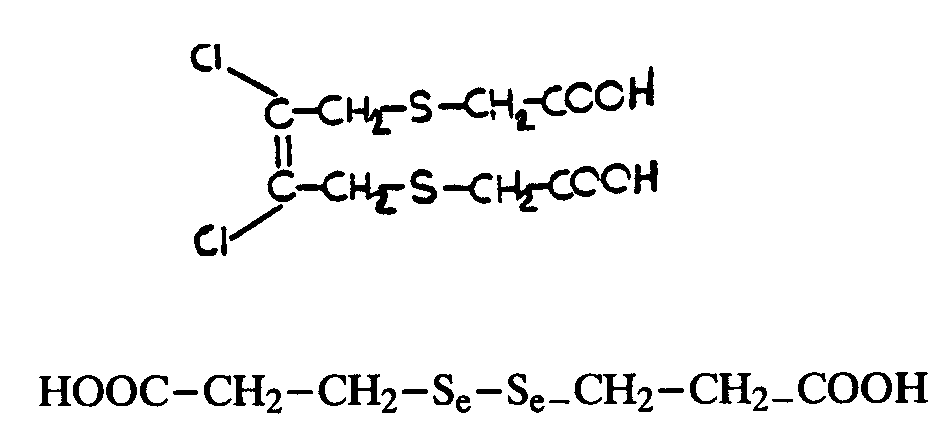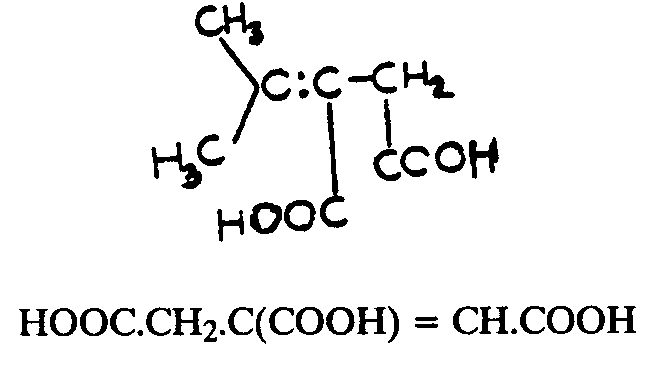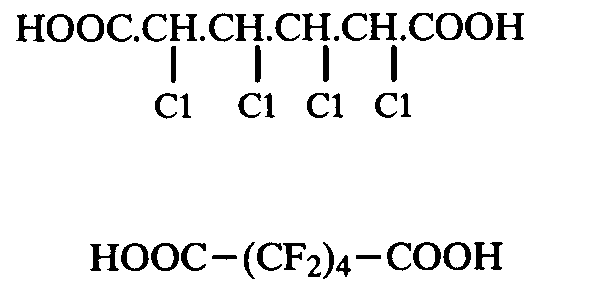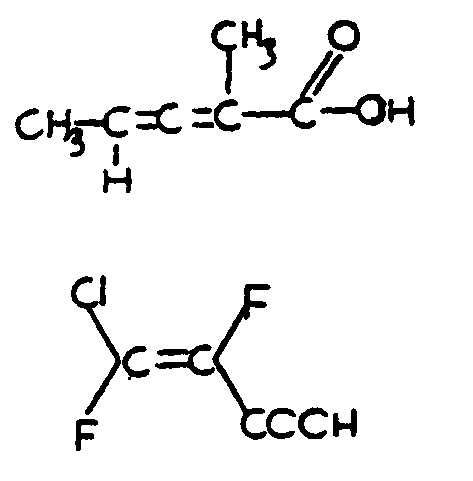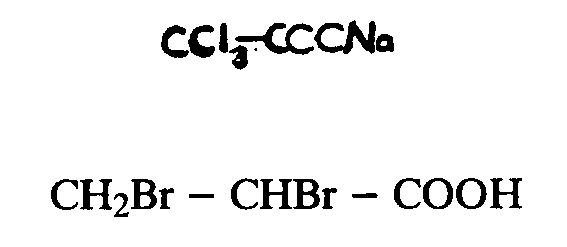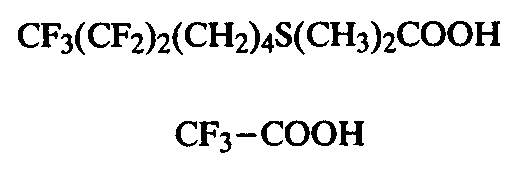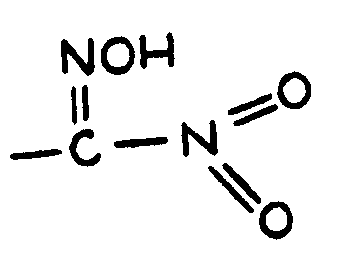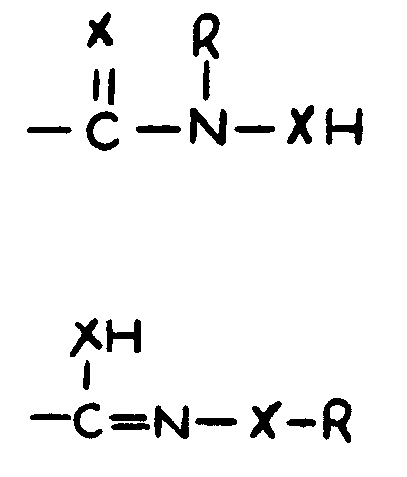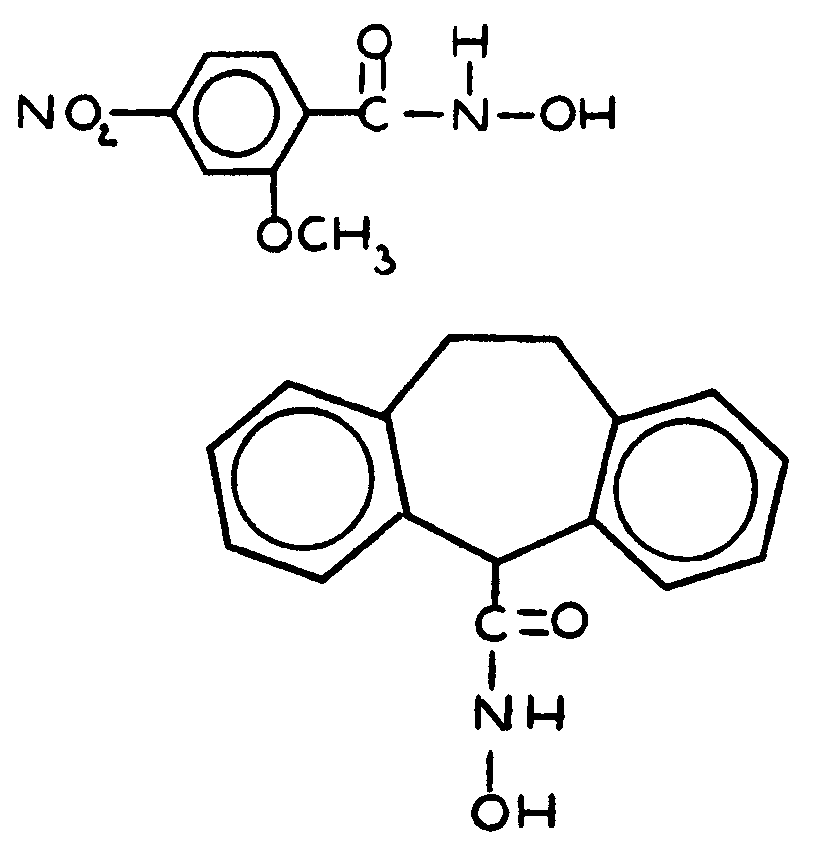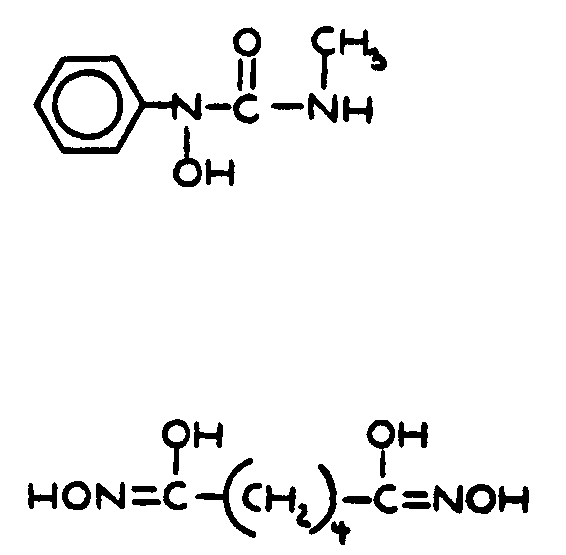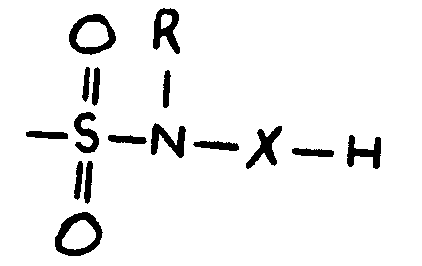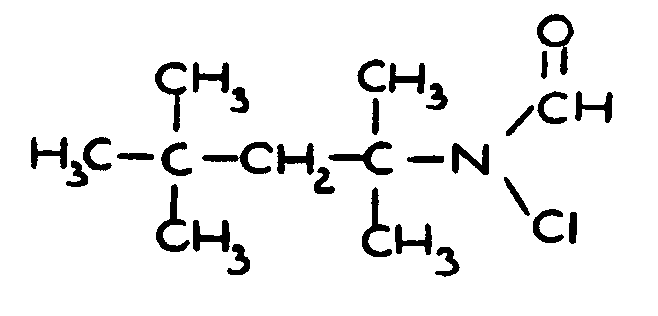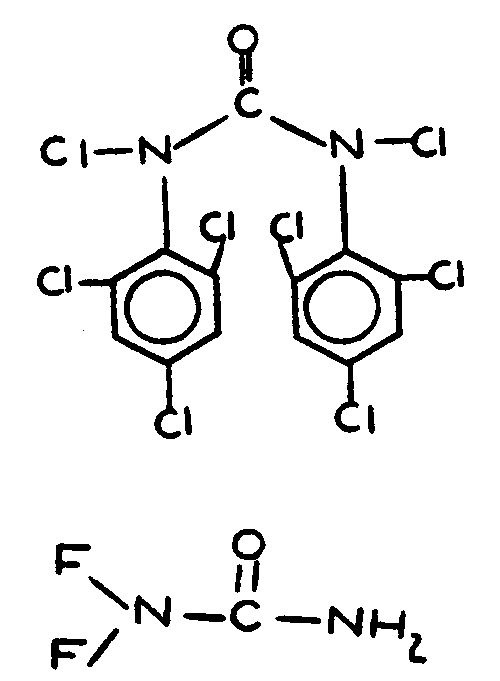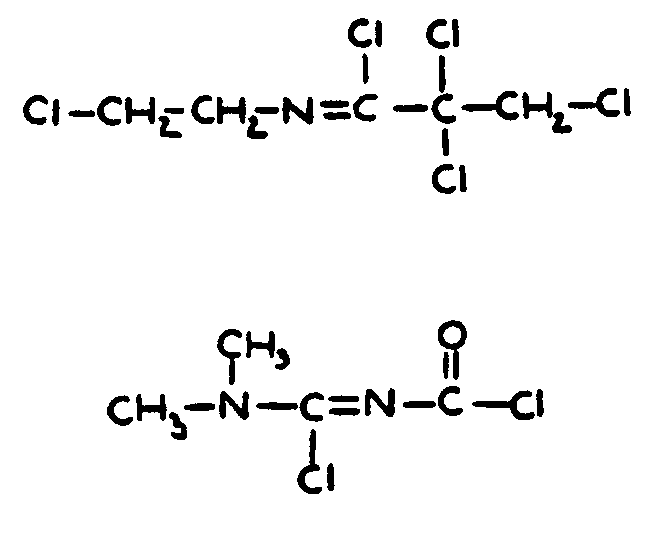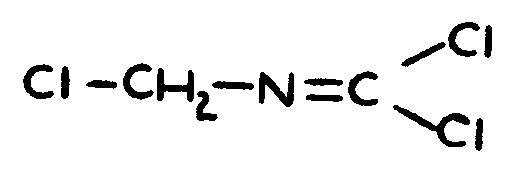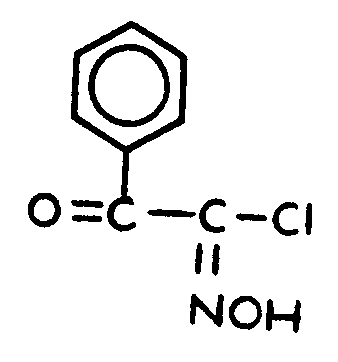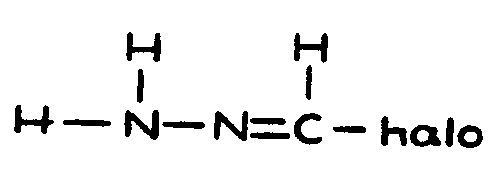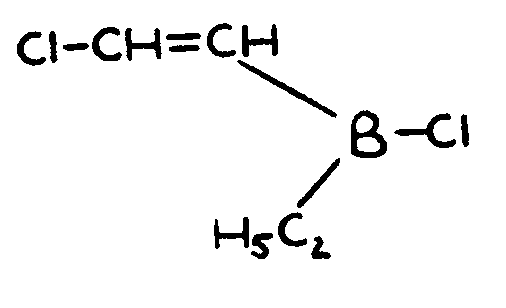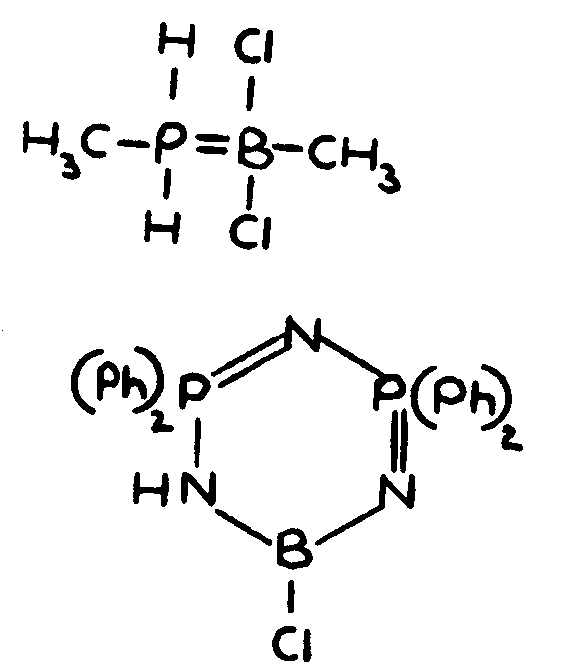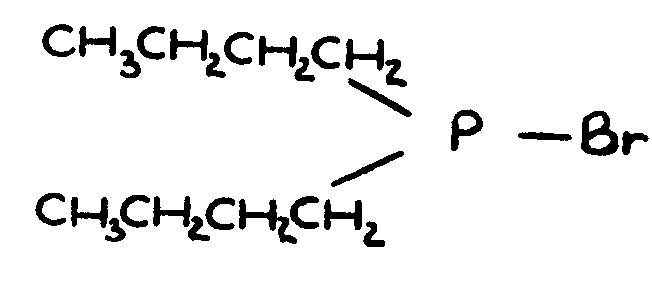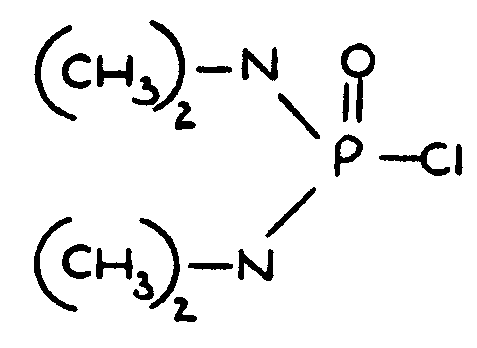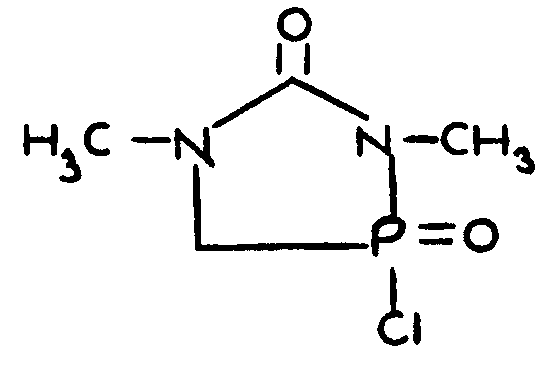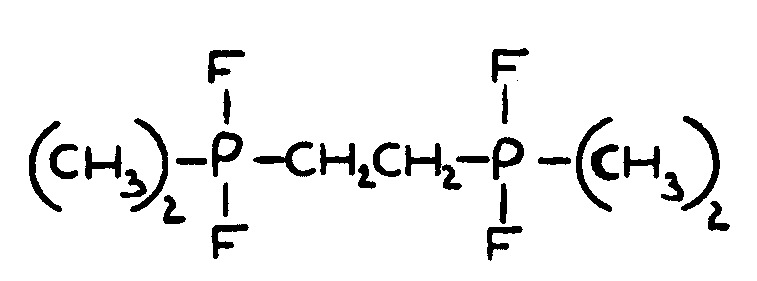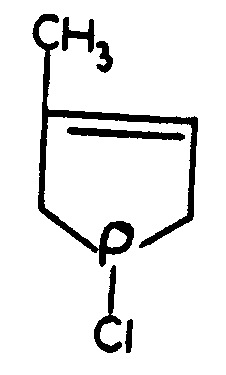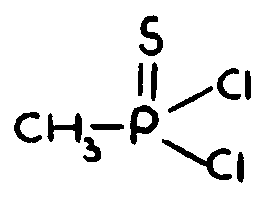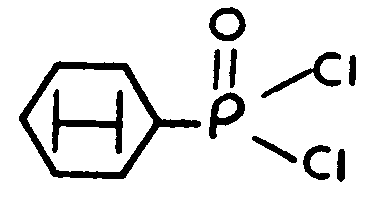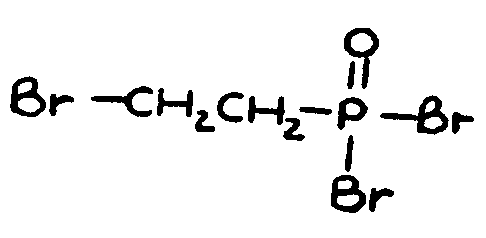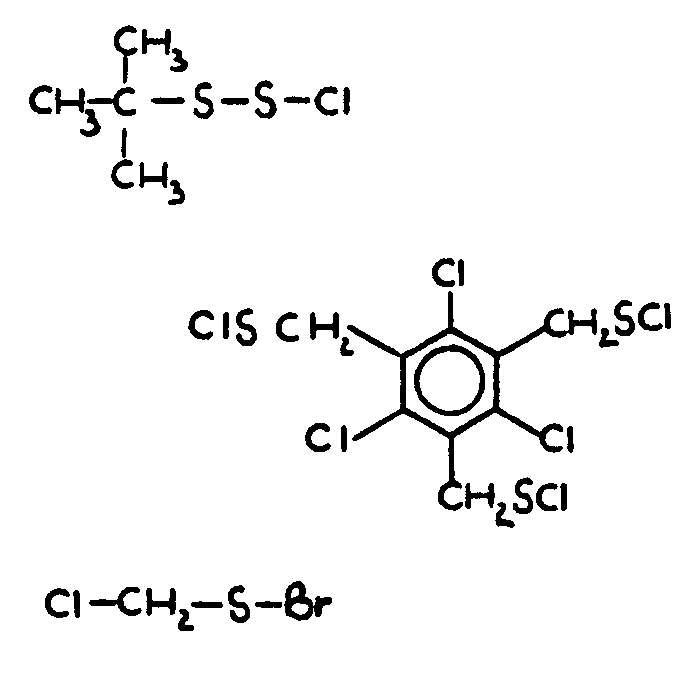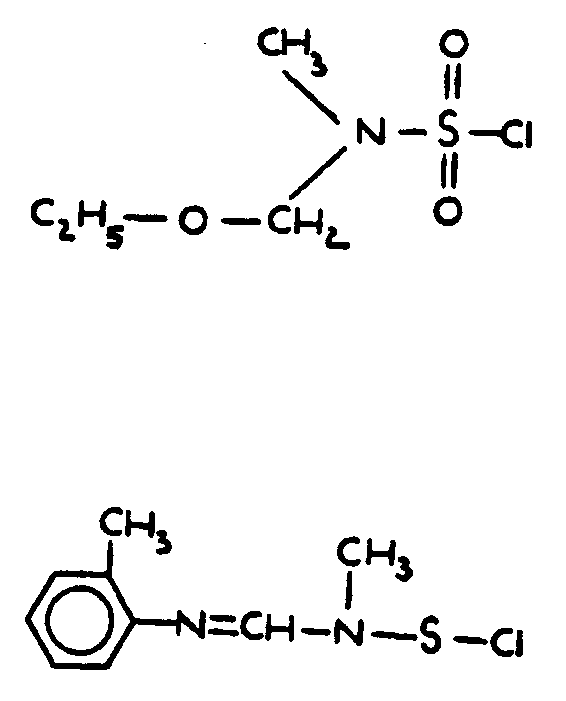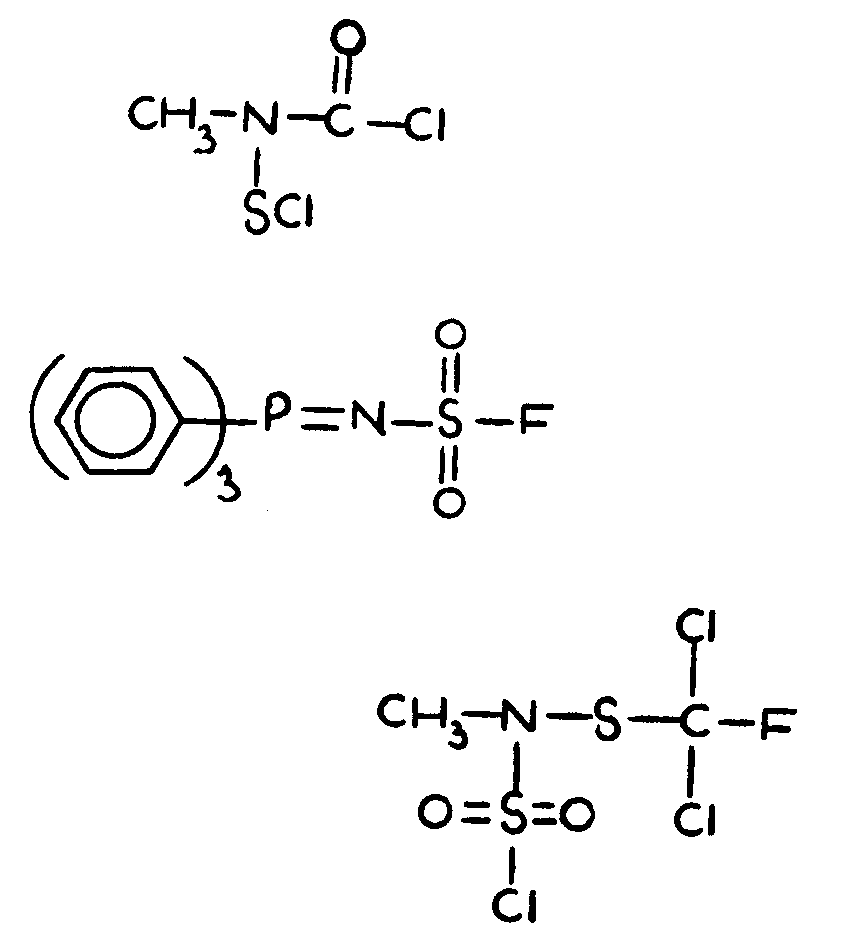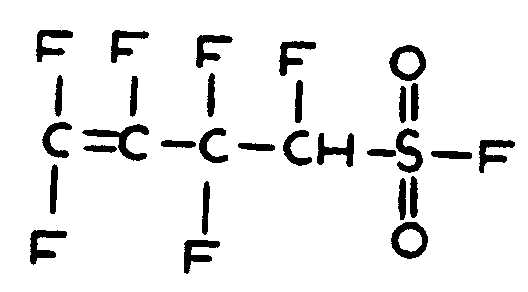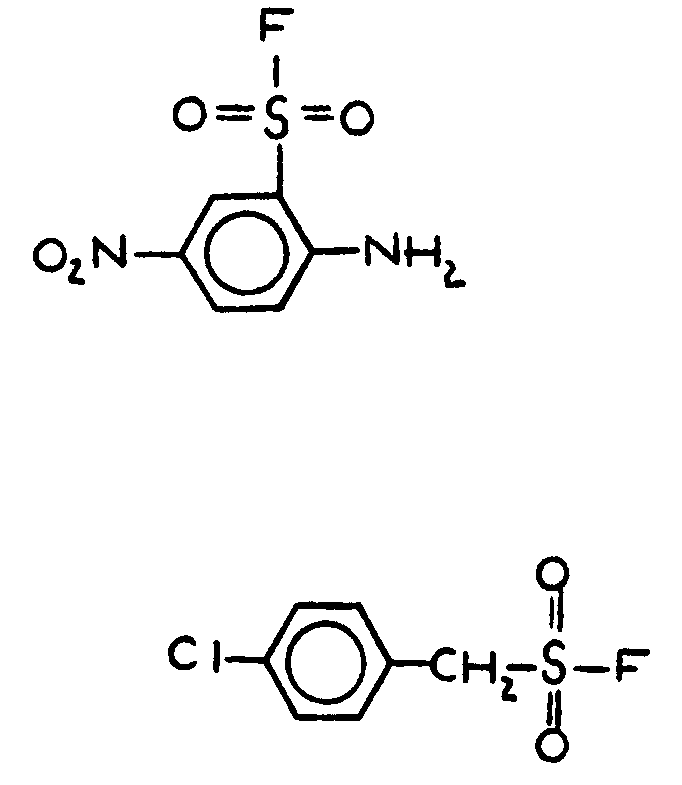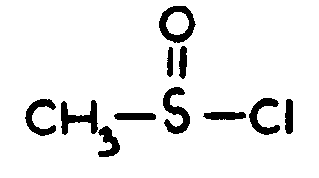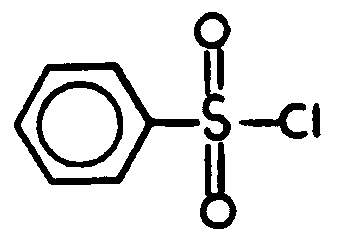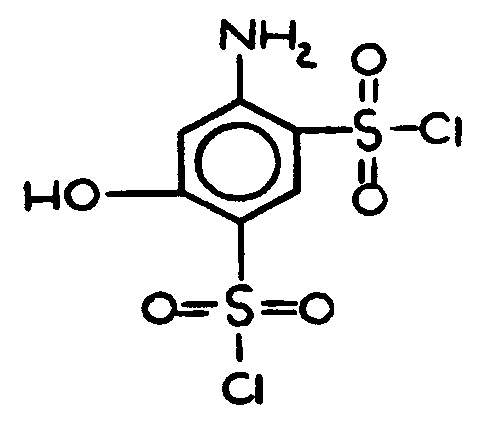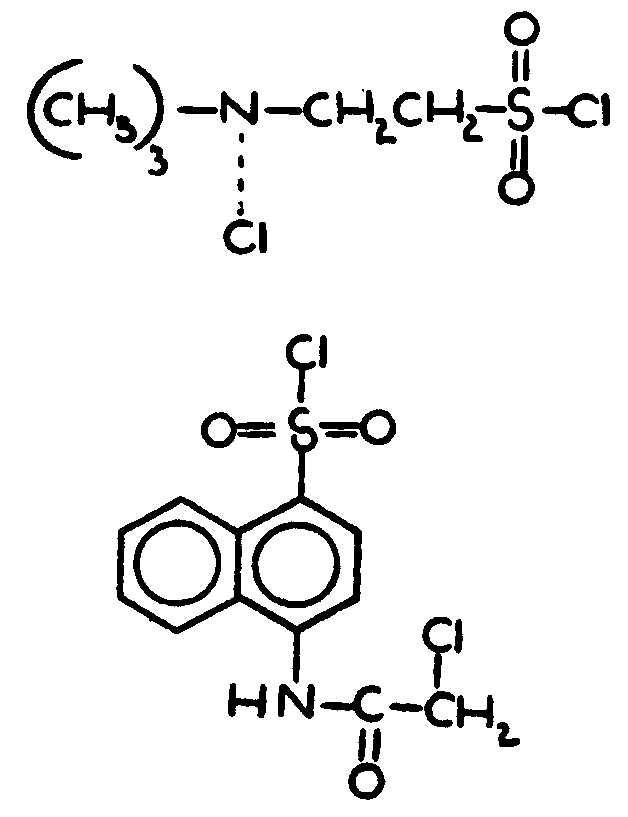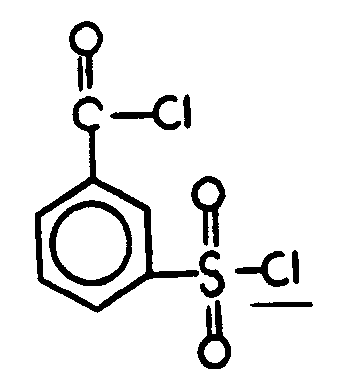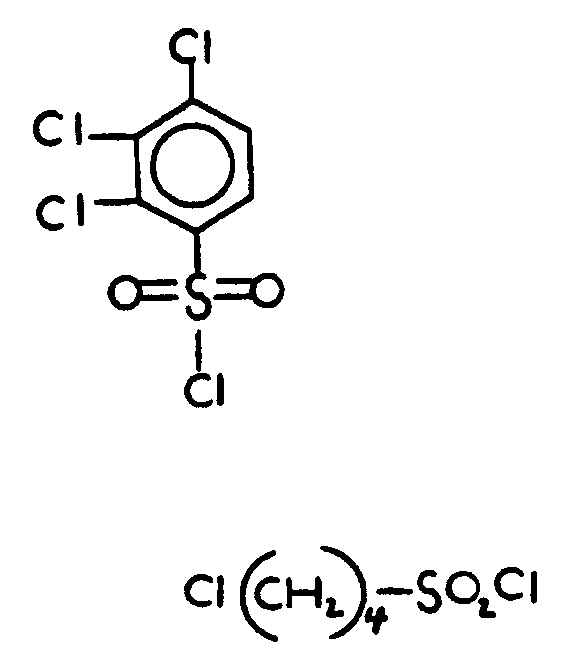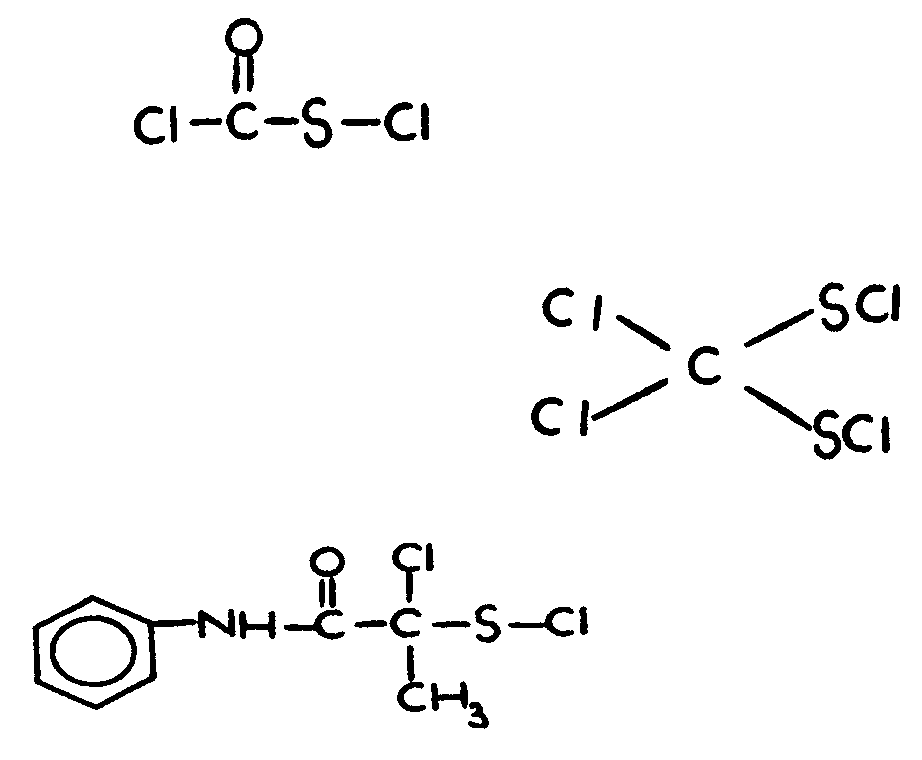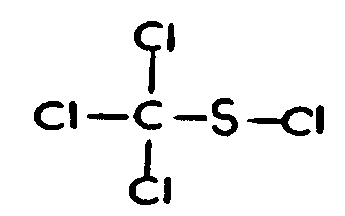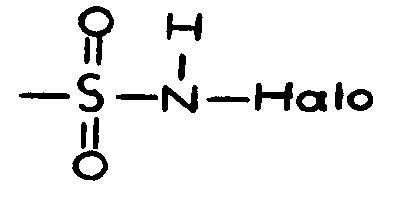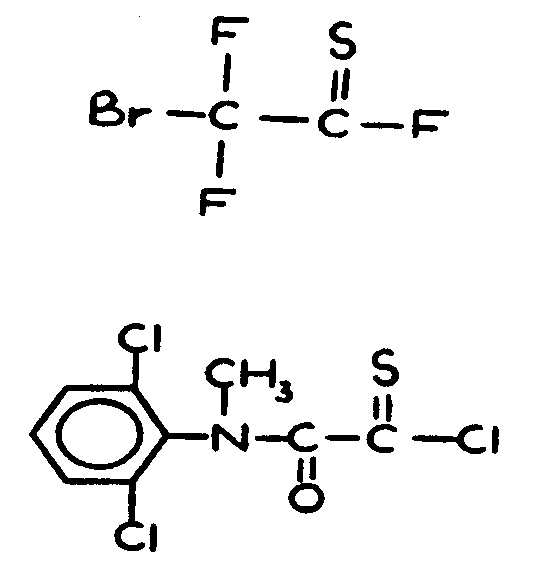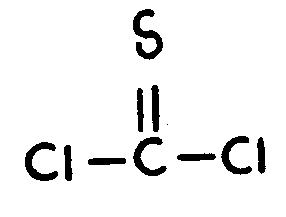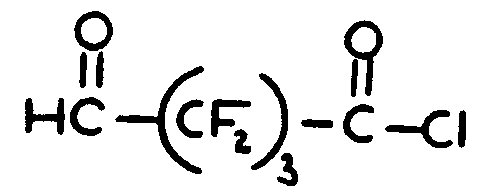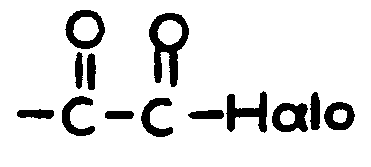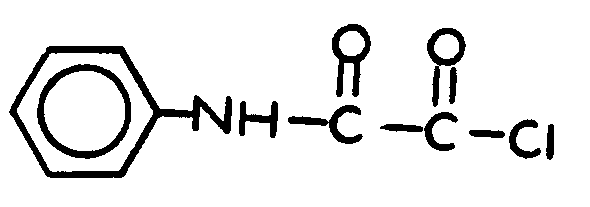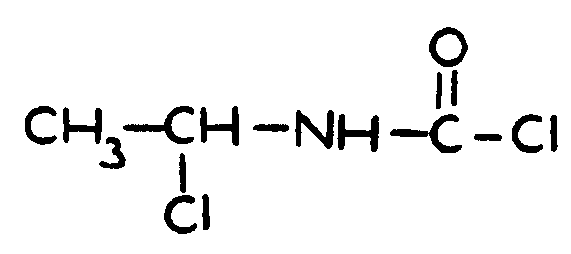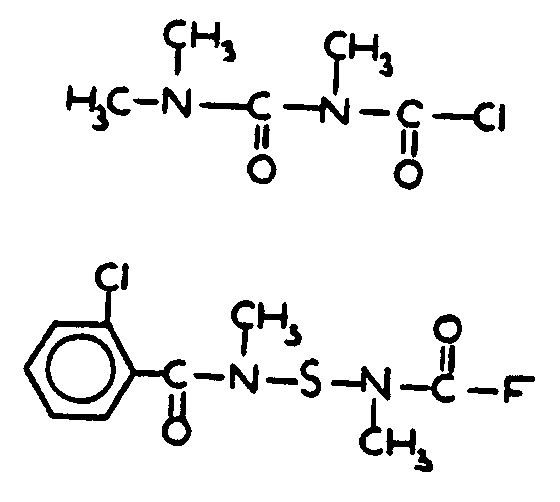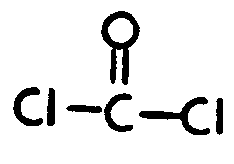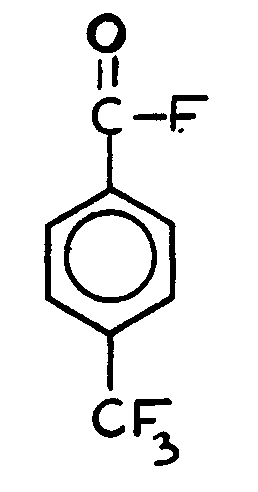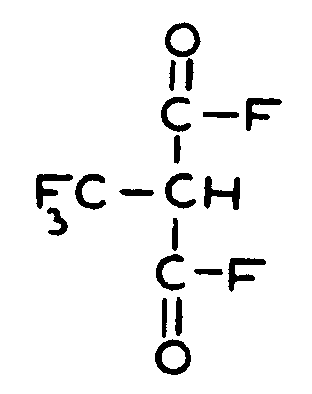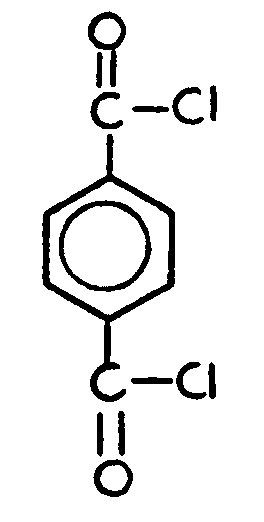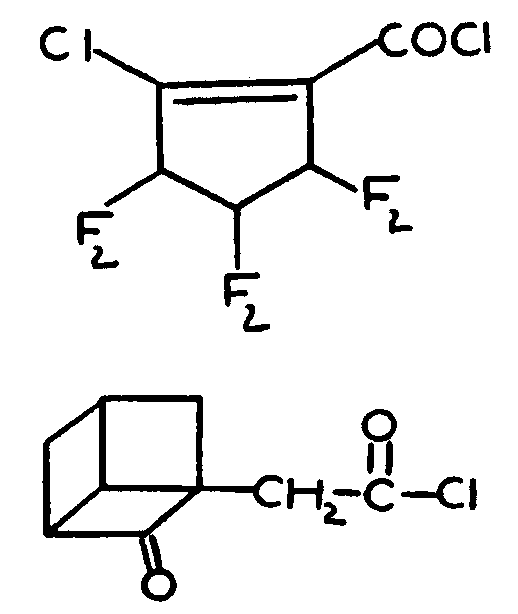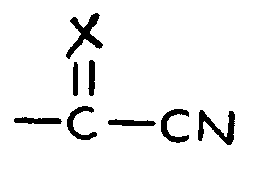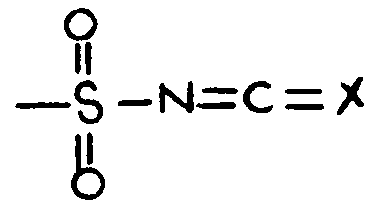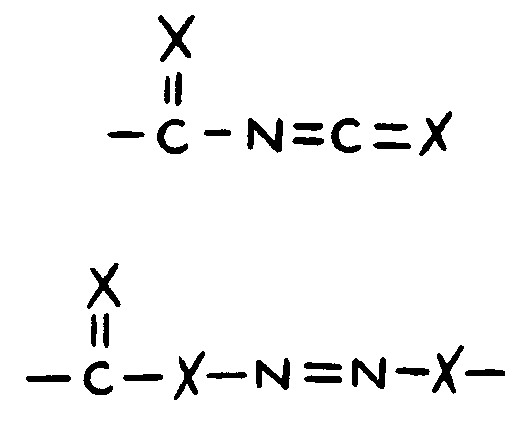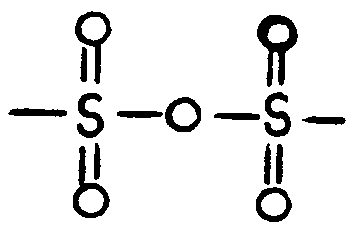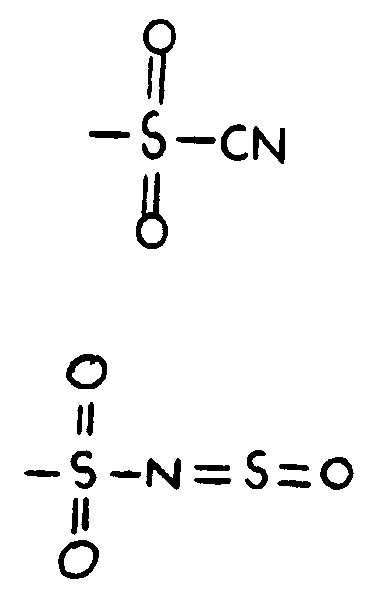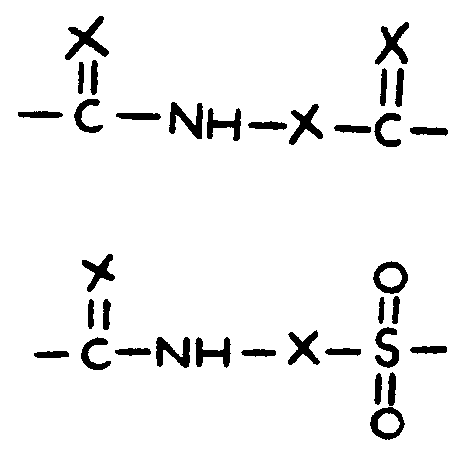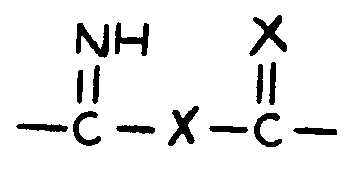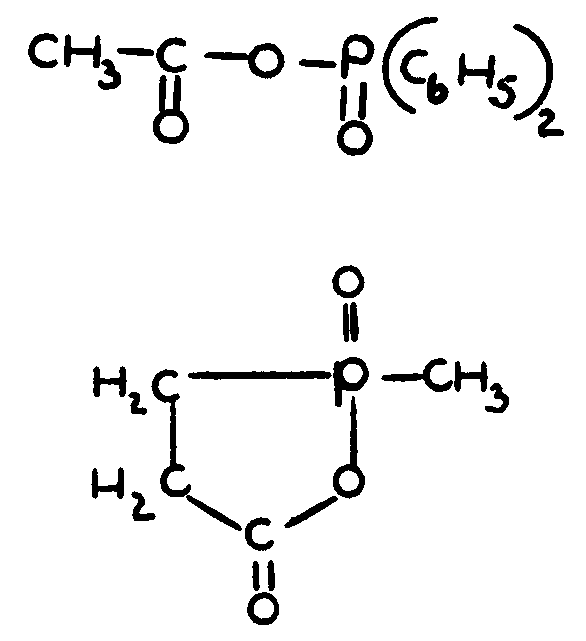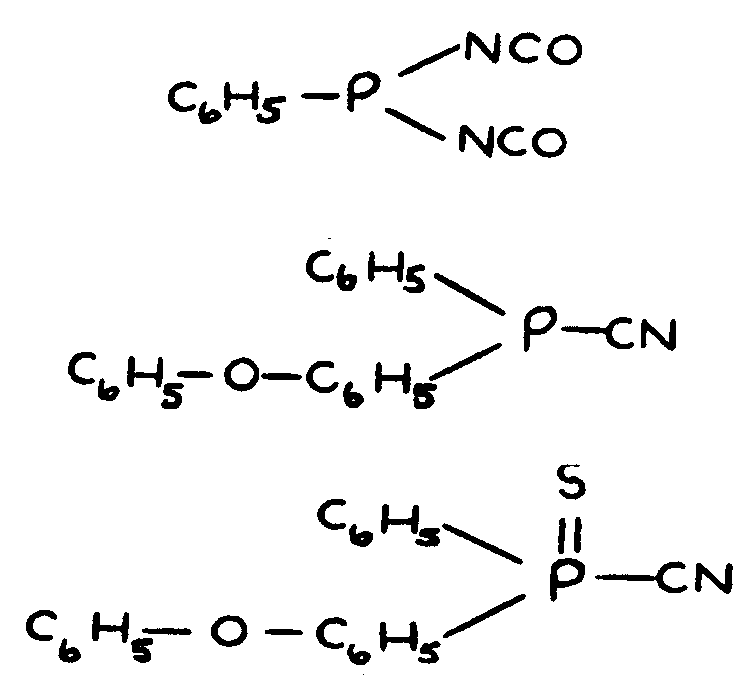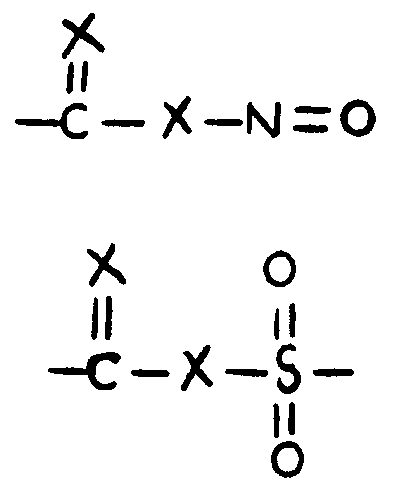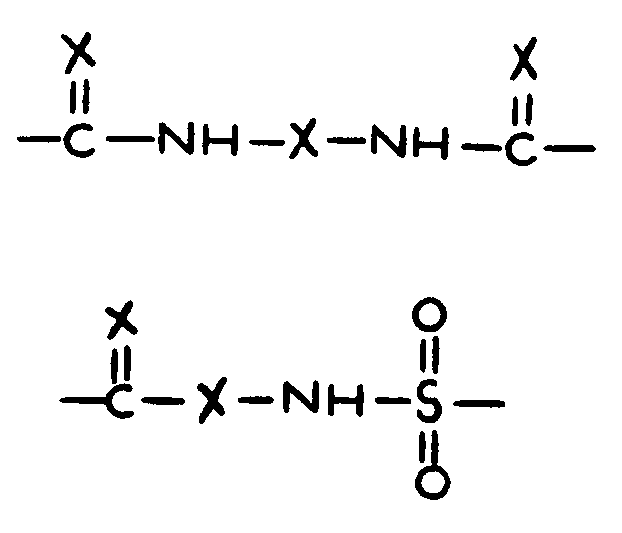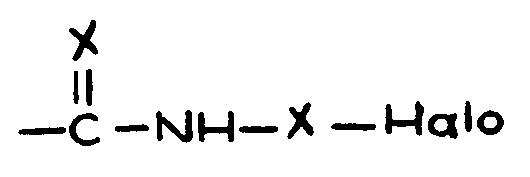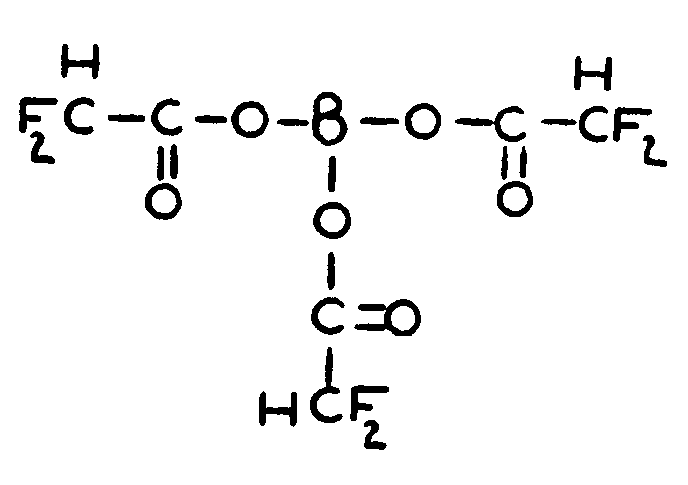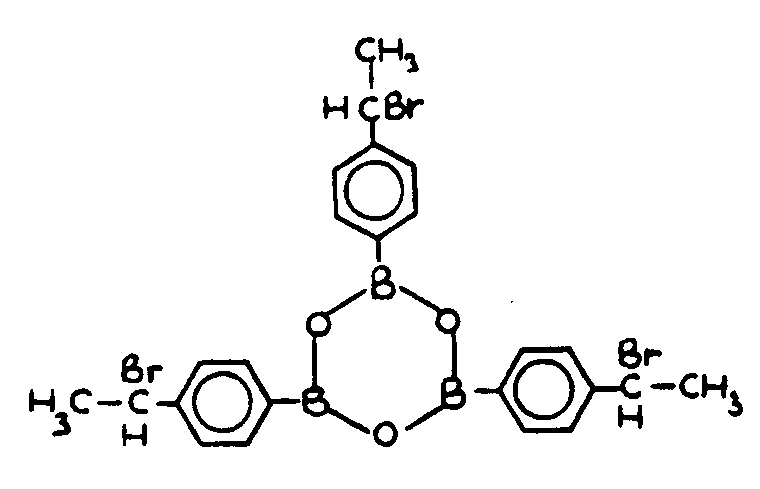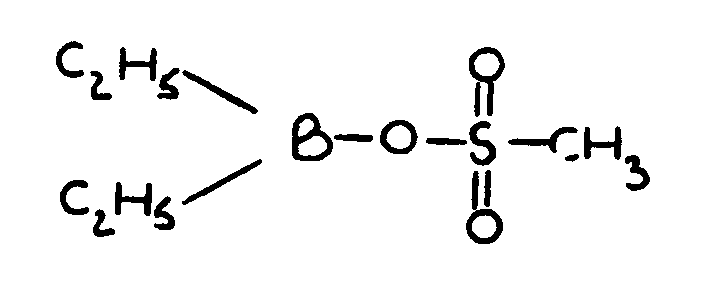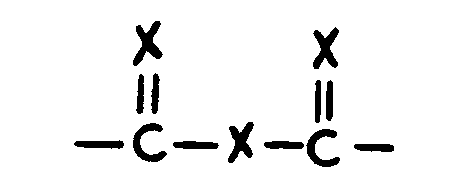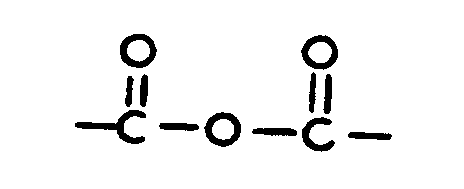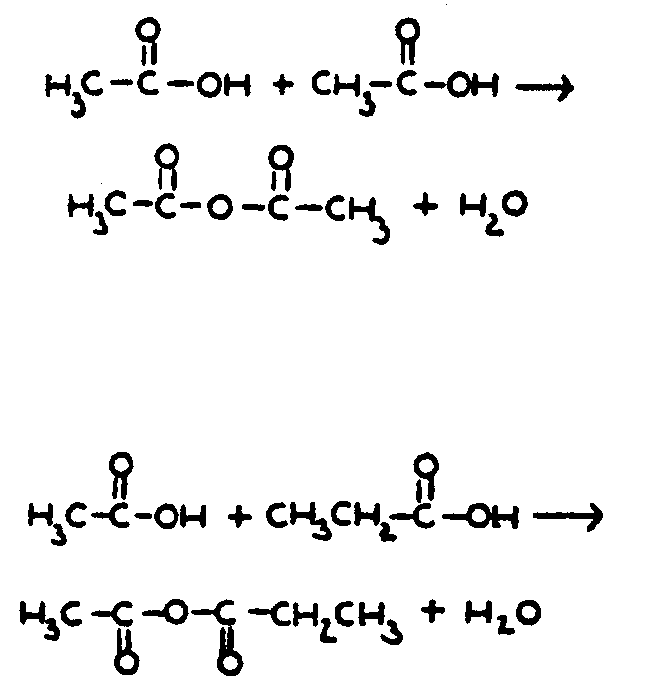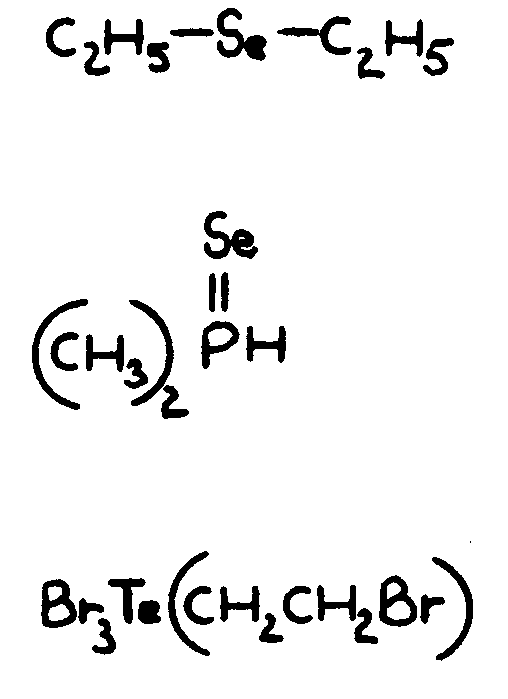![[Search a list of Patent Appplications for class 562]](../as.gif) CLASS 562, CLASS 562, | ORGANIC COMPOUNDS -- PART OF THE CLASS 532-570 SERIES |
| Click here for a printable version of this file | |
SUBCLASSES
![[List of Patents for class 562 subclass 1]](../ps.gif) 1 1 | Persulphonic acids or salts thereof (i.e., compounds having the -S(=O)(=O) O-OH group, wherein the hydrogen may be replaced by a group IA or IIA light metal, or by substituted or unsubstituted ammonium) | ||
| This subclass is indented under subclass 1. Compounds under Class 532, ... which contain the following
group, wherein H of -OH may be replaced by a Group IA or IIA light
metal, or by substituted or unsubstituted ammonium:
SEE OR SEARCH CLASS:
| |||
![[List of Patents for class 562 subclass 2]](../ps.gif) 2 2 | Percarboxylic acids or salts thereof (i.e., compounds having the -C(=O)-O OH group, wherein the hydrogen may be replaced by a group IA or IIA light metal, or by substituted or unsubstituted ammonium) | ||
| This subclass is indented under subclass 1. Compounds under Class 532, ... which contain the following
group, wherein H of -OH may be replaced by a Group IA or IIA light
metal, or by substituted or unsubstituted ammonium:
SEE OR SEARCH CLASS:
| |||
![[List of Patents for class 562 subclass 3]](../ps.gif) 3 3 | With preservative or stabilizer |
| This subclass is indented under subclass 2. Products wherein the percarboxylic acid is mixed with a stabilizing or preserving agent, whose sole function is to prevent physical or chemical change. | |
![[List of Patents for class 562 subclass 4]](../ps.gif) 4 4 | Formation of the -C(=O)-O-OH group, or of a salt thereof (e.g., from acid halides or anhydrides, neutralization; etc) | ||
This subclass is indented under subclass 2. Processes which involve the formation of the -C(=O)-O-O-H
group, or the formation of a salt of this group.
| |||
![[List of Patents for class 562 subclass 5]](../ps.gif) 5 5 | Aldehyde or percarboxylic acid ester reactant |
| This subclass is indented under subclass 4. Processes wherein an aldehyde or a percarboxylic acid ester is used as a reactant. | |
![[List of Patents for class 562 subclass 6]](../ps.gif) 6 6 | Carboxylic acid or carboxylic acid salt reactant |
| This subclass is indented under subclass 4. Processes wherein a carboxylic acid or a carboxylic acid salt is used as a reactant. | |
![[List of Patents for class 562 subclass 7]](../ps.gif) 7 7 | Boron acids or salts thereof (i.e., compounds having -XH, wherein X is chalcogen, attached directly to boron by nonionic bonding and wherein the hydrogen may be replaced by a group IA or IIA light metal, or by substituted or unsubstituted ammonium) | ||||
This subclass is indented under subclass 1. Compounds under Class 532, ... in which boron is attached
directly to -XH by nonionic bonding, wherein X is chalcogen (i.e.,
oxygen, sulfur, selenium or tellurium) and H of -XH may be replaced
by a Group IA or IIA light metal, or by substituted or unsubstituted ammonium.
SEE OR SEARCH CLASS:
| |||||
![[List of Patents for class 562 subclass 8]](../ps.gif) 8 8 | Phosphorus acids or salts thereof (i.e., compounds having -XH, wherein X is chalcogen, attached directly to phosphorus by nonionic bonding and wherein the hydrogen may be replaced by a substituted or unsubstituted ammonium or by a group IA or IIA light metal) | ||||
This subclass is indented under subclass 1. Compounds under Class 532, ... wherein -XH is bonded directly
to phosphorus by nonionic bonding; the X is chalcogen (i.e., oxygen,
sulfur, selenium or tellurium) and -H of -XH may be replaced by
a Group IA or IIA light metal or by substituted or unsubstituted
ammonium (i.e., phosphorus acid or salt thereof).
SEE OR SEARCH CLASS:
| |||||
![[List of Patents for class 562 subclass 9]](../ps.gif) 9 9 | Sulfur attached directly to the phosphorus by nonionic bonding | ||
This subclass is indented under subclass 8. Compounds in which sulfur is attached directly to the phosphorus
by nonionic bonding.
| |||
![[List of Patents for class 562 subclass 10]](../ps.gif) 10 10 | Nitrogen attached directly to the phosphorus by nonionic bonding | ||
This subclass is indented under subclass 8. Compounds wherein nitrogen is attached directly to the phosphorus
by nonionic bonding.
| |||
![[List of Patents for class 562 subclass 11]](../ps.gif) 11 11 | Nitrogen attached indirectly to the phosphorus by nonionic bonding | ||
This subclass is indented under subclass 8. Compounds wherein nitrogen is attached indirectly to the
phosphorus by nonionic bonding.
| |||
![[List of Patents for class 562 subclass 12]](../ps.gif) 12 12 | Plural phosphori attached indirectly to each other by nonionic bonding | ||
This subclass is indented under subclass 11. Compounds in which at least two atoms of phosphorus are
attached indirectly to each other by nonionic bonding.
| |||
![[List of Patents for class 562 subclass 13]](../ps.gif) 13 13 | Plural phosphori bonded directly to the same carbon | ||
This subclass is indented under subclass 12. Compounds in which at least two phosphorus atoms are bonded
directly to the same carbon.
| |||
![[List of Patents for class 562 subclass 14]](../ps.gif) 14 14 | Additional nitrogen attached indirectly to the phosphorus by nonionic bonding | ||
This subclass is indented under subclass 12. Compounds wherein additional nitrogen is attached indirectly
to the phosphorus by nonionic bonding.
| |||
![[List of Patents for class 562 subclass 15]](../ps.gif) 15 15 | The nitrogen is bonded directly to -C(=X)-, wherein X is chalcogen | ||
This subclass is indented under subclass 11. Compounds in which the nitrogen is bonded directly to a
-C(=X)-group, wherein X is chalcogen (i.e., oxygen, sulfur,
selenium or tellurium).
| |||
![[List of Patents for class 562 subclass 16]](../ps.gif) 16 16 | The nitrogen and the phosphorus are bonded directly to the same carbon | ||
This subclass is indented under subclass 11. Compounds wherein the nitrogen and the phosphorus are bonded
directly to the same carbon.
| |||
![[List of Patents for class 562 subclass 17]](../ps.gif) 17 17 | The nitrogen is bonded to an additional acyclic carbon or acyclic carbon chain, to which a -C(=X)X- group is bonded directly, wherein the X's are the same or diverse chalcogen | ||
This subclass is indented under subclass 16. Compounds wherein the nitrogen is bonded directly to an
additional acyclic carbon or acyclic carbon chain to which a -C(=X)X-
group is also bonded directly, wherein the X"s may be the
same or diverse chalcogens (i.e., oxygen, sulfur, selenium or tellurium).
| |||
![[List of Patents for class 562 subclass 18]](../ps.gif) 18 18 | Preparing from a compound having a nitrogen containing hetero ring |
| This subclass is indented under subclass 17. Processes whereby a compound which contains a nitrogen-heterocyclo is utilized in the preparation. | |
![[List of Patents for class 562 subclass 19]](../ps.gif) 19 19 | The phosphorus is in a ring | ||
This subclass is indented under subclass 8. Compounds in which the phosphorus is a ring member.
| |||
![[List of Patents for class 562 subclass 20]](../ps.gif) 20 20 | Plural phosphori attached indirectly to each other by nonionic bonding | ||
This subclass is indented under subclass 8. Compounds in which at least two phosphorus atoms are attached
indirectly to each other by nonionic bonding.
| |||
![[List of Patents for class 562 subclass 21]](../ps.gif) 21 21 | Plural phosphori bonded directly to the same carbon | ||
This subclass is indented under subclass 20. Compounds wherein the plural phosphorus atoms are bonded
directly to the same carbon.
| |||
![[List of Patents for class 562 subclass 22]](../ps.gif) 22 22 | Processes |
| This subclass is indented under subclass 21. Processes for the preparation of compounds having plural phosphorus atoms bonded directly to the same carbon or for the treatment of such compounds. | |
![[List of Patents for class 562 subclass 23]](../ps.gif) 23 23 | Chalcogen attached indirectly to the phosphorus by nonionic bonding | ||
This subclass is indented under subclass 8. Compounds wherein chalcogen (i.e., oxygen, sulfur, selenium
or tellurium) is attached indirectly to the phosphorus atom by nonionic bonding.
| |||
![[List of Patents for class 562 subclass 24]](../ps.gif) 24 24 | The chalcogen is in a -C(=X)- group | ||
This subclass is indented under subclass 23. Compounds in which the chalcogen is in a -C(=X)-
group.
| |||
![[List of Patents for class 562 subclass 25]](../ps.gif) 25 25 | Halogen attached indirectly to the phosphorus by nonionic bonding | ||
This subclass is indented under subclass 8. Compounds in which halogen is attached indirectly to the
phosphorus atom by nonionic bonding.
| |||
![[List of Patents for class 562 subclass 26]](../ps.gif) 26 26 | Thiocarboxylic acids or salts thereof (i.e., compounds having the group -C(=X)XH, wherein the X's are the same or diverse chalcogens and at least one X is sulfur, and hydrogen may be replaced by a group IA or IIA light metal, or by substituted or unsubstituted ammonium) | ||
| This subclass is indented under subclass 1. Compounds under Class 532, ... which contain the following
group, wherein the X"s may be the same or diverse chalcogens
(i.e., oxygen, sulfur, selenium or tellurium), at least one X is sulfur,
and H of -XH may be replaced by a Group IA or IIA light metal or
by substituted or unsubstituted ammonium:
SEE OR SEARCH CLASS:
| |||
![[List of Patents for class 562 subclass 27]](../ps.gif) 27 27 | Nitrogen bonded directly to the carbon of the -C(=X)XH group or of its salt (e.g., dithiocarbamic acids, etc.) | ||
This subclass is indented under subclass 26. Compounds wherein the carbon of the -C(=X)XH
group, or of its salt, is bonded directly to nitrogen.
| |||
![[List of Patents for class 562 subclass 28]](../ps.gif) 28 28 | Processes utilizing carbon disulfide | ||
This subclass is indented under subclass 27. Processes wherein carbon disulfide is used.
| |||
![[List of Patents for class 562 subclass 29]](../ps.gif) 29 29 | Thiosulfonic acids or salts thereof (i.e., compounds containing the thiosulfonate group, -S(=O)(=O)-S-, wherein the divalent sulfur is bonded directly to hydrogen, or to a group IA or IIA light metal or to substituted or unsubstituted ammonium) | ||
| This subclass is indented under subclass 1. Compounds under Class 532, ... which contain the following
group, wherein H of -SH may be replaced by a Group IA or IIA light
metal, or by substituted or unsubstituted ammonium:
SEE OR SEARCH CLASS:
| |||
![[List of Patents for class 562 subclass 30]](../ps.gif) 30 30 | Sulfonic acids or salts thereof (i.e., compounds containing the sulfonate group, -S(=O)(=O)-O- wherein the single bonded oxygen is bonded directly to hydrogen, or to a group IA or IIA light metal or to substituted or unsubstituted ammonium) | ||
| This subclass is indented under subclass 1. Compounds under Class 532, ... which contain the following
group, sulfonate, wherein the single bonded oxygen is bonded directly
to hydrogen, or to a Group IA or IIA light metal, or to substituted
or unsubstituted ammonium:
SEE OR SEARCH CLASS:
| |||
![[List of Patents for class 562 subclass 31]](../ps.gif) 31 31 | Hydrophenanthrene ring system containing | ||
This subclass is indented under subclass 30. Compounds which contain the hydrophenanthrene ring system.
| |||
![[List of Patents for class 562 subclass 32]](../ps.gif) 32 32 | Processes of sulfonating lignites, leonardites, coal, humic acids, bark or pitch, and the reaction products thereof |
| This subclass is indented under subclass 30. Processes wherein lignites, leonardites, coal, humic acids, bark or pitch is sulfonated to form a sulfonic acid or salt thereof, or the reaction products of such processes. | |
![[List of Patents for class 562 subclass 33]](../ps.gif) 33 33 | Petroleum sulfonic acids | ||||||||
This subclass is indented under subclass 30. Compounds wherein the sulfur of the sulfonate group is bonded
directly to carbon of petroleum.
| |||||||||
![[List of Patents for class 562 subclass 34]](../ps.gif) 34 34 | Addition salts having organic nitrogen containing cation |
| This subclass is indented under subclass 33. Products wherein the single bonded oxygen of a petroleum sulfonate group is bonded directly to organic nitrogen by ionic bonding. | |
![[List of Patents for class 562 subclass 35]](../ps.gif) 35 35 | Boron or phosphorus attached indirectly to the sulfonate group by nonionic bonding (e.g., phosphonium salts, etc.) | ||
This subclass is indented under subclass 30. Compounds wherein the sulfonate group is attached indirectly
to boron or phosphorus by nonionic bonding.
| |||
![[List of Patents for class 562 subclass 36]](../ps.gif) 36 36 | Chalcogen or -C(=X)-, wherein X is chalcogen, attached directly to the sulfonate sulfur by nonionic bonding | ||
This subclass is indented under subclass 30. Compounds wherein the sulfur of the sulfonate group is attached
directly to chalcogen (i.e., oxygen, sulfur, selenium or tellurium)
or to -C(=X)-, wherein X is chalcogen, by nonionic bonding.
| |||
![[List of Patents for class 562 subclass 37]](../ps.gif) 37 37 | Nitrogen attached directly to the sulfonate sulfur by nonionic bonding (e.g., sulfamic acids, etc.) | ||
This subclass is indented under subclass 30. Compounds wherein the sulfur of the sulfonate group is attached
directly to nitrogen by nonionic bonding.
| |||
![[List of Patents for class 562 subclass 38]](../ps.gif) 38 38 | Processes utilizing an inorganic sulfamic acid, or a salt thereof | ||
This subclass is indented under subclass 37. Processes wherein an inorganic sulfamic acid, or a salt
of an inorganic sulfamic acid, is used.
| |||
![[List of Patents for class 562 subclass 39]](../ps.gif) 39 39 | Processes of forming the -NH-S(=O)(O=)-O- group, wherein substitution may be made for hydrogen only |
| This subclass is indented under subclass 37. Processes which involve the formation of the following group,
wherein substitution may be made for hydrogen only:
| |
![[List of Patents for class 562 subclass 40]](../ps.gif) 40 40 | Additional salts having organic nitrogen containing cation | ||
This subclass is indented under subclass 37. Compounds wherein the single bonded oxygen of the sulfonate
group is bonded directly to organic nitrogen by ionic bonding.
| |||
![[List of Patents for class 562 subclass 41]](../ps.gif) 41 41 | Benzene ring attached indirectly to the sulfonate group by acyclic nonionic bonding | ||
This subclass is indented under subclass 30. Compounds wherein the sulfonate group is attached indirectly
to a benzene ring by acyclic nonionic bonding.
| |||
![[List of Patents for class 562 subclass 42]](../ps.gif) 42 42 | Noncarbon atom in acyclic chain between the benzene ring and the sulfonate sulfur | ||
This subclass is indented under subclass 41. Compounds wherein the acyclic chain between the benzene
ring and the sulfonate sulfur has a noncarbon atom as a chain member.
| |||
![[List of Patents for class 562 subclass 43]](../ps.gif) 43 43 | Nitrogen in the acyclic chain | ||
This subclass is indented under subclass 42. Compounds wherein the acyclic chain has nitrogen as a chain
member.
| |||
![[List of Patents for class 562 subclass 44]](../ps.gif) 44 44 | Chalcogen or -C(=X)-, wherein X is chalcogen, in the chain | ||
This subclass is indented under subclass 43. Compounds wherein chalcogen (i.e., oxygen, sulfur, selenium
or tellurium) or -C(=X)-, wherein X is chalcogen, is also
a member of the acyclic chain.
| |||
![[List of Patents for class 562 subclass 45]](../ps.gif) 45 45 | Benzene ring bonded directly to the sulfonate sulfur (e.g., purification and neutralization of benzene sulfonic acids, etc.) | ||
This subclass is indented under subclass 30. Compounds wherein the sulfonate sulfur is bonded directly
to a benzene ring.
| |||
![[List of Patents for class 562 subclass 46]](../ps.gif) 46 46 | Having -C(=X)-, wherein X is chalcogen, attached indirectly to the sulfonate group by nonionic bonding (e.g., aldehydes, etc.) | ||
This subclass is indented under subclass 45. Compounds wherein the sulfonate group is attached indirectly
by nonionic bonding to -C(=X)-, wherein X is chalcogen
(i.e., oxygen, sulfur, selenium or tellurium).
| |||
![[List of Patents for class 562 subclass 47]](../ps.gif) 47 47 | Chalcogen or nitrogen bonded directly to the -C(=X)- group | ||
This subclass is indented under subclass 46. Compounds wherein the -C(=X)- group is bonded directly
to nitrogen or to chalcogen.
| |||
![[List of Patents for class 562 subclass 48]](../ps.gif) 48 48 | Benzene ring bonded directly to each nitrogen of a -NH-C(=X)-NH-group, wherein X is chalcogen and substitution may be made for hydrogen only | ||
This subclass is indented under subclass 47. Compounds wherein each nitrogen of a -NH-C(=X)-NH-
group, wherein X is chalcogen and substitution may be made for hydrogen
only, is bonded directly to a benzene ring.
| |||
![[List of Patents for class 562 subclass 49]](../ps.gif) 49 49 | At least one of the benzene rings is part of a naphthalene ring system | ||
This subclass is indented under subclass 48. Compounds wherein the -NH-C(=X)-NH- group is bonded
directly to at least one benzene ring that is part of a naphthalene
ring system.
| |||
![[List of Patents for class 562 subclass 50]](../ps.gif) 50 50 | Plural naphthalene ring systems attached indirectly to the -NHC(=X)NH- group by nonionic bonding | ||
This subclass is indented under subclass 48. Compounds wherein the -NH-C(=X)-NH- is attached
indirectly to plural naphthalene ring systems by nonionic bonding.
| |||
![[List of Patents for class 562 subclass 51]](../ps.gif) 51 51 | Stilbene containing |
| This subclass is indented under subclass 47. Compounds which contain the following group, wherein substitution
may be made for hydrogen only:
| |
![[List of Patents for class 562 subclass 52]](../ps.gif) 52 52 | Plural -C(=X)- groups attached indirectly to the sulfonate group by nonionic bonding | ||
This subclass is indented under subclass 47. Compounds wherein the sulfonate group is attached indirectly
to plural -C(=X)- groups by nonionic bonding.
| |||
![[List of Patents for class 562 subclass 53]](../ps.gif) 53 53 | Plural carbons bonded directly to -C(=X)- | ||
This subclass is indented under subclass 52. Compounds wherein a -C(=X)- group is bonded directly
to two carbon atoms.
| |||
![[List of Patents for class 562 subclass 54]](../ps.gif) 54 54 | Plural -C(=X)- groups bonded directly to the same benzene ring | ||
This subclass is indented under subclass 52. Compounds wherein a benzene ring is bonded directly to more
than one -C(=X)- group.
| |||
![[List of Patents for class 562 subclass 55]](../ps.gif) 55 55 | Acyclic carbon bonded directly to the -C(=X)- group | ||
This subclass is indented under subclass 47. Compounds wherein the -C(=X)- group is bonded directly
to an acyclic carbon.
| |||
![[List of Patents for class 562 subclass 56]](../ps.gif) 56 56 | The -C(=X)- is part of a -C(=X)X- group, wherein the X's may be the same or diverse chalcogens | ||
This subclass is indented under subclass 47. Compounds wherein the -C(=X)- group is bonded directly
to chalcogen in a -C(=X)X- group, in which the X"s
may be the same or diverse chalcogens.
| |||
![[List of Patents for class 562 subclass 57]](../ps.gif) 57 57 | Nitrogen attached indirectly to the sulfonate group by nonionic bonding | ||
This subclass is indented under subclass 56. Compounds wherein the sulfonate group is attached indirectly
to nitrogen by nonionic bonding.
| |||
![[List of Patents for class 562 subclass 58]](../ps.gif) 58 58 | Nitrogen attached indirectly to the sulfonate group by nonionic bonding | ||
This subclass is indented under subclass 45. Compounds wherein the sulfonate group is attached indirectly
to nitrogen by nonionic bonding.
| |||
![[List of Patents for class 562 subclass 59]](../ps.gif) 59 59 | Plural benzene rings bonded directly to each other or to the same acyclic carbon | ||
This subclass is indented under subclass 58. Compounds wherein plural benzene rings are bonded to each
other or to the same acyclic carbon.
| |||
![[List of Patents for class 562 subclass 60]](../ps.gif) 60 60 | Stilbene containing |
| This subclass is indented under subclass 58. Compounds which contain the following group, wherein substitution
may be made for hydrogen only:
| |
![[List of Patents for class 562 subclass 61]](../ps.gif) 61 61 | Plural benzene rings bonded directly to the same nitrogen | ||
This subclass is indented under subclass 58. Compounds wherein a nitrogen atom is bonded to more than
one benzene ring.
| |||
![[List of Patents for class 562 subclass 62]](../ps.gif) 62 62 | Plural nitrogens each bonded to two benzene rings (e.g., phenylaminophenylaminophenyl compounds, etc.) | ||
This subclass is indented under subclass 61. Compounds wherein each of two benzene rings is bonded directly
to two nitrogen atoms.
| |||
![[List of Patents for class 562 subclass 63]](../ps.gif) 63 63 | At least one of the benene rings is part of a naphthalene ring system | ||
This subclass is indented under subclass 61. Compounds wherein the nitrogen is bonded directly to a benzene
ring that is part of a naphthalene ring system.
| |||
![[List of Patents for class 562 subclass 64]](../ps.gif) 64 64 | Oxygen bonded directly to a benzene ring | ||
This subclass is indented under subclass 61. Compounds wherein a benzene ring is bonded directly to oxygen.
| |||
![[List of Patents for class 562 subclass 65]](../ps.gif) 65 65 | Sulfonyl bonded directly to the nitrogen | ||
| This subclass is indented under subclass 58. Compounds wherein the nitrogen is bonded directly to sulfonyl:
| |||
![[List of Patents for class 562 subclass 66]](../ps.gif) 66 66 | The nitrogen is attached indirectly to a benzene ring by acyclic nonionic bonding | ||
This subclass is indented under subclass 58. Compounds wherein a benzene ring is attached indirectly
to the nitrogen by acyclic nonionic bonding.
| |||
![[List of Patents for class 562 subclass 67]](../ps.gif) 67 67 | Additional nitrogen attached indirectly to the sulfonate group by nonionic bonding | ||
This subclass is indented under subclass 66. Compounds wherein the sulfonate group is further attached
indirectly to an additional nitrogen by nonionic bonding.
| |||
![[List of Patents for class 562 subclass 68]](../ps.gif) 68 68 | Polycyclo ring system consisting of benzene rings bonded directly to the sulfonate group | ||
This subclass is indented under subclass 58. Compounds wherein the sulfur of the sulfonate group is bonded
directly to a polycyclo ring system consisting of benzene rings.
| |||
![[List of Patents for class 562 subclass 69]](../ps.gif) 69 69 | Nitro or nitroso bonded directly to the polycyclo ring system | ||
This subclass is indented under subclass 68. Compounds wherein the polycyclo ring system is bonded directly
to a nitro or nitroso group.
| |||
![[List of Patents for class 562 subclass 70]](../ps.gif) 70 70 | Oxygen bonded directly to the polycyclo ring system (e.g., aminonaphthol sulfonic acid, etc.) | ||
This subclass is indented under subclass 68. Compounds wherein the polycyclo ring system is bonded directly
to oxygen.
| |||
![[List of Patents for class 562 subclass 71]](../ps.gif) 71 71 | Additional sulfonate group bonded directly to the polycyclo ring system (e.g., H acid, etc.) | ||
This subclass is indented under subclass 70. Compounds wherein the polycyclo ring system is bonded directly
to plural sulfonate groups.
| |||
![[List of Patents for class 562 subclass 72]](../ps.gif) 72 72 | Halogen, plural nitrogens, or additional sulfonate group bonded directly to the polycyclo ring system | ||
This subclass is indented under subclass 68. Compounds wherein the polycyclo ring system is bonded directly
to halogen, to plural nitrogens, or to plural sulfonate groups.
| |||
![[List of Patents for class 562 subclass 73]](../ps.gif) 73 73 | Nitro or halogen bonded directly to a benzene ring | ||
This subclass is indented under subclass 58. Compounds wherein a benzene ring is bonded directly to nitro
or to halogen.
| |||
![[List of Patents for class 562 subclass 74]](../ps.gif) 74 74 | Nonsulfonate chalcogen attached indirectly to the sulfonate group by nonionic bonding | ||||
This subclass is indented under subclass 45. Compounds wherein the sulfonate group is attached indirectly
by nonionic bonding to a chalcogen (i.e., oxygen, sulfur, selenium,
or tellurium) that is not part of a sulfonate group.
| |||||
![[List of Patents for class 562 subclass 75]](../ps.gif) 75 75 | Two benzene rings bonded to the nonsulfonate chalcogen (e.g., phenoxyphenyl compounds, etc.) | ||
This subclass is indented under subclass 74. Compounds wherein the nonsulfonate chalcogen is bonded directly
to two benzene rings.
| |||
![[List of Patents for class 562 subclass 76]](../ps.gif) 76 76 | Plural carbons bonded directly to the nonsulfonate chalcogen (e.g., ethers, sulfones, etc.) | ||
This subclass is indented under subclass 74. Compounds wherein the nonsulfonate chalcogen is bonded directly
to plural carbons.
| |||
![[List of Patents for class 562 subclass 77]](../ps.gif) 77 77 | Hydroxy group or nonsulfonate sulfur attached indirectly to a benzene ring by acyclic nonionic bonding | ||
This subclass is indented under subclass 76. Compounds wherein a benzene ring is attached indirectly
to a hydroxy group or to a nonsulfonate sulfur by acyclic nonionic
bonding.
| |||
![[List of Patents for class 562 subclass 78]](../ps.gif) 78 78 | Halogen attached indirectly to the sulfonate group by nonionic bonding | ||
This subclass is indented under subclass 74. Compounds wherein the sulfonate group is attached indirectly
to halogen by nonionic bonding.
| |||
![[List of Patents for class 562 subclass 79]](../ps.gif) 79 79 | The sulfonate group and oxygen are bonded directly to the same polycyclo ring system which consists of benzene rings | ||
This subclass is indented under subclass 74. Compounds wherein oxygen and the sulfonate group are bonded
directly to the same polycyclo ring system consisting of benzene
rings.
| |||
![[List of Patents for class 562 subclass 80]](../ps.gif) 80 80 | Additional sulfonate group bonded directly to the polycyclo ring system | ||
This subclass is indented under subclass 79. Compounds wherein the polycyclo ring system consisting of
benzene rings is bonded directly to an additional sulfonate group.
| |||
![[List of Patents for class 562 subclass 81]](../ps.gif) 81 81 | Plural oxygens bonded directly to the same benzene ring | ||
This subclass is indented under subclass 74. Compounds wherein a benzene ring is bonded directly to more
than one oxygen.
| |||
![[List of Patents for class 562 subclass 82]](../ps.gif) 82 82 | The sulfonate group, oxygen, and alkyl of at least 4 carbons are bonded directly to the same benzene ring | ||
This subclass is indented under subclass 74. Compounds wherein a benzene ring is bonded directly to each
of the sulfonate group, oxygen, and alkyl of at least four carbons.
| |||
![[List of Patents for class 562 subclass 83]](../ps.gif) 83 83 | Halogen attached indirectly to the sulfonate group by nonionic bonding | ||
This subclass is indented under subclass 45. Compounds wherein the sulfonate group is attached indirectly
to halogen by nonionic bonding.
| |||
![[List of Patents for class 562 subclass 84]](../ps.gif) 84 84 | Addition salts having organic nitrogen containing cation | ||
This subclass is indented under subclass 45. Compounds wherein the single bonded oxygen of the sulfonate
group is bonded directly to organic nitrogen by ionic bonding.
| |||
![[List of Patents for class 562 subclass 85]](../ps.gif) 85 85 | Having -C(=X)-, wherein X is chalcogen, in the cation | ||
This subclass is indented under subclass 84. Compounds wherein the organic nitrogen is attached indirectly
by nonionic bonding to -C(=X)-, wherein X is chalcogen
(i.e., oxygen, sulfur, selenium or tellurium).
| |||
![[List of Patents for class 562 subclass 86]](../ps.gif) 86 86 | Nitrogen double bonded to carbon in the cation (e.g., guanidinium salts, etc.) | ||
This subclass is indented under subclass 84. Compounds wherein the organic nitrogen is part of a cation
containing carbon double bonded to nitrogen.
| |||
![[List of Patents for class 562 subclass 87]](../ps.gif) 87 87 | Acyclic carbon to carbon unsaturation containing | ||
This subclass is indented under subclass 45. Compounds which contain unsaturation between acyclic carbon
atoms.
| |||
![[List of Patents for class 562 subclass 88]](../ps.gif) 88 88 | Plural benzene rings bonded directly to each other, or to the same acyclic carbon or acyclic carbon chain | ||
This subclass is indented under subclass 45. Compounds wherein an acyclic carbon or an acyclic carbon
chain is bonded directly to plural benzene rings, or two benzene
rings are bonded directly to each other.
| |||
![[List of Patents for class 562 subclass 89]](../ps.gif) 89 89 | Polycyclo ring system consisting of benzene rings bonded directly to the sulfonate group | ||
This subclass is indented under subclass 45. Compounds wherein the sulfonate group is bonded directly
to a polycyclo ring system consisting of benzene rings.
| |||
![[List of Patents for class 562 subclass 90]](../ps.gif) 90 90 | Processes of sulfonating naphthalene per se or alkyl substituted naphthalene |
| This subclass is indented under subclass 89. Processes wherein naphthalene, per se, or an alkyl substituted naphthalene, is sulfonated. | |
![[List of Patents for class 562 subclass 91]](../ps.gif) 91 91 | Sulfonate group and alkyl group of at least four carbons bonded directly to the same benzene ring | ||
This subclass is indented under subclass 45. Compounds wherein a benzene ring is bonded to both the sulfonate
group, and to alkyl of at least four carbons.
| |||
![[List of Patents for class 562 subclass 92]](../ps.gif) 92 92 | With preservative, stabilizer, or color or odor affecting additive |
| This subclass is indented under subclass 91. Products wherein the sulfonic acid or salt thereof is mixed with stabilizing or preserving agent, whose sole function is to prevent physical or chemical change, or with a color or odor affecting additive, whose sole function is to improve color or odor qualities. | |
![[List of Patents for class 562 subclass 93]](../ps.gif) 93 93 | Processes including alkylation of a benzene ring, and the products thereof |
| This subclass is indented under subclass 91. Processes which include the step of alkylating a benzene ring, and the products of such processes. | |
![[List of Patents for class 562 subclass 94]](../ps.gif) 94 94 | The alkylating agent is an olefin |
| This subclass is indented under subclass 93. Processes wherein an olefin is used as the alkylating agent. | |
![[List of Patents for class 562 subclass 95]](../ps.gif) 95 95 | Sulfonation processes | ||
This subclass is indented under subclass 91. Processes which include the step of sulfonating a benzene
ring.
| |||
![[List of Patents for class 562 subclass 96]](../ps.gif) 96 96 | Purification or recovery |
| This subclass is indented under subclass 91. Processes wherein the sulfonic acid, or salt thereof, is separated from impurities or from the reaction mixture. | |
![[List of Patents for class 562 subclass 97]](../ps.gif) 97 97 | Neutralization or acidification |
| This subclass is indented under subclass 91. Processes wherein a sulfonic acid is converted to a salt thereof, or a salt of a sulfonic acid is converted to the free acid. | |
![[List of Patents for class 562 subclass 98]](../ps.gif) 98 98 | Sulfonation utilizing sulfur trioxide or oleum (e.g., sulfonation of benzene or toluene with oleum, etc.) | ||
This subclass is indented under subclass 45. Processes wherein sulfur trioxide or oleum is used to sulfonate
a benzene ring.
| |||
![[List of Patents for class 562 subclass 99]](../ps.gif) 99 99 | Sulfonation utilizing sulfuric acid (e.g., sulfonation of benzene or toluene with sulfuric acid, etc.) |
| This subclass is indented under subclass 45. Processes wherein sulfuric acid is used to sulfonate a benzene ring. | |
![[List of Patents for class 562 subclass 100]](../ps.gif) 100 100 | Polycyclo alicyclic ring system attached directly or indirectly to the sulfonate group by nonionic bonding | ||
This subclass is indented under subclass 30. Compounds wherein the sulfonate group is attached directly
or indirectly to a polycyclo alicyclic ring system by nonionic bonding.
| |||
![[List of Patents for class 562 subclass 101]](../ps.gif) 101 101 | Plural sulfonate groups attached indirectly to each other by acyclic nonionic bonding | ||
This subclass is indented under subclass 30. Compounds wherein the sulfonate group is attached indirectly
to an additional sulfonate group by acyclic nonionic bonding.
| |||
![[List of Patents for class 562 subclass 102]](../ps.gif) 102 102 | Nitrogen or -C(=X)-, wherein X is chalcogen, attached indirectly to the sulfonate groups by nonionic bonding | ||
This subclass is indented under subclass 101. Compounds wherein the sulfonate groups are attached indirectly
to nitrogen or to -C(=X)-, wherein X is chalcogen (i.e.,
oxygen, sulfur, selenium or tellurium), by nonionic bonding.
| |||
![[List of Patents for class 562 subclass 103]](../ps.gif) 103 103 | Plural nonsulfonate chalcogens attached indirectly to the sulfonate groups by nonionic bonding | ||
This subclass is indented under subclass 101. Compounds wherein the sulfonate groups are attached indirectly
to plural nonsulfonate chalcogens (i.e., oxygen, sulfur, selenium
or tellurium) by nonionic bonding.
| |||
![[List of Patents for class 562 subclass 104]](../ps.gif) 104 104 | Nitrogen attached indirectly to the sulfonate group by acyclic nonionic bonding | ||
This subclass is indented under subclass 30. Compounds wherein the sulfonate group is attached indirectly
to nitrogen by acyclic nonionic bonding.
| |||
![[List of Patents for class 562 subclass 105]](../ps.gif) 105 105 | Having -C(=X)-, wherein X is chalcogen, attached indirectly to the sulfonate group by acyclic nonionic bonding | ||
This subclass is indented under subclass 104. Compounds wherein the sulfonate group is attached indirectly
to -C(=X)-, wherein X is chalcogen (i.e., oxygen, sulfur,
selenium or tellurium), by acyclic nonionic bonding.
| |||
![[List of Patents for class 562 subclass 106]](../ps.gif) 106 106 | Plural nitrogens or plural -C(=X)- groups, wherein X is chalcogen, attached indirectly to the sulfonate group by acyclic nonionic bonding | ||
This subclass is indented under subclass 105. Compounds wherein the sulfonate group is attached indirectly
to plural nitrogens or to plural -C(=X)-groups by acyclic
nonionic bonding.
| |||
![[List of Patents for class 562 subclass 107]](../ps.gif) 107 107 | Chalcogen attached indirectly to the sulfonate group by acyclic nonionic bonding | ||
This subclass is indented under subclass 104. Compounds wherein the sulfonate group is attached indirectly
to chalcogen (i.e., oxygen, sulfur, selenium or tellurium) by acyclic
nonionic bonding.
| |||
![[List of Patents for class 562 subclass 108]](../ps.gif) 108 108 | Chalcogen attached indirectly to the sulfonate group by acyclic nonionic bonding | ||
This subclass is indented under subclass 30. Compounds wherein the sulfonate group is attached indirectly
to chalcogen (i.e., oxygen, sulfur, selenium or tellurium) by acyclic
nonionic bonding.
| |||
![[List of Patents for class 562 subclass 109]](../ps.gif) 109 109 | The chalcogen, X, is in a -C(=X)- group | ||
This subclass is indented under subclass 108. Compounds wherein the chalcogen, X, is double bonded to
carbon in a -C(=X)- group.
| |||
![[List of Patents for class 562 subclass 110]](../ps.gif) 110 110 | Plural chalcogens attached indirectly to the sulfonate group by acyclic nonionic bonding | ||
This subclass is indented under subclass 108. Compounds wherein the sulfonate group is attached indirectly
to plural chalcogens by acyclic nonionic bonding.
| |||
![[List of Patents for class 562 subclass 111]](../ps.gif) 111 111 | Plural carbons bonded directly to the chalcogen (e.g., ethers, etc.) | ||
This subclass is indented under subclass 108. Compounds wherein the chalcogen is bonded directly to plural
carbons.
| |||
![[List of Patents for class 562 subclass 112]](../ps.gif) 112 112 | Addition salts having organic nitrogen containing cation | ||
This subclass is indented under subclass 108. Compounds wherein the single bonded oxygen of the sulfonate
group is bonded directly to organic nitrogen by ionic bonding.
| |||
![[List of Patents for class 562 subclass 113]](../ps.gif) 113 113 | Halogen attached indirectly to the sulfonate group by acyclic nonionic bonding | ||
This subclass is indented under subclass 30. Compounds wherein the sulfonate group is attached indirectly
to halogen by acyclic nonionic bonding.
| |||
![[List of Patents for class 562 subclass 114]](../ps.gif) 114 114 | Addition salts having organic nitrogen containing cation | ||
This subclass is indented under subclass 30. Compounds wherein the single bonded oxygen of the sulfonate
group is bonded directly to organic nitrogen by ionic bonding.
| |||
![[List of Patents for class 562 subclass 115]](../ps.gif) 115 115 | Processes (e.g., neutralization, stabilization, etc.) |
| This subclass is indented under subclass 30. Processes which are directed to the preparation, purification, recovery, or treatment in any way of a sulfonic acid or of a sulfonic acid salt. | |
![[List of Patents for class 562 subclass 116]](../ps.gif) 116 116 | Decarboxylation, hydrogenation or formation of carbon-to-carbon unsaturation |
| This subclass is indented under subclass 115. Processes which involve formation of carbon-to-carbon unsaturation, hydrogenation or decarboxylation. | |
![[List of Patents for class 562 subclass 117]](../ps.gif) 117 117 | Conversion of sulfur containing hetero ring compounds to sulfonic acids | ||
This subclass is indented under subclass 115. Processes wherein sulfonic acids are formed by conversion
of sulfur containing hetero ring compounds.
| |||
![[List of Patents for class 562 subclass 118]](../ps.gif) 118 118 | Oxidation of organic sulfur compounds to sulfonic acids | ||
This subclass is indented under subclass 115. Processes wherein sulfonic acids are formed by oxidation
of organic sulfur compounds.
| |||
![[List of Patents for class 562 subclass 119]](../ps.gif) 119 119 | Hydrolysis of sulfonyl halides |
| This subclass is indented under subclass 114. Processes which involve the hydrolysis of sulfonyl halides. | |
![[List of Patents for class 562 subclass 120]](../ps.gif) 120 120 | Formation of sulfonic acids or sulfonic acid salts utilizing inorganic sulfonating agents (e.g., reaction of alcohols or alkyl halides with sulfurous acid, etc.) |
| This subclass is indented under subclass 114. Processes wherein sulfonic acids, or salts of sulfonic acids, are formed by using inorganic sulfonating agents. | |
![[List of Patents for class 562 subclass 121]](../ps.gif) 121 121 | Utilizing sulfur dioxide and oxygen (i.e., sulfoxidation) | ||
This subclass is indented under subclass 120. Processes wherein oxygen and sulfur dioxide are utilized.
| |||
![[List of Patents for class 562 subclass 122]](../ps.gif) 122 122 | Sulfurous acid or salt thereof reacted with unsaturated hydrocarbon |
| This subclass is indented under subclass 120. Processes wherein an unsaturated hydrocarbon is reacted with sulfurous acid or with a salt thereof. | |
![[List of Patents for class 562 subclass 123]](../ps.gif) 123 123 | Utilizing sulfur trioxide, oleum, sulfuric acid or halosulfonic acid |
| This subclass is indented under subclass 120. Processes wherein halosulfonic acid, sulfuric acid, oleum or sulfur trioxide is used. | |
![[List of Patents for class 562 subclass 124]](../ps.gif) 124 124 | Purification or recovery |
| This subclass is indented under subclass 115. Processes wherein a sulfonic acid or a salt thereof is separated from impurities or from the reaction mixture. | |
![[List of Patents for class 562 subclass 125]](../ps.gif) 125 125 | Sulfinic or sulfenic acids or salts thereof (i.e., compounds containing the sulfinate group, -S(=O)O-, or the sulfenate group, -S-O-, wherein the single bonded oxygen is bonded directly to hydrogen, or to a group IA or group IIA light metal or to substituted or unsubstituted ammonium) | ||
| This subclass is indented under subclass 1. Compounds under Class 532, ... which contain either of
the two following groups: sulfinate or sulfenate, wherein, in either
case, the single bonded oxygen is bonded directly to hydrogen, to
a Group IA or IIA light metal, or to substituted or unsubstituted
ammonium:
SEE OR SEARCH CLASS:
| |||
![[List of Patents for class 562 subclass 126]](../ps.gif) 126 126 | Nitrogen attached indirectly to a sulfinate group by acyclic nonionic bonding | ||
This subclass is indented under subclass 125. Compounds wherein a sulfinate group is attached indirectly
to nitrogen by acyclic nonionic bonding.
| |||
![[List of Patents for class 562 subclass 400]](../ps.gif) 400 400 | Carboxylic acids and salts thereof: | ||||||||||||
This subclass is indented under subclass 1. Compounds under Class 532, ... wherein the acid function
is a carboxyl group or a salt thereof.
| |||||||||||||
![[List of Patents for class 562 subclass 401]](../ps.gif) 401 401 | Racemization or separation of optical isomers: | ||
This subclass is indented under subclass 400. Processes directed to the racemization or separation of
optical isomers and includes the separation of diastereomers as
well as the resolution of racemic mixtures of enantiomers.
| |||
![[List of Patents for class 562 subclass 402]](../ps.gif) 402 402 | Physical resolution: |
| This subclass is indented under subclass 401. Processes wherein the separation is performed solely by physical means such as fractional crystallization. | |
![[List of Patents for class 562 subclass 403]](../ps.gif) 403 403 | Hydrophenanthrene nucleus: | ||||||||||||
This subclass is indented under subclass 400. Compounds which contain a hydrophenanthrene nucleus, not
elsewhere provided.
SEE OR SEARCH CLASS:
| |||||||||||||
![[List of Patents for class 562 subclass 404]](../ps.gif) 404 404 | 1,4a-dimethyl hydrophenanthrene-1 carboxylic acids or salts thereof: | ||
This subclass is indented under subclass 403. Compounds which contain the 1,4a-dimethyl hydrophenanthrene-1
carboxylic acid nucleus.
| |||
![[List of Patents for class 562 subclass 405]](../ps.gif) 405 405 | Aromatic: | ||||
This subclass is indented under subclass 400. Compounds wherein the acid contains a benzene nucleus.
SEE OR SEARCH THIS CLASS, SUBCLASS:
| |||||
![[List of Patents for class 562 subclass 406]](../ps.gif) 406 406 | Preparation by carbonylation: |
| This subclass is indented under subclass 405. Processes wherein an aromatic carboxylic acid is prepared through formation of a carboxyl group on an aromatic compound by reaction with carbon monoxide. | |
![[List of Patents for class 562 subclass 407]](../ps.gif) 407 407 | Formation of carboxyl group by oxidation: | ||||
This subclass is indented under subclass 405. Processes wherein a carboxyl group of an aromatic acid is
formed by oxidation.
| |||||
![[List of Patents for class 562 subclass 408]](../ps.gif) 408 408 | Of aromatic compound: | ||
This subclass is indented under subclass 407. Process wherein a carboxyl group is formed by oxidizing
an aromatic compound.
| |||
![[List of Patents for class 562 subclass 409]](../ps.gif) 409 409 | Alkyl side chain oxidized: | ||
This subclass is indented under subclass 408. Processes wherein the carboxyl group is formed by oxidation
of an alkyl side chain of an aromatic nucleus.
| |||
![[List of Patents for class 562 subclass 410]](../ps.gif) 410 410 | Nitrogen containing oxidant: |
| This subclass is indented under subclass 409. Processes wherein the oxidizing agent utilized contains nitrogen, as for example, nitric acid or oxides of nitrogen. | |
![[List of Patents for class 562 subclass 411]](../ps.gif) 411 411 | Sulfur containing oxidant: |
| This subclass is indented under subclass 409. Processes wherein the oxidizing agent utilized is sulfur or a sulfur containing compound. | |
![[List of Patents for class 562 subclass 412]](../ps.gif) 412 412 | Air, O2, or O3 Oxidant: |
| This subclass is indented under subclass 409. Processes wherein the oxidizing agent utilized is air, oxygen, or ozone. | |
![[List of Patents for class 562 subclass 413]](../ps.gif) 413 413 | Multistage: | ||
This subclass is indented under subclass 412. Processes wherein the oxidation is carried out in plural
sequential stages.
| |||
![[List of Patents for class 562 subclass 414]](../ps.gif) 414 414 | With recycle or recovery of reaction component: | ||
This subclass is indented under subclass 412. Processes wherein components of the product of oxidation
may be separated, further treated, and either recycled to the reaction
chamber or recovered.
| |||
![[List of Patents for class 562 subclass 415]](../ps.gif) 415 415 | Gas phase: |
| This subclass is indented under subclass 412. Processes wherein the oxidation is conducted in a gas or vapor phase. | |
![[List of Patents for class 562 subclass 416]](../ps.gif) 416 416 | Halogen containing catalyst, initiator, or promoter utilized: |
| This subclass is indented under subclass 412. Processes wherein the oxidation process is carried out in the presence of a catalyst, or initiator or promoter which contains a halogen. | |
![[List of Patents for class 562 subclass 417]](../ps.gif) 417 417 | Initiator or promoter used with catalyst: |
| This subclass is indented under subclass 412. Processes wherein the oxidation is carried out with a catalyst and an additional material which may reduce the induction period or promote or regulate the oxidation rate to improve the yield or shorten the reaction time. | |
![[List of Patents for class 562 subclass 418]](../ps.gif) 418 418 | Of oxy or carbonyl containing compound: |
| This subclass is indented under subclass 408. Processes wherein the aromatic compounds which are oxidized contain an oxy group or a carbonyl group, such as, for example, aralkyl alcohols or aldehydes. | |
![[List of Patents for class 562 subclass 419]](../ps.gif) 419 419 | Hypohalite as oxidant: |
| This subclass is indented under subclass 418. Processes wherein the oxidizing agent is a hypohalite, such as, for example, sodium hypochlorite. | |
![[List of Patents for class 562 subclass 420]](../ps.gif) 420 420 | Nitrogen containing oxidant: |
| This subclass is indented under subclass 418. Processes wherein the oxidizing agent contains nitrogen, as for example, nitric acid or oxides of nitrogen. | |
![[List of Patents for class 562 subclass 421]](../ps.gif) 421 421 | Air, O2, or O3 Oxidant: |
| This subclass is indented under subclass 418. Processes wherein the oxidizing agent is air, oxygen, or ozone. | |
![[List of Patents for class 562 subclass 422]](../ps.gif) 422 422 | Of halo alkyl containing compounds: |
| This subclass is indented under subclass 408. Processes wherein the carboxyl group is formed by oxidizing a halo alkyl side chain of an aromatic compound. | |
![[List of Patents for class 562 subclass 423]](../ps.gif) 423 423 | Preparation by carbonation: |
| This subclass is indented under subclass 405. Processes wherein an aromatic carboxylic acid is produced by reacting an aromatic compound with carbon dioxide or a material which will produce carbon dioxide under the reaction conditions, such as a carbonate. | |
![[List of Patents for class 562 subclass 424]](../ps.gif) 424 424 | Of alkali metal phenolates: |
| This subclass is indented under subclass 423. Processes wherein an alkali metal phenolate is reacted with carbon dioxide to produce an aromatic hydroxy acid, as for example, the Kolbe-Schmitt reaction. | |
![[List of Patents for class 562 subclass 425]](../ps.gif) 425 425 | Having plural rings: |
| This subclass is indented under subclass 424. Processes wherein the alkali metal phenolate contains plural rings, as for example, a naphtholate which will produce a hydroxy naphthoic acid under the conditions of reaction. | |
![[List of Patents for class 562 subclass 426]](../ps.gif) 426 426 | Sulfur: | ||
This subclass is indented under subclass 405. Compounds wherein the aromatic carboxylic acid contains
sulfur, covalently bonded.
| |||
![[List of Patents for class 562 subclass 427]](../ps.gif) 427 427 | Polycyclo ring system: | ||
This subclass is indented under subclass 426. Compounds wherein the acid contains at least two carbocyclic
groups which are joined through two orthopositioned carbon atoms
or through a bridge.
| |||
![[List of Patents for class 562 subclass 428]](../ps.gif) 428 428 | Indenyl or hydrindenyl: | ||
This subclass is indented under subclass 427. Processes which contain the indenyl or hydrindenyl nucleus.
| |||
![[List of Patents for class 562 subclass 429]](../ps.gif) 429 429 | Sulfoxy: | ||||
This subclass is indented under subclass 426. Compounds which contain sulfur bonded to oxygen and includes
the groups -SO, -SO2 and -SO2X,
where X is halogen.
SEE OR SEARCH THIS CLASS, SUBCLASS:
| |||||
![[List of Patents for class 562 subclass 430]](../ps.gif) 430 430 | Nitrogen: | ||
This subclass is indented under subclass 429. Compounds wherein the acid also contains nitrogen.
| |||
![[List of Patents for class 562 subclass 431]](../ps.gif) 431 431 | Carboxyl, or salt thereof, in side chain having sulfur bonded directly to a ring: | ||||||
This subclass is indented under subclass 426. Compounds wherein the carboxyl group is attached to a side
chain which contains sulfur bonded directly to a ring.
| |||||||
![[List of Patents for class 562 subclass 432]](../ps.gif) 432 432 | Carboxyl, or salt thereof, bonded directly to a ring: | ||
This subclass is indented under subclass 426. Compounds wherein a carboxyl group is attached directly
to a ring.
| |||
![[List of Patents for class 562 subclass 433]](../ps.gif) 433 433 | Nitrogen bonded directly to carbon of organic radical (e.g., amino acids, etc.): | ||
This subclass is indented under subclass 405. Compounds wherein the acid contains nitrogen bonded directly
to a carbon of an organic radical not provided for above.
| |||
![[List of Patents for class 562 subclass 434]](../ps.gif) 434 434 | Nitro or nitroso: | ||
This subclass is indented under subclass 433. Compounds wherein the acid contains the nitro group (-NO2)
or the nitroso group (-NO) bonded to carbon.
| |||
![[List of Patents for class 562 subclass 435]](../ps.gif) 435 435 | Plural rings: | ||
This subclass is indented under subclass 434. Compounds wherein the acid contains more than one carbocyclic
group, at least one of which is aromatic.
| |||
![[List of Patents for class 562 subclass 436]](../ps.gif) 436 436 | Plural rings bonded directly to the same carbonyl: | ||
This subclass is indented under subclass 435. Compounds wherein the acid contains two carbocyclic nuclei
directly attached to the same carbonyl group.
| |||
![[List of Patents for class 562 subclass 437]](../ps.gif) 437 437 | Plural nitrogens: | ||
This subclass is indented under subclass 434. Compounds wherein the acid contains an additional nitrogen
covalently bonded.
| |||
![[List of Patents for class 562 subclass 438]](../ps.gif) 438 438 | Halogen: | ||
This subclass is indented under subclass 434. Compounds wherein the acid contains a halogen covalently
bonded.
| |||
![[List of Patents for class 562 subclass 439]](../ps.gif) 439 439 | Ureido, guanido, or hydrazine: | ||
This subclass is indented under subclass 433. Compounds wherein the acid contains the ureido group (N-C(=O)
-N), the guanido group (N-C(=N)-N) or the hydrazine group
(N-N).
| |||
![[List of Patents for class 562 subclass 440]](../ps.gif) 440 440 | Nitrogen double bonded directly to carbon (e.g. amidine, ketimine, etc.): | ||
This subclass is indented under subclass 433. Compounds wherein the acid contains an amidine group (-C(=N)-N)
or the group -C=N- equivalent in structure to those formed
by reacting an aldehyde or a ketone with ammonia or an amine.
| |||
![[List of Patents for class 562 subclass 441]](../ps.gif) 441 441 | Plural rings bonded directly to the same carbon: | ||
This subclass is indented under subclass 433. Compounds wherein the acid contains two carbocyclic nuclei
directly attached to the same carbon, which may be the carbon of
a methylene or a carbonyl group.
| |||
![[List of Patents for class 562 subclass 442]](../ps.gif) 442 442 | Nitrogen not bonded directly to a ring: | ||||
This subclass is indented under subclass 433. Compounds wherein the acid contains nitrogen which is not
directly bonded to a carbocyclic nucleus.
| |||||
![[List of Patents for class 562 subclass 443]](../ps.gif) 443 443 | In same chain as carboxyl, or salt thereof: | ||
This subclass is indented under subclass 442. Compounds wherein the acid contains a nitrogen which is
in or attached to the same side chain that contains a carboxyl group,
but is not attached directly to a carbocyclic nucleus.
| |||
![[List of Patents for class 562 subclass 444]](../ps.gif) 444 444 | Oxy: | ||
This subclass is indented under subclass 443. Compounds wherein the acid contains the group -OX attached
to a noncarbonylic carbon, where X is a non-carbonyclic C, H, or
an alcoholate forming group not provided for above.
| |||
![[List of Patents for class 562 subclass 445]](../ps.gif) 445 445 | Phenyl alanines: | ||
This subclass is indented under subclass 444. Compounds wherein the acid contains a phenyl alanine group.
| |||
![[List of Patents for class 562 subclass 446]](../ps.gif) 446 446 | Di-oxy phenyl alanines: | ||
This subclass is indented under subclass 445. Compounds wherein the acid contains two -OX groups, each
of which is attached directly to the phenyl of the phenyl alanine
group, where X is a noncarbonylic C, H, or an alcoholate forming
group not provided for above.
| |||
![[List of Patents for class 562 subclass 447]](../ps.gif) 447 447 | Phenoxyphenyl alanines: | ||
This subclass is indented under subclass 445. Compounds wherein the acid contains a phenoxy group attached
to the phenyl of the phenyl alanine.
| |||
![[List of Patents for class 562 subclass 448]](../ps.gif) 448 448 | Plural nitrogens: | ||
This subclass is indented under subclass 44. Compounds wherein the acid contains more than one covalently
bonded nitrogen.
| |||
![[List of Patents for class 562 subclass 449]](../ps.gif) 449 449 | Halogen: | ||
This subclass is indented under subclass 433. Compounds wherein the acid contains halogen covalently bonded.
| |||
![[List of Patents for class 562 subclass 450]](../ps.gif) 450 450 | Amide: | ||
This subclass is indented under subclass 443. Compounds wherein the acid contains the carbonyl residue
of a carboxylic acid attached to a nitrogen to form an amide (-C(O)N).
| |||
![[List of Patents for class 562 subclass 451]](../ps.gif) 451 451 | Oxy: | ||
This subclass is indented under subclass 442. Compounds wherein the acid contains an -OX group bonded
to a noncarbonylic carbon, where X is a noncarbonylic carbon, H,
or an alcoholate forming group not provided for above.
| |||
![[List of Patents for class 562 subclass 452]](../ps.gif) 452 452 | Oxy: | ||
This subclass is indented under subclass 433. Compounds wherein the acid contains an -OX group bonded
to a noncarbonylic carbon, where X is a noncarbonylic C, H, or an
alcoholate forming group not provided for above.
| |||
![[List of Patents for class 562 subclass 453]](../ps.gif) 453 453 | Carboxyl, or salt thereof, nitrogen and oxygen all bonded directly to the same benzene ring: | ||
This subclass is indented under subclass 452. Compounds wherein the acid contains nitrogen, an oxy group,
and a carboxyl group, all attached directly to the same benzene
ring.
| |||
![[List of Patents for class 562 subclass 454]](../ps.gif) 454 454 | Aryl-N-Aryl: | ||
This subclass is indented under subclass 452. Compounds wherein the acid contains two aromatic nuclei
attached to the same nitrogen.
| |||
![[List of Patents for class 562 subclass 455]](../ps.gif) 455 455 | Amide: | ||
This subclass is indented under subclass 452. Compounds wherein the acid contains the carbonylic residue
of a carboxylic acid directly attached to a nitrogen, forming an
amide.
| |||
![[List of Patents for class 562 subclass 456]](../ps.gif) 456 456 | Halogen: | ||
This subclass is indented under subclass 433. Compounds wherein the acid contains covalently bonded halogen.
| |||
![[List of Patents for class 562 subclass 457]](../ps.gif) 457 457 | Plural rings with nitrogen bonded directly to at least one ring: | ||
This subclass is indented under subclass 433. Compounds wherein the acid contains more than one carbocyclic
group and nitrogen is bonded directly to at least one of them.
| |||
![[List of Patents for class 562 subclass 458]](../ps.gif) 458 458 | Carboxyl, or salt thereof, bonded directly to a ring: | ||
This subclass is indented under subclass 433. Compounds wherein the acid contains a carboxyl group bonded
directly to a carbocyclic nucleus.
| |||
![[List of Patents for class 562 subclass 459]](../ps.gif) 459 459 | Aldehyde or ketone: | ||
This subclass is indented under subclass 405. Compounds wherein the acid contains the group -C( O) X bonded
to carbon, where X is C or H, i.e., aldehyde or ketone group containing acids.
| |||
![[List of Patents for class 562 subclass 460]](../ps.gif) 460 460 | Two rings bonded directly to the same carbonyl: | ||
This subclass is indented under subclass 459. Compounds wherein the acid contains two carbocyclic nuclei
bonded directly to one carbonyl group.
| |||
![[List of Patents for class 562 subclass 461]](../ps.gif) 461 461 | Polycyclo ring system: | ||
This subclass is indented under subclass 459. Compounds wherein the acid contains two or more carbocyclic
nuclei joined to each other through two orthopositioned carbons
or through a bridge.
| |||
![[List of Patents for class 562 subclass 462]](../ps.gif) 462 462 | Bicyclo ring system: | ||
This subclass is indented under subclass 461. Compounds wherein the acid contains two carbocyclic nuclei
joined to each other through two orthopositioned carbons or through
a bridge.
| |||
![[List of Patents for class 562 subclass 463]](../ps.gif) 463 463 | Oxy: | ||
This subclass is indented under subclass 459. Compounds wherein the acid contains an -OX group attached
to a noncarbonylic carbon, where X is noncarbonylic C, H, or an
alcoholate forming group not provided for above.
| |||
![[List of Patents for class 562 subclass 464]](../ps.gif) 464 464 | Phenoxy alkanoic acids: | ||
This subclass is indented under subclass 463. Compounds wherein the acid contains a carboxyl group on
a side chain containing an oxy group directly bonded to a benzene
ring.
| |||
![[List of Patents for class 562 subclass 465]](../ps.gif) 465 465 | Oxy: | ||
This subclass is indented under subclass 405. Compounds wherein the acid contains an -OX group attached
to a noncarbonylic carbon, where X is a noncarbonylic C, H, or an
alcoholate forming group not provided for above.
| |||
![[List of Patents for class 562 subclass 466]](../ps.gif) 466 466 | Polycyclo ring system: | ||
This subclass is indented under subclass 465. Compounds wherein the acid contains two or more carbocyclic
nuclei which are joined to each other through two orthopositioned
carbons or through a bridge.
| |||
![[List of Patents for class 562 subclass 467]](../ps.gif) 467 467 | Carboxyl bonded directly to naphthylene ring system: | ||
This subclass is indented under subclass 466. Compounds wherein the acid contains a naphthylene nucleus
having a carboxyl group directly bonded to it.
| |||
![[List of Patents for class 562 subclass 468]](../ps.gif) 468 468 | Plural rings bonded directly to the same carbon: | ||
This subclass is indented under subclass 465. Compounds wherein the acid contains two carbocyclic nuclei
bonded to one methylene group.
| |||
![[List of Patents for class 562 subclass 469]](../ps.gif) 469 469 | Rings bonded directly to each other: | ||
This subclass is indented under subclass 465. Compounds wherein the acid contains two carbocyclic nuclei
joined to each other by one covalent bond.
| |||
![[List of Patents for class 562 subclass 470]](../ps.gif) 470 470 | Oxy, not bonded directly to a ring, in same side chain as carboxyl, or salt thereof: | ||||
This subclass is indented under subclass 465. Compounds wherein the acid contains an oxy group, which
is not bonded directly to a carbocyclic group and which is in or
bonded to a side chain which contains a carboxyl group.
| |||||
![[List of Patents for class 562 subclass 471]](../ps.gif) 471 471 | Oxy, bonded directly to a ring, in same side chain as carboxyl, or salt thereof: | ||
This subclass is indented under subclass 465. Compounds wherein the acid contains an oxy group which is
directly bonded to a carbocyclic nucleus and is in a side chain
which contains a carboxyl group.
| |||
![[List of Patents for class 562 subclass 472]](../ps.gif) 472 472 | Halogen: | ||
This subclass is indented under subclass 471. Compounds wherein the acid contains covalently bonded halogen.
| |||
![[List of Patents for class 562 subclass 473]](../ps.gif) 473 473 | Carboxyl, or salt thereof, bonded directly to a ring: | ||
This subclass is indented under subclass 465. Compounds wherein the acid contains a carboxyl group bonded
directly to a carbocyclic nucleus.
| |||
![[List of Patents for class 562 subclass 474]](../ps.gif) 474 474 | Halogen: | ||
This subclass is indented under subclass 473. Compounds wherein the acid contains covalently bonded halogen.
| |||
![[List of Patents for class 562 subclass 475]](../ps.gif) 475 475 | Phenolic hydroxy or metallate: | ||
This subclass is indented under subclass 473. Compounds wherein the acid contains an -OX group directly
bonded to a benzene ring, where X is H or a metal not provided for
above.
| |||
![[List of Patents for class 562 subclass 476]](../ps.gif) 476 476 | Poly phenolic hydroxy or metallate: | ||
This subclass is indented under subclass 475. Compounds wherein the acid contains more than one -OX group
bonded directly to a benzene ring, where X is H or a metal not provided for
above.
| |||
![[List of Patents for class 562 subclass 477]](../ps.gif) 477 477 | Salicylic acid, per se, or salt thereof: |
| This subclass is indented under subclass 475. The compound, which is salicylic acid or its salts and processes
for its preparation not provided for above.
| |
![[List of Patents for class 562 subclass 478]](../ps.gif) 478 478 | Phenolic hydroxy or metallate: | ||
This subclass is indented under subclass 465. Compounds wherein the acid contains an -OX group bonded
directly to a benzene ring, where X is an H or a metal not provided
for above.
| |||
![[List of Patents for class 562 subclass 479]](../ps.gif) 479 479 | Decarboxylation of polycarboxylic acid or salt: |
| This subclass is indented under subclass 405. Processes wherein a carboxyl group of a polycarboxylic acid or an anhydride thereof is destroyed to produce an aromatic carboxylic acid, as for example, the production of benzoic acid from phthalic acid. | |
![[List of Patents for class 562 subclass 480]](../ps.gif) 480 480 | Polycarboxylic acids or salts thereof: | ||
This subclass is indented under subclass 405. Compounds wherein the acid contains more than one carboxyl
group.
| |||
![[List of Patents for class 562 subclass 481]](../ps.gif) 481 481 | Prepared by disproportionation: |
| This subclass is indented under subclass 480. Processes wherein the alkali metal salt of an aromatic carboxylic acid is reacted under conditions wherein one molecule is decarboxylated and another molecule carboxylated. For example, in the Henkel Reaction sodium benzoate will produce benzene and phthalic acid. | |
![[List of Patents for class 562 subclass 482]](../ps.gif) 482 482 | Preparation by isomerization: |
| This subclass is indented under subclass 480. Processes wherein the acid is produced by isomerization, as for example, in the Henkel Rearrangement Reaction wherein phthalic acid is isomerized to terephthalic acid. | |
![[List of Patents for class 562 subclass 483]](../ps.gif) 483 483 | Preparation by hydrolysis of amide, anhydride, or ester: | ||
This subclass is indented under subclass 480. Processes wherein the acid is produced by hydrolysis of
an amide, an anhydride, or an ester.
| |||
![[List of Patents for class 562 subclass 484]](../ps.gif) 484 484 | Preparation by hydrolysis of nitrile: |
| This subclass is indented under subclass 480. Processes wherein the acid is produced by hydrolysis of a nitrile. | |
![[List of Patents for class 562 subclass 485]](../ps.gif) 485 485 | Purification or recovery, per se: | ||||
This subclass is indented under subclass 480. Processes which are directed to the purification, separation,
or recovery of aromatic polycarboxylic acids.
| |||||
![[List of Patents for class 562 subclass 486]](../ps.gif) 486 486 | By crystallization: |
| This subclass is indented under subclass 485. Processes wherein the purification or recovery involves a significant crystallization step. | |
![[List of Patents for class 562 subclass 487]](../ps.gif) 487 487 | By reaction of undesired component: | ||
| This subclass is indented under subclass 485. Processes wherein the purification or recovery of the acid
includes the reaction of an undesired component.
SEE OR SEARCH CLASS:
| |||
![[List of Patents for class 562 subclass 488]](../ps.gif) 488 488 | Plural rings: | ||
This subclass is indented under subclass 480. Compounds wherein the acid cotains more than one carbocyclic
nucleus.
| |||
![[List of Patents for class 562 subclass 489]](../ps.gif) 489 489 | Carboxyl not directly attached to a ring: | ||
This subclass is indented under subclass 480. Compounds wherein the acid contains a carbocyclic group
which is not directly bonded to a carbocyclic nucleus.
| |||
![[List of Patents for class 562 subclass 490]](../ps.gif) 490 490 | Naphthyl group: | ||||
This subclass is indented under subclass 405. Compounds wherein the acid contains the naphthyl nucleus
or its partially hydrogenated form and only one carboxyl group.
| |||||
![[List of Patents for class 562 subclass 491]](../ps.gif) 491 491 | Plural rings bonded directly to the same carbon: | ||
This subclass is indented under subclass 405. Compounds wherein the acid contains two carbocyclic nuclei
bonded to one methylene group and has only one carboxyl group.
| |||
![[List of Patents for class 562 subclass 492]](../ps.gif) 492 492 | Rings bonded directly to each other: | ||
This subclass is indented under subclass 405. Compounds wherein the acid contains two carbocyclic nuclei
joined to each other by one covalent bond and only one carboxyl
group.
| |||
![[List of Patents for class 562 subclass 493]](../ps.gif) 493 493 | Monocyclic: | ||
This subclass is indented under subclass 405. Compounds wherein the acid contains only one carbocyclic
nucleus, which is a benzene ring and only one carboxyl group.
| |||
![[List of Patents for class 562 subclass 494]](../ps.gif) 494 494 | Purification or recovery, per se: |
| This subclass is indented under subclass 493. Processes directed to the purification, separation, or recovery of aromatic monocyclic monocarboxylic acids. | |
![[List of Patents for class 562 subclass 495]](../ps.gif) 495 495 | Additional unsaturation: | ||
This subclass is indented under subclass 493. Compounds wherein the acid coantains ethylenic or acetylenic
unsaturation.
| |||
![[List of Patents for class 562 subclass 496]](../ps.gif) 496 496 | Carboxyl, or salt thereof, not bonded directly to the ring: | ||
This subclass is indented under subclass 493. Compounds wherein the acid contains a carboxyl group not
directly bonded to the benzene ring.
| |||
![[List of Patents for class 562 subclass 497]](../ps.gif) 497 497 | Preparing alicyclic acids by carbonylation: |
| This subclass is indented under subclass 400. Processes wherein an alicyclic carboxylic acid is prepared through formation of a carboxyl group on an alicyclic compound by reaction with carbon monoxide. | |
![[List of Patents for class 562 subclass 498]](../ps.gif) 498 498 | Plural alicyclic rings: | ||||
This subclass is indented under subclass 400. Compounds wherein the acid contains more than one alicyclic
nucleus.
SEE OR SEARCH CLASS:
| |||||
![[List of Patents for class 562 subclass 499]](../ps.gif) 499 499 | Tricyclo ring system: | ||||
This subclass is indented under subclass 498. Compounds wherein the acid contains three alicyclic nuclei
joined to each other through two orthopositioned carbons or by a
bridge.
| |||||
![[List of Patents for class 562 subclass 500]](../ps.gif) 500 500 | Two rings only: | ||
This subclass is indented under subclass 498. Compounds wherein the acid contains only two alicyclic nuclei.
| |||
![[List of Patents for class 562 subclass 501]](../ps.gif) 501 501 | Orthofused: | ||
This subclass is indented under subclass 500. Compounds wherein the acid contains two alicyclic nuclei
joined to each other through two orthopositioned carbons.
| |||
![[List of Patents for class 562 subclass 502]](../ps.gif) 502 502 | 2,2,1-Bicyclo: | ||
This subclass is indented under subclass 500. Compounds wherein the acid contains a 2,2,1-bicyclo ring
system.
| |||
![[List of Patents for class 562 subclass 503]](../ps.gif) 503 503 | Cyclopentyl (e.g., prostoglandins, etc.): | ||
This subclass is indented under subclass 400. Compounds wherein the acid contains a cyclopentyl nucleus,
as for example, prostoglandins.
| |||
![[List of Patents for class 562 subclass 504]](../ps.gif) 504 504 | Cyclopentyl-(C)x - COOH; x=0-2: | ||
This subclass is indented under subclass 503. Compounds wherein the acid contains a carboxyl group which
is directly bonded to a cyclopentyl nucleus or is attached thereto through
a chain of no more than two carbons.
| |||
![[List of Patents for class 562 subclass 505]](../ps.gif) 505 505 | Cyclobutyl: | ||
This subclass is indented under subclass 400. Compounds wherein the acid contains a cyclobutyl nucleus.
| |||
![[List of Patents for class 562 subclass 506]](../ps.gif) 506 506 | Cyclopropyl: | ||
This subclass is indented under subclass 400. Compounds wherein the acid contains a cyclopropyl nucleus.
| |||
![[List of Patents for class 562 subclass 507]](../ps.gif) 507 507 | Alicyclic acids having an element other than oxygen, carbon, or hydrogen: | ||
This subclass is indented under subclass 400. Compounds wherein the acid contains an alicyclic nucleus
not provided for above and contains a covalently bonded element
other than oxygen, carbon, or hydrogen, as for example, N, S, P,
B or halogen.
| |||
![[List of Patents for class 562 subclass 508]](../ps.gif) 508 508 | Alicyclic acids having an oxy, aldehyde, or ketone group: | ||
This subclass is indented under subclass 400. Compounds wherein the acid contains an alicyclic nucleus
not provided for above and contains the -OX group attached to a noncarbonylic
carbon, where X is a non-carbonylic C, H, or an alcoholate forming
group not provided for above; or a -C (=O) X group bonded
to carbon, where X is C or H.
| |||
![[List of Patents for class 562 subclass 509]](../ps.gif) 509 509 | Alicyclic polycarboxylic acids: | ||
This subclass is indented under subclass 400. Compounds wherein the acid contains an alicyclic nucleus
not provided for above and contains more than one carboxyl group.
| |||
![[List of Patents for class 562 subclass 510]](../ps.gif) 510 510 | Alicyclic acids having unsaturation: | ||
This subclass is indented under subclass 400. Compounds wherein the acid contains an alicyclic nucleus
not provided for above and contains a double or triple bond.
| |||
![[List of Patents for class 562 subclass 511]](../ps.gif) 511 511 | Naphthenic acids or salts thereof: |
| This subclass is indented under subclass 400. Compounds known as naphthenic acids derived from crude naphthene containing mineral oils and their salts. | |
![[List of Patents for class 562 subclass 512]](../ps.gif) 512 512 | Acyclic: | ||||||
This subclass is indented under subclass 400. Compounds wherein the acid contains no carbocyclic nucleus.
SEE OR SEARCH CLASS:
| |||||||
![[List of Patents for class 562 subclass 512.2]](../ps.gif) 512.2 512.2 | Preparing by oxidation of hydrocarbon mixtures: |
| This subclass is indented under subclass 512. Processes for producing acyclic carboxylic acids by oxidizing a mixture of hydrocarbons. | |
![[List of Patents for class 562 subclass 512.4]](../ps.gif) 512.4 512.4 | Plural -COO- Groups in Compound Formed: |
| This subclass is indented under subclass 512.2. Processes wherein a compound having two or more -C(=O)O- groups is formed. | |
![[List of Patents for class 562 subclass 513]](../ps.gif) 513 513 | Preparation from source of undetermined composition (e.g., industrial waste, etc.): | ||
This subclass is indented under subclass 512. Processes for producing acyclic carboxylic acids from sources
of undetermined compositions, e.g., industrial wastes such as distillery slops,
fermentation residues, and waste sulphite liquor. Examples of acids
produced from these sources are acetic, oxalic, and glutamic acids
and their salts.
| |||
![[List of Patents for class 562 subclass 514]](../ps.gif) 514 514 | Nitrogen containing acid produced: |
| This subclass is indented under subclass 513. Processes wherein the acids produced contain nitrogen. | |
![[List of Patents for class 562 subclass 515]](../ps.gif) 515 515 | Preparation by degradation of carbohydrates: | ||||||
This subclass is indented under subclass 512. Processes wherein the acids are produced by degradation
of carbohydrates, e.g., paperpulp, sawdust, and sugars. Some of
the acids produced are acetic, tartaric, lactic, and oxalic.
| |||||||
![[List of Patents for class 562 subclass 516]](../ps.gif) 516 516 | Preparation by hydrolysis of proteins: | ||||||
This subclass is indented under subclass 512. Processes wherein the acids are produced by the degradation
of proteins such as gluten, casein, keratin, and zein.
SEE OR SEARCH CLASS:
| |||||||
![[List of Patents for class 562 subclass 517]](../ps.gif) 517 517 | Preparation by carbonylation: | ||
This subclass is indented under subclass 512. Processes wherein the acyclic carboxylic acid is produced
through formation of a carboxyl group on an acyclic organic compound
by reaction with carbon monoxide.
| |||
![[List of Patents for class 562 subclass 518]](../ps.gif) 518 518 | Of aldehyde or ketone: |
| This subclass is indented under subclass 517. Processes wherein the acid is produced by reacting an aldehyde or ketone with carbon monoxide. | |
![[List of Patents for class 562 subclass 519]](../ps.gif) 519 519 | Of alcohol or alcoholate: |
| This subclass is indented under subclass 517. Processes wherein the acid is produced by reacting an alcohol or alcoholate with carbon monoxide. | |
![[List of Patents for class 562 subclass 520]](../ps.gif) 520 520 | Of halogenated hydrocarbon: |
| This subclass is indented under subclass 517. Processes wherein the acid is produced by reacting a halogenated hydrocarbon with carbon monoxide. | |
![[List of Patents for class 562 subclass 521]](../ps.gif) 521 521 | Of hydrocarbon: |
| This subclass is indented under subclass 517. Processes wherein the acid is produced by reacting a hydrocarbon with carbon monoxide. | |
![[List of Patents for class 562 subclass 522]](../ps.gif) 522 522 | Group VIII Metal Containing Catalyst Utilized: | ||
This subclass is indented under subclass 521. Processes wherein the carbonylation is carried out with
a Group VIII metal catalyst.
| |||
![[List of Patents for class 562 subclass 523]](../ps.gif) 523 523 | Formation of carboxyl group by oxidation: | ||
This subclass is indented under subclass 512. Processes wherein the carboxyl group of an acyclic acid
is formed by oxidation.
| |||
![[List of Patents for class 562 subclass 524]](../ps.gif) 524 524 | Of carboxylic acid or ester: |
| This subclass is indented under subclass 523. Processes wherein the acid is produced by oxidizing a carboxylic acid or ester. | |
![[List of Patents for class 562 subclass 525]](../ps.gif) 525 525 | Of oxy acid or ester: |
| This subclass is indented under subclass 524. Processes wherein the acid is produced by oxidizing an oxy acid or ester. | |
![[List of Patents for class 562 subclass 526]](../ps.gif) 526 526 | Of nitrogen containing compound: |
| This subclass is indented under subclass 523. Processes wherein the acid is produced by oxidizing a nitrogen containing compound. | |
![[List of Patents for class 562 subclass 527]](../ps.gif) 527 527 | Of ketone: |
| This subclass is indented under subclass 523. Processes wherein the acid is produced by oxidizing a ketone. | |
![[List of Patents for class 562 subclass 528]](../ps.gif) 528 528 | Cyclic ketone or mixture thereof with cyclic alcohol: |
| This subclass is indented under subclass 527. Processes wherein the acid is produced by oxidizing a cyclic ketone or a mixture of a cyclic ketone with a cyclic alcohol. | |
![[List of Patents for class 562 subclass 529]](../ps.gif) 529 529 | Two stage oxidation from hydrocarbon: |
| This subclass is indented under subclass 528. Processes wherein the acid is produced by oxidizing a hydrocarbon in a first state to produce a cyclic ketone or a mixture thereof with a cyclic alcohol, followed by a second stage oxidation of the first stage product to produce acyclic carboxylic acids. | |
![[List of Patents for class 562 subclass 530]](../ps.gif) 530 530 | With recycle or recovery of reaction component: | ||
This subclass is indented under subclass 528. Processes wherein components of the reaction product are
separated, further treated, or recycled to the reactor or recovered.
| |||
![[List of Patents for class 562 subclass 531]](../ps.gif) 531 531 | Of aldehyde: |
| This subclass is indented under subclass 523. Processes wherein the acid is produced by oxidizing an aldehyde. | |
![[List of Patents for class 562 subclass 532]](../ps.gif) 532 532 | Producing unsaturated acid: |
| This subclass is indented under subclass 531. Processes wherein the acid produced is an unsaturated acyclic carboxylic acid. | |
![[List of Patents for class 562 subclass 533]](../ps.gif) 533 533 | Liquid phase oxidation: |
| This subclass is indented under subclass 532. Processes wherein the unsaturated acyclic carboxylic acid is produced by oxidation of an aldehyde in the liquid phase. | |
![[List of Patents for class 562 subclass 534]](../ps.gif) 534 534 | Group VIII Metal Containing Catalyst Utilized: |
| This subclass is indented under subclass 532. Processes wherein the unsaturated acid is produced by oxidizing an aldheyde utilizing a Group VIII metal containing catalyst. | |
![[List of Patents for class 562 subclass 535]](../ps.gif) 535 535 | Group V Metal Containing Catalyst Utilized: | ||
This subclass is indented under subclass 532. Processes wherein the unsaturated acid is produced by oxidizing
an aldehyde utilizing a Group V metal containing catalyst.
| |||
![[List of Patents for class 562 subclass 536]](../ps.gif) 536 536 | Producing acetic acid: |
| This subclass is indented under subclass 531. Processes wherein the acid produced by oxidizing an aldehyde is acetic acid. | |
![[List of Patents for class 562 subclass 537]](../ps.gif) 537 537 | Of ether: |
| This subclass is indented under subclass 523. Processes wherein the acid is produced by oxidizing an ether including cyclic ethers. | |
![[List of Patents for class 562 subclass 538]](../ps.gif) 538 538 | Of alcohol: | ||
This subclass is indented under subclass 523. Processes wherein the acid is produced by oxidizing an alcohol.
| |||
![[List of Patents for class 562 subclass 539]](../ps.gif) 539 539 | Caustic oxidant: |
| This subclass is indented under subclass 538. Processes wherein the acid is produced by oxidizing an alcohol with caustic, such as sodium or potassium hydroxide. | |
![[List of Patents for class 562 subclass 540]](../ps.gif) 540 540 | Nitrogen containing oxidant: |
| This subclass is indented under subclass 538. Processes wherein the acid is produced by oxidizing the alcohol with a nitrogen containing oxidant such as nitric acid or the oxides of nitrogen. | |
![[List of Patents for class 562 subclass 541]](../ps.gif) 541 541 | Of halogenated hydrocarbon: |
| This subclass is indented under subclass 523. Processes wherein the acid is produced by oxidizing a halogenated hydrocarbon. | |
![[List of Patents for class 562 subclass 542]](../ps.gif) 542 542 | Of hydrocarbon: |
| This subclass is indented under subclass 523. Processes wherein the acid is produced by oxidation of a hydrocarbon. | |
![[List of Patents for class 562 subclass 543]](../ps.gif) 543 543 | Alicyclic: |
| This subclass is indented under subclass 542. Processes wherein the acid is produced by oxidizing an alicyclic hydrocarbon. | |
![[List of Patents for class 562 subclass 544]](../ps.gif) 544 544 | Olefin: |
| This subclass is indented under subclass 542. Processes wherein the acid is produced by oxidizing an olefin. | |
![[List of Patents for class 562 subclass 545]](../ps.gif) 545 545 | Producing unsaturated acid: |
| This subclass is indented under subclass 544. Processes wherein the acid produced by oxidizing an olefin is an unsaturated acyclic carboxylic acid. | |
![[List of Patents for class 562 subclass 546]](../ps.gif) 546 546 | Group VIII Metal Containing Catalyst Utilized: |
| This subclass is indented under subclass 545. Processes wherein the unsaturated acid is produced by oxidizing an olefin utilizing a Group VIII metal containing catalyst. | |
![[List of Patents for class 562 subclass 547]](../ps.gif) 547 547 | Group V Metal Containing Catalyst Utilized: |
| This subclass is indented under subclass 545. Processes wherein the unsaturated acid is produced by oxidizing an olefin utilizing a Group V metal containing catalyst. | |
![[List of Patents for class 562 subclass 548]](../ps.gif) 548 548 | Producing acetic acid: |
| This subclass is indented under subclass 544. Processes wherein the acid produced by oxidizing an olefin is acetic acid. | |
![[List of Patents for class 562 subclass 549]](../ps.gif) 549 549 | Alkane: |
| This subclass is indented under subclass 542. Processes wherein the acid is produced by oxidizing a saturated acyclic hydrocarbon. | |
![[List of Patents for class 562 subclass 550]](../ps.gif) 550 550 | Formation of carboxyl group by carbonation: |
| This subclass is indented under subclass 512. Processes wherein an acyclic carboxylic acid is produced by reacting an acyclic compound with carbon dioxide or a material which will produce carbon dioxide under the reaction conditions, such as a carbonate. | |
![[List of Patents for class 562 subclass 551]](../ps.gif) 551 551 | Of C-Metallated Compound: |
| This subclass is indented under subclass 550. Processes wherein the acid is produced by reacting a compound having a C-Metal bond with carbon dioxide. | |
![[List of Patents for class 562 subclass 552]](../ps.gif) 552 552 | Of alkali metal salt of carboxylic acid: |
| This subclass is indented under subclass 550. Processes wherein the acide is produced by reacting an alkali metal salt of a carboxylic acid with carbon dioxide. | |
![[List of Patents for class 562 subclass 553]](../ps.gif) 553 553 | Nitrogen bonded to carbon of organic radical (e.g., amino acids, etc.): | ||||
This subclass is indented under subclass 512. Compounds wherein the acid contains nitrogen bonded to a
carbon of an organic radical.
SEE OR SEARCH CLASS:
| |||||
![[List of Patents for class 562 subclass 554]](../ps.gif) 554 554 | Purification or recovery, per se: | ||||
This subclass is indented under subclass 553. Processes directed to the purification, separation, or recovery
of nitrogen containing acyclic carboxylic acids.
| |||||
![[List of Patents for class 562 subclass 555]](../ps.gif) 555 555 | Carbamic acids or salts thereof: | ||
This subclass is indented under subclass 553. Compounds wherein the acid contains nitrogen bonded directly
to the carbon of a carboxyl group.
| |||
![[List of Patents for class 562 subclass 556]](../ps.gif) 556 556 | Sulfur or selenium: | ||
This subclass is indented under subclass 553. Compounds wherein the acid contains covalently bonded sulfur
or selenium:
| |||
![[List of Patents for class 562 subclass 557]](../ps.gif) 557 557 | Alpha N, Beta S - Acids or Salts Thereof: | ||
This subclass is indented under subclass 556. Compounds wherein the acid contains nitrogen attached to
the alpha carbon and sulfur attached to the beta carbon relative
to the carboxyl group.
| |||
![[List of Patents for class 562 subclass 558]](../ps.gif) 558 558 | Penicillamine, per se, or salt thereof: |
| This subclass is indented under subclass 557. The compound which is penicillamine (see figure below) or
its salts and processes for its preparation not provided for above.
| |
![[List of Patents for class 562 subclass 559]](../ps.gif) 559 559 | Methionine, per se, or salt thereof: |
| This subclass is indented under subclass 556. The compound which is methionine (see figure below) or
its salts and processes for its preparation not provided for above.
| |
![[List of Patents for class 562 subclass 560]](../ps.gif) 560 560 | Ureido, hydrazino, or nitrogen double bonded directly to carbon: | ||
This subclass is indented under subclass 553. Compounds wherein the acid contains the ureido group (N-C
(=O)- N), the hydrazino group (N - N), or the -C=N-
group, such as the guanido or amidino groups or structures equivalent
to those formed by reacting an aldehyde or a ketone with ammonia
or an amine.
| |||
![[List of Patents for class 562 subclass 561]](../ps.gif) 561 561 | Plural nitrogens: | ||
This subclass is indented under subclass 553. Compounds wherein the acid contains more than one nitrogen.
| |||
![[List of Patents for class 562 subclass 562]](../ps.gif) 562 562 | Lysine, per se, or salt thereof: |
| This subclass is indented under subclass 561. The compound which is lysine (see figure below) or its salts
and processes for its preparation not provided for above.
| |
![[List of Patents for class 562 subclass 563]](../ps.gif) 563 563 | Glutamine, per se, or salt thereof: |
| This subclass is indented under subclass 561. The compound which is glutamine (see figure below) or its
salts and processes for its preparation not provided for above.
| |
![[List of Patents for class 562 subclass 564]](../ps.gif) 564 564 | Oxy containing: | ||
This subclass is indented under subclass 561. Compounds wherein the acid contains an -OX group bonded
to a noncarbonylic carbon, where X is a noncarbonylic carbon, H,
or an alcoholate forming group not provided for above.
| |||
![[List of Patents for class 562 subclass 565]](../ps.gif) 565 565 | Polycarboxylic: | ||
This subclass is indented under subclass 561. Compounds wherein the acid contains more than one carboxyl
group.
| |||
![[List of Patents for class 562 subclass 566]](../ps.gif) 566 566 | Ethylene diamine tetraacetic acid, per se, or salt thereof: |
| This subclass is indented under subclass 565. The compound which is ethylene diamine tetraacetic acid
(figure below) or its salts and processes for its preparation not
provided for above.
| |
![[List of Patents for class 562 subclass 567]](../ps.gif) 567 567 | Oxy, aldehyde, or ketone: | ||
This subclass is indented under subclass 553. Compounds wherein the acid contains an -OX group bonded
to a noncarbonylic carbon not provided for above; or a -C (=O)
X group bonded to carbon where X is C or H.
| |||
![[List of Patents for class 562 subclass 568]](../ps.gif) 568 568 | Polycarboxylic: | ||
This subclass is indented under subclass 567. Compounds wherein the acid contains more than one carboxyl
group.
| |||
![[List of Patents for class 562 subclass 569]](../ps.gif) 569 569 | Panthothenic acid, per se, or salt thereof: |
| This subclass is indented under subclass 567. The compound which is panthothenic acid (see figure below)
or its salts and processes for its preparation not provided for
above.
| |
![[List of Patents for class 562 subclass 570]](../ps.gif) 570 570 | Threonine, per se, or salt thereof: |
| This subclass is indented under subclass 567. The compound which is threonine (see structure below)
or its salts and processes for its preparation not provided for
above.
| |
![[List of Patents for class 562 subclass 571]](../ps.gif) 571 571 | Polycarboxylic: | ||
This subclass is indented under subclass 553. Compounds wherein the acid contains more than one carboxyl
group.
| |||
![[List of Patents for class 562 subclass 572]](../ps.gif) 572 572 | Nitrilotriacetic acid, per se, or salt thereof: |
| This subclass is indented under subclass 571. The compound which is nitrilotriacetic acid (i.e., structure
below) or its salts and processes for its preparation not provided
for above.
| |
![[List of Patents for class 562 subclass 573]](../ps.gif) 573 573 | Glutamic acid, per se, or salt thereof: |
| This subclass is indented under subclass 571. The compound which is glutamic acid or its salts and processes
for its preparation not provided for above.
| |
![[List of Patents for class 562 subclass 574]](../ps.gif) 574 574 | Halogen or unsaturation: | ||
This subclass is indented under subclass 553. Compounds wherein the acid contains covalently bonded halogen,
or contains a double or triple bond.
| |||
![[List of Patents for class 562 subclass 575]](../ps.gif) 575 575 | Alpha nitrogen: | ||
This subclass is indented under subclass 553. Compounds wherein the acid contains nitrogen bonded to the
carbon which is in the position alpha to the carboxyl group.
| |||
![[List of Patents for class 562 subclass 576]](../ps.gif) 576 576 | Beta alanine, per se, or salts thereof: |
| This subclass is indented under subclass 553. The compound which is beta alanine (see structure below)
or its salts and processes for its preparation not provided for
above.
| |
![[List of Patents for class 562 subclass 577]](../ps.gif) 577 577 | Aldehyde or ketone: | ||
This subclass is indented under subclass 512. Compounds wherein the acid contains the group -C (=O)
X bonded to carbon, where X is C or H.
| |||
![[List of Patents for class 562 subclass 578]](../ps.gif) 578 578 | Polycarboxylic: | ||
This subclass is indented under subclass 577. Compounds wherein the acid contains more than one carboxyl
group.
| |||
![[List of Patents for class 562 subclass 579]](../ps.gif) 579 579 | Oxy: | ||
This subclass is indented under subclass 512. Compounds wherein the acid contains an -OX group attached
to a noncarbonylic carbon and X is a noncarbonylic C, H, or an alcoholate forming
group not provided for above.
| |||
![[List of Patents for class 562 subclass 580]](../ps.gif) 580 580 | Purification or recovery, per se: | ||||||
This subclass is indented under subclass 579. Processes directed to the purification, separation, or recovery
of an acyclic oxy carboxylic acid.
SEE OR SEARCH CLASS:
| |||||||
![[List of Patents for class 562 subclass 581]](../ps.gif) 581 581 | Sulfur: | ||
This subclass is indented under subclass 579. Compounds wherein the acid contains covalently bonded sulfur.
| |||
![[List of Patents for class 562 subclass 582]](../ps.gif) 582 582 | Polycarboxylic: | ||
This subclass is indented under subclass 579. Compounds wherein the acid contains more than one carboxyl
group.
| |||
![[List of Patents for class 562 subclass 583]](../ps.gif) 583 583 | Ether: | ||
This subclass is indented under subclass 582. Compounds wherein the acid contains the -OX group bonded
to a noncarbonylic carbon, where X is a noncarbonylic carbon.
| |||
![[List of Patents for class 562 subclass 584]](../ps.gif) 584 584 | Citric acid, per se, or salt thereof: |
| This subclass is indented under subclass 582. The compound which is citric acid (structure below) or
its salts and processes for its preparation not provided for above.
| |
![[List of Patents for class 562 subclass 585]](../ps.gif) 585 585 | Tartaric acid, per se, of salt thereof: | ||
| This subclass is indented under subclass 582. The compound which is tartaric acid (structrue below) or
its salts and processes for its preparation not provided for above.
SEE OR SEARCH CLASS:
| |||
![[List of Patents for class 562 subclass 586]](../ps.gif) 586 586 | Halogen: | ||
This subclass is indented under subclass 579. Compounds wherein the acid contains covalently bonded halogen.
| |||
![[List of Patents for class 562 subclass 587]](../ps.gif) 587 587 | Polyoxy: | ||
This subclass is indented under subclass 579. Compounds wherein the acid contains more than one oxy group.
| |||
![[List of Patents for class 562 subclass 588]](../ps.gif) 588 588 | Alkoxy: | ||
This subclass is indented under subclass 579. Compounds wherein the -OX group of the acids is bonded to
the carbon of an alkyl group and X is a noncarbonylic carbon.
| |||
![[List of Patents for class 562 subclass 589]](../ps.gif) 589 589 | Lactic acid, per se, or salt thereof: |
| This subclass is indented under subclass 579. The compound which is lactic acid (structure below) or
its salts and processes for its preparation not provided for above.
| |
![[List of Patents for class 562 subclass 590]](../ps.gif) 590 590 | Polycarboxylic: | ||||
This subclass is indented under subclass 512. Compounds wherein the acid contains more than one carboxyl
group.
SEE OR SEARCH CLASS:
| |||||
![[List of Patents for class 562 subclass 591]](../ps.gif) 591 591 | Preparation by isomerization: |
| This subclass is indented under subclass 590. Processes wherein the acid is prepared by isomerization, as for example, the preparation of fumaric acid by isomerizing maleic acid. | |
![[List of Patents for class 562 subclass 592]](../ps.gif) 592 592 | Preparation by hydrogenation: |
| This subclass is indented under subclass 590. Processes wherein the acid is produced by introduction of hydrogen. | |
![[List of Patents for class 562 subclass 593]](../ps.gif) 593 593 | Purification or recovery, per se: | ||
This subclass is indented under subclass 590. Processes directed to the purification, separation, or recovery
of acyclic polycarboxylic acids.
| |||
![[List of Patents for class 562 subclass 594]](../ps.gif) 594 594 | Element Other Than C, H, O, N, or Halogen: | ||
This subclass is indented under subclass 590. Compounds wherein the acid contains an element covalently
bonded other than C, H, O, N, and halogen.
| |||
![[List of Patents for class 562 subclass 595]](../ps.gif) 595 595 | Unsaturated: | ||
This subclass is indented under subclass 590. Compounds wherein the acid contains a double or triple bond.
| |||
![[List of Patents for class 562 subclass 596]](../ps.gif) 596 596 | Halogen: | ||
This subclass is indented under subclass 590. Compounds wherein the acid contains covalently bonded halogen.
| |||
![[List of Patents for class 562 subclass 597]](../ps.gif) 597 597 | Oxalic acid, per se, or salt thereof: |
| This subclass is indented under subclass 590. The compound which is oxalic acid (see structure below)
or its salts and processes for its preparation not provided for
above.
| |
![[List of Patents for class 562 subclass 598]](../ps.gif) 598 598 | Unsaturated: | ||
This subclass is indented under subclass 512. Compounds wherein the acid contains a double or triple bond.
| |||
![[List of Patents for class 562 subclass 599]](../ps.gif) 599 599 | Formation of ethylenic unsaturation: |
| This subclass is indented under subclass 598. Processes wherein the acid is prepared by the introduction of a double bond. | |
![[List of Patents for class 562 subclass 600]](../ps.gif) 600 600 | Purification or recovery, per se: |
| This subclass is indented under subclass 598. Processes directed to the purification, separation, or recovery of acyclic unsaturated carboxylic acids. | |
![[List of Patents for class 562 subclass 601]](../ps.gif) 601 601 | Sorbic acid, per se, or salt thereof: |
| This subclass is indented under subclass 598. The compound which is sorbic acid (structure below) or
its salts and processes for its preparation not provided for above.
| |
![[List of Patents for class 562 subclass 602]](../ps.gif) 602 602 | Halogen: | ||||
This subclass is indented under subclass 512. Compounds wherein the acid contains covalently bonded halogen.
SEE OR SEARCH CLASS:
| |||||
![[List of Patents for class 562 subclass 603]](../ps.gif) 603 603 | Preparation by halogenating acid or anhydride: |
| This subclass is indented under subclass 602. Processes wherein the acid is prepared by introducing halogen into an acyclic carboxylic acid or its anhydride. | |
![[List of Patents for class 562 subclass 604]](../ps.gif) 604 604 | Preparation by dehalogenation: |
| This subclass is indented under subclass 602. Processes wherein the acid is prepared by reducing the halogen content. | |
![[List of Patents for class 562 subclass 605]](../ps.gif) 605 605 | Fluorine containing: | ||
This subclass is indented under subclass 602. Compounds wherein the acid contains covalently bonded fluorine.
| |||
![[List of Patents for class 562 subclass 606]](../ps.gif) 606 606 | Saturated lower fatty acids: | ||||||
This subclass is indented under subclass 512. Compounds wherein the acid contains a saturated, unsubstituted
unbroken chain of not more than 6 carbon atoms attached to a carboxyl
group.
SEE OR SEARCH CLASS:
| |||||||
![[List of Patents for class 562 subclass 607]](../ps.gif) 607 607 | Acetic acid, per se, salt thereof: | ||
This subclass is indented under subclass 606. The compound which is acetic acid or its salts and processes
for its preparation not provided for above.
| |||
![[List of Patents for class 562 subclass 608]](../ps.gif) 608 608 | Purification or recovery, per se: | ||||
This subclass is indented under subclass 607. Processes directed to the purification, separation, or recovery
of acetic acid.
| |||||
![[List of Patents for class 562 subclass 609]](../ps.gif) 609 609 | Formic acid, per se, or salt thereof: | ||
This subclass is indented under subclass 606. The compound which is formic acid or its salts and processes
for its preparation not provided for above.
| |||
![[List of Patents for class 562 subclass 620]](../ps.gif) 620 620 | Nitrolic acids or salts thereof (i.e., compounds having the group -C(=NOH)-N(=O) (=O), wherein the hydrogen may be replaced by a group IA or IIA light metal, or by substituted or unsubstituted ammonium) | ||
| This subclass is indented under subclass 1. Compounds under Class 532, ... which contain the following
group, wherein the hydrogen may be replaced by a Group IA or IIA
light metal, or by substituted or unsubstituted ammonium:
SEE OR SEARCH CLASS:
| |||
![[List of Patents for class 562 subclass 621]](../ps.gif) 621 621 | Hydroxamic acids, chalcogen analogs or salts thereof (i.e., compounds having the -C(=X)-N(R)-XH group or the -C(XH)=NXR group, wherein R may be hydrogen or substitution for hydrogen, the X's in each group may be the same or diverse chalcogens, and H of -XH in each group may be replaced by a group IA or IIA light metal, or by substituted or unsubstituted ammonium) | ||
| This subclass is indented under subclass 1. Compounds under Class 532, ... which contain either of
the following acid groups, in each of which the X"s may
be the same or diverse chalcogens (i.e., oxygen, sulfur, selenium
or tellurium), the R"s may be hydrogen or substitution for
hydrogen, and H of -XH may be replaced by a Group IA or IIA light
metal or by substituted or unsubstituted ammonium:
SEE OR SEARCH CLASS:
| |||
![[List of Patents for class 562 subclass 622]](../ps.gif) 622 622 | Carbocyclic ring bonded directly to the carbon of the acid group | ||
This subclass is indented under subclass 621. Compounds wherein the carbon of the acid group is bonded
directly to a carbocyclic ring.
| |||
![[List of Patents for class 562 subclass 623]](../ps.gif) 623 623 | Nitrogen attached to the acid group directly or indirectly by acyclic nonionic bonding (e.g., N-hydroxy ureas, dihydroxamic acids, etc.) | ||
This subclass is indented under subclass 621. Compounds wherein the acid group is attached to nitrogen
directly or indirectly by acyclic nonionic bonding.
| |||
![[List of Patents for class 562 subclass 624]](../ps.gif) 624 624 | Imidic acids, chalcogen analogs or salts thereof (i.e., compounds having the group -N-C(XH)-, wherein X is chalcogen and the hydrogen may be replaced by a group IA or IIA light metal, or by substituted or unsubstituted ammonium) | ||
| This subclass is indented under subclass 1. Compounds under Class 532, ... which contain the following
group, wherein X is chalcogen (i.e., oxygen, sulfur, selenium or
tellurium) and H of -XH may be replaced by a Group IA or IIA light
metal or by substituted or unsubstituted ammonium:
SEE OR SEARCH CLASS:
| |||
![[List of Patents for class 562 subclass 625]](../ps.gif) 625 625 | Sulfohydroxamic acids, chalcogen analogs or salts thereof (i.e., compounds having the -S(=O)(=O)-N(R)-XH group, wherein R may be hydrogen or substitution for hydrogen, X is chalcogen, and H of -XH may be replaced by a group IA or IIA light metal,or by substituted or unsubstituted ammonium) | ||
| This subclass is indented under subclass 1. Compounds under Class 532, ... which contain the following
group, wherein X is chalcogen (i.e., oxygen, sulfur, selenium or
tellurium), R is hydrogen or substitution for hydrogen, and H of
-XH may be replaced by a Group IA or IIA light metal, or by substituted
or unsubstituted ammonium:
SEE OR SEARCH CLASS:
| |||
![[List of Patents for class 562 subclass 800]](../ps.gif) 800 800 | Hydroxamic acid halides or chalcogen analogs therof (i.e., compounds having the -C(=X)NH-halo group, wherein X is chalcogen and substitution may be made for hydrogen only) | ||||
This subclass is indented under subclass 1. Compounds under Class 532, ... which contain the -C(=X)-NH-halo
group, wherein X is chalcogen (i.e., oxygen, sulfur, selenium or
tellurium), and substitution may be made for hydrogen only, i.e.,
hydroxamic acid halides or chalcogen analogs thereof.
SEE OR SEARCH CLASS:
| |||||
![[List of Patents for class 562 subclass 801]](../ps.gif) 801 801 | Additional nitrogen bonded directly to the -C(=X)- group (e.g., urea halides, etc.) | ||
This subclass is indented under subclass 800. Compounds wherein the -C(=X)- group is further
bonded directly to an additional nitrogen.
| |||
![[List of Patents for class 562 subclass 802]](../ps.gif) 802 802 | Imidic acid halides (i.e., compounds having the -N=CH-halo group, wherein substitution may be made for hydrogen only) | ||||
This subclass is indented under subclass 1. Compounds under Class 532, ... which contain the -N=CH-halo
group, wherein substitution may be made for hydrogen only, i.e.,
imidic acid halides.
SEE OR SEARCH CLASS:
| |||||
![[List of Patents for class 562 subclass 803]](../ps.gif) 803 803 | Additional halogen bonded directly to the carbon of the imidic halide group (i.e., -N=(halo)C(halo) | ||||
This subclass is indented under subclass 802. Compounds wherein an additional halogen is bonded directly
to the carbon of the imidic acid halide group, i.e., -N=C-(halo)2.
| |||||
![[List of Patents for class 562 subclass 804]](../ps.gif) 804 804 | Chalcogen attached directly to the nitrogen of the imidic halide group by nonionic bonding (i.e., -X-N=CH-halo, wherein X is chalcogen) | ||
This subclass is indented under subclass 802. Compounds wherein chalcogen (i.e., oxygen, sulfur, selenium
or tellurium) is attached directly to the nitrogen of the imidic
acid halide group by nonionic bonding (i.e., -X-N=CH-halo
wherein substitution may be made for hydrogen only).
| |||
![[List of Patents for class 562 subclass 805]](../ps.gif) 805 805 | Nitrogen attached directly to the nitrogen of the imidic halide group by nonionic bonding (i.e., HNH-N=CH-halo, wherein subsitution may be made for hydrogen only) |
| This subclass is indented under subclass 802. Compounds having the following formula, wherein substitution
may be made for hydrogen only:
| |
![[List of Patents for class 562 subclass 806]](../ps.gif) 806 806 | Boron halides (i.e., compounds having halogen attached directly to boron by nonionic bonding | ||||
This subclass is indented under subclass 1. Compounds under Class 532, ... wherein halogen is bonded
directly to boron by nonionic bonding; i.e., boron halides.
SEE OR SEARCH CLASS:
| |||||
![[List of Patents for class 562 subclass 807]](../ps.gif) 807 807 | Phosphorus attached directly or indirectly to the boron by nonionic bonding | ||
This subclass is indented under subclass 806. Compounds in which phosphorus is attached directly or indirectly
to the boron by nonionic bonding.
| |||
![[List of Patents for class 562 subclass 808]](../ps.gif) 808 808 | Phosphorus halides (i.e., compounds having halogen attached directly to phosphorus by nonionic bonding) | ||||
This subclass is indented under subclass 1. Compounds under Class 532, ... wherein halogen is bonded
directly to phosphorus by nonionic bonding, i.e., phosphorus halides.
SEE OR SEARCH CLASS:
| |||||
![[List of Patents for class 562 subclass 809]](../ps.gif) 809 809 | Nitrogen bonded directly to the phosphorus | ||
This subclass is indented under subclass 808. Compounds in which nitrogen is bonded directly to the phosphorus.
| |||
![[List of Patents for class 562 subclass 810]](../ps.gif) 810 810 | The phosphorus and the nitrogen are in the same ring | ||
This subclass is indented under subclass 809. Compounds wherein both the phosphorus and the nitrogen are
members of the same ring.
| |||
![[List of Patents for class 562 subclass 811]](../ps.gif) 811 811 | Additional phosphorus attached directly or indirectly to the phosphorus by nonionic bonding | ||
This subclass is indented under subclass 808. Compounds containing plural phosphorus atoms attached directly
or indirectly to each other by nonionic bonding.
| |||
![[List of Patents for class 562 subclass 812]](../ps.gif) 812 812 | The phosphorus is in a ring | ||
This subclass is indented under subclass 808. Compounds wherein the phosphorus is a member of a ring.
| |||
![[List of Patents for class 562 subclass 813]](../ps.gif) 813 813 | Sulfur bonded directly to the phosphorus | ||
This subclass is indented under subclass 808. Compounds in which sulfur is bonded directly to the phosphorus.
| |||
![[List of Patents for class 562 subclass 814]](../ps.gif) 814 814 | Preparing utilizing an inorganic compound containing phosphorus and sulfur |
| This subclass is indented under subclass 813. Processes which utilize an inorganic compound which contains phosphorus and sulfur in the preparation. | |
![[List of Patents for class 562 subclass 815]](../ps.gif) 815 815 | Forming phosphorus to carbon bond |
| This subclass is indented under subclass 813. Processes whereby a phosphorus to carbon bond is formed. | |
![[List of Patents for class 562 subclass 816]](../ps.gif) 816 816 | Oxygen bonded directly to the phosphorus | ||
This subclass is indented under subclass 808. Compounds in which oxygen is bonded directly to the phosphorus.
| |||
![[List of Patents for class 562 subclass 817]](../ps.gif) 817 817 | Halogen attached indirectly to the phosphorus by acyclic nonionic bonding | ||
This subclass is indented under subclass 816. Compounds wherein halogen is attached indirectly to the
phosphorus by acyclic nonionic bonding.
| |||
![[List of Patents for class 562 subclass 818]](../ps.gif) 818 818 | Forming phosphorus to halogen bond |
| This subclass is indented under subclass 816. Processes whereby the phosphorus to halogen bond is formed. | |
![[List of Patents for class 562 subclass 819]](../ps.gif) 819 819 | Forming phosphorus to carbon bond |
| This subclass is indented under subclass 816. Processes whereby a phosphorus to carbon bond is formed. | |
![[List of Patents for class 562 subclass 820]](../ps.gif) 820 820 | Forming phosphorus to carbon bond |
| This subclass is indented under subclass 808. Processes whereby a phosphorus to carbon bond is formed. | |
![[List of Patents for class 562 subclass 821]](../ps.gif) 821 821 | Sulfur halides (i.e., compounds having halogen attached directly to sulfur by nonionic bonding) | ||||
This subclass is indented under subclass 1. Compounds under Class 532, ... wherein halogen is bonded
directly to sulfur by nonionic bonding: i.e., sulfur halides.
SEE OR SEARCH CLASS:
| |||||
![[List of Patents for class 562 subclass 822]](../ps.gif) 822 822 | Nitrogen bonded directly to the sulfur | ||
This subclass is indented under subclass 821. Compounds in which nitrogen is bonded directly to the sulfur.
| |||
![[List of Patents for class 562 subclass 823]](../ps.gif) 823 823 | Phosphorus, -C(=X)-, wherein X is chalcogen, additional chalcogen attached directly to the nitrogen by nonionic bonding | ||
This subclass is indented under subclass 822. Compounds in which phosphorus, a -C(=X)- group,
wherein X is chalcogen (i.e., oxygen, sulfur, selenium or tellurium)
or an additional chalcogen is attached directly to the nitrogen by
nonionic bonding.
| |||
![[List of Patents for class 562 subclass 824]](../ps.gif) 824 824 | The halogen is fluorine | ||
This subclass is indented under subclass 821. Compounds wherein the halogen is fluorine; i.e., sulfur
fluorides.
| |||
![[List of Patents for class 562 subclass 825]](../ps.gif) 825 825 | Chalcogen double bonded directly to the sulfur (e.g., sulfonyl fluorides, etc.) | ||
This subclass is indented under subclass 824. Compounds wherein chalcogen (i.e., oxygen, sulfur, selenium
or tellurium) is double bonded directly to the sulfur.
| |||
![[List of Patents for class 562 subclass 826]](../ps.gif) 826 826 | Benzene attached directly or indirectly to the sulfur by nonionic bonding | ||
This subclass is indented under subclass 825. Compounds in which a benzene ring is attached directly or
indirectly to the sulfur by nonionic bonding.
| |||
![[List of Patents for class 562 subclass 827]](../ps.gif) 827 827 | Chalcogen double bonded directly to the sulfur (e.g., sulfinyl halides, etc.) | ||
This subclass is indented under subclass 821. Compounds in which chalcogen (i.e., oxygen, sulfur, selenium
or tellurium) is double bonded directly to the sulfur (e.g., sulfinyl
halides, etc.).
| |||
![[List of Patents for class 562 subclass 828]](../ps.gif) 828 828 | Plural chalcogens double bonded directly to the sulfur (e.g., sulfonyl halides, etc.) | ||
This subclass is indented under subclass 827. Compounds wherein plural chalcogens are double bonded directly
to the sulfur (e.g., sulfonyl halides, etc.).
| |||
![[List of Patents for class 562 subclass 829]](../ps.gif) 829 829 | Processes for forming the sulfonyl halide group utilizing elemental halogen |
| This subclass is indented under subclass 828. Processes in which elemental halogen is utilized. | |
![[List of Patents for class 562 subclass 830]](../ps.gif) 830 830 | Preparing utilizing thionyl halide or carbonyl dihalide (e.g., phosgene, etc.) |
| This subclass is indented under subclass 828. Processes in which thionyl halide; i.e., halo-S(=O)-halo or a carbonyl dihalide; i.e., halo-C(=O)-halo is utilized. | |
![[List of Patents for class 562 subclass 831]](../ps.gif) 831 831 | Plural sulfonyl halide groups attached indirectly to each other by nonionic bonding | ||
This subclass is indented under subclass 828. Compounds wherein at least two -S(=O)(=O)-halo
groups are attached indirectly to each other by nonionic bonding.
| |||
![[List of Patents for class 562 subclass 832]](../ps.gif) 832 832 | Nitrogen, other than as nitro or nitroso, attached indirectly to the sulfur by nonionic bonding | ||
This subclass is indented under subclass 828. Compounds in which nitrogen, other than in a nitro or nitroso
group, is attached indirectly to the sulfur by nonionic bonding.
| |||
![[List of Patents for class 562 subclass 833]](../ps.gif) 833 833 | Chalcogen attached indirectly to the sulfur by nonionic bonding | ||
This subclass is indented under subclass 828. Compounds in which chalcogen (i.e., oxygen, sulfur, selenium
or tellurium) or nitrogen is attached indirectly to the sulfur by
nonionic bonding.
| |||
![[List of Patents for class 562 subclass 834]](../ps.gif) 834 834 | Halogen attached indirectly to the sulfur by nonionic bonding | ||
This subclass is indented under subclass 828. Compounds in which halogen is attached indirectly to the
sulfur by nonionic bonding.
| |||
![[List of Patents for class 562 subclass 835]](../ps.gif) 835 835 | Chalcogen or nitrogen attached indirectly to the sulfur by nonionic bonding | ||
This subclass is indented under subclass 821. Compounds in which chalcogen (i.e., oxygen, sulfur, selenium
or tellurium) or nitrogen is attached indirectly to the sulfur by
nonionic bonding.
| |||
![[List of Patents for class 562 subclass 836]](../ps.gif) 836 836 | Perchloro methyl mercaptan per se (i.e., trichloromethane sulfenyl chloride) |
| This subclass is indented under subclass 821. The compound which has the following structure:
| |
![[List of Patents for class 562 subclass 837]](../ps.gif) 837 837 | Compounds having the -(O=)S(=O)-NH-halo group (i.e., N-halo sulfonamides, wherein substitution may be made for hydrogen only) | ||
| This subclass is indented under subclass 1. Compounds under Class 532, ... which contain the following
group, in which substitution may be made for hydrogen only:
SEE OR SEARCH CLASS:
| |||
![[List of Patents for class 562 subclass 838]](../ps.gif) 838 838 | Thiocarboxylic halides (i.e., compounds having the -C(=S)-halo group) | ||||
This subclass is indented under subclass 1. Compounds under Class 532, ... which contain the -C(=S)-halo
group, i.e., thiocarboxylic acid halides.
SEE OR SEARCH CLASS:
| |||||
![[List of Patents for class 562 subclass 839]](../ps.gif) 839 839 | Additional halogen bonded directly to the -C(=S)- group (e.g., thiophosgene, etc.) | ||
This subclass is indented under subclass 838. Compounds wherein plural halogens are bonded directly to
the thiocarbonyl group (e.g., thiophosgene, etc.).
| |||
![[List of Patents for class 562 subclass 840]](../ps.gif) 840 840 | Carboxylic halides (i.e., compounds having the -C(=O)-halo group) | ||||
This subclass is indented under subclass 1. Compounds under Class 532, ... which contain the -C(=O)-halo
group; i.e., carboxylic acid halide.
SEE OR SEARCH CLASS:
| |||||
![[List of Patents for class 562 subclass 841]](../ps.gif) 841 841 | With preservative or stabilizer |
| This subclass is indented under subclass 840. Products wherein the carboxylic acid halide containing compound is mixed with a preserving or stabilizing agent whose sole function is to prevent physical or chemical change. | |
![[List of Patents for class 562 subclass 842]](../ps.gif) 842 842 | Boron or phosphorus attached directly or indirectly to the carbonyl group by nonionic bonding |
| This subclass is indented under subclass 840. Compounds wherein boron or phosphorus is attached directly or indirectly to the carbonyl group by nonionic bonding. | |
![[List of Patents for class 562 subclass 843]](../ps.gif) 843 843 | Carbonyl bonded directly to the carbonyl group (e.g., oxalyl chlorides, etc.) | ||
| This subclass is indented under subclass 840. Compounds wherein an additional carbonyl group is bonded
directly to the carbonyl of the carboxylic acid halide; i.e.,
| |||
![[List of Patents for class 562 subclass 844]](../ps.gif) 844 844 | Nitrogen bonded directly to the carbonyl group (e.g., carbamyl chlorides, etc.) | ||
| This subclass is indented under subclass 840. Compounds in which nitrogen is bonded directly to the carbonyl
of the carboxylic acid halide; i.e., carbamyl halides of the following formula,
wherein substitution may be made for hydrogen only:
| |||
![[List of Patents for class 562 subclass 845]](../ps.gif) 845 845 | Chalcogen or additional carbonyl bonded directly to the nitrogen | ||
This subclass is indented under subclass 844. Compounds wherein chalcogen, X, (i.e., oxygen, sulfur, selenium
or tellurium) or an additional carbonyl group is bonded directly
to the nitrogen of the carbamyl halide; i.e., groups of the following
formulas, wherein substitution may be made for hydrogen only:
| |||
![[List of Patents for class 562 subclass 846]](../ps.gif) 846 846 | Processes utilizing phosgene as a reactant |
| This subclass is indented under subclass 844. Processes wherein phosgene, i.e., the compound of the following
formula, is used as a reactant:
| |
![[List of Patents for class 562 subclass 847]](../ps.gif) 847 847 | Phosgene, per se |
| This subclass is indented under subclass 840. The compound which has the following structure:
| |
![[List of Patents for class 562 subclass 848]](../ps.gif) 848 848 | Processes utilizing carbon monoxide as a reactant |
| This subclass is indented under subclass 840. Processes whereby carbon monoxide is utilized as a reactant, i.e., carbonylation reactions. | |
![[List of Patents for class 562 subclass 849]](../ps.gif) 849 849 | Fluorine is the halogen (i.e., carboxylic fluorides) | ||
This subclass is indented under subclass 840. Compounds in which the halogen is fluorine; i.e., -C(=O)-F.
| |||
![[List of Patents for class 562 subclass 850]](../ps.gif) 850 850 | Plural -C(=O)-F groups attached indirectly to each other by nonionic bonding | ||
This subclass is indented under subclass 849. Compounds wherein plural -C(=O)-F groups are attached
indirectly to each other by nonionic bonding.
| |||
![[List of Patents for class 562 subclass 851]](../ps.gif) 851 851 | Processes for forming the carbonyl group |
| This subclass is indented under subclass 849. Processes whereby the carbonyl group, -C(=O)-, is formed. | |
![[List of Patents for class 562 subclass 852]](../ps.gif) 852 852 | Processes for forming the carbonyl to fluoride bond |
| This subclass is indented under subclass 849. Processes whereby the bond between the carbonyl group and the fluorine is formed. | |
![[List of Patents for class 562 subclass 853]](../ps.gif) 853 853 | Plural -C(=O)-halo groups attached indirectly to each other by nonionic bonding | ||
This subclass is indented under subclass 840. Compounds wherein at least two -C(=O)-halo groups
are attached indirectly to each other by nonionic bonding.
| |||
![[List of Patents for class 562 subclass 854]](../ps.gif) 854 854 | Preparing utilizing phosgene |
| This subclass is indented under subclass 853. Processes which utilize phosgene in the preparation. | |
![[List of Patents for class 562 subclass 855]](../ps.gif) 855 855 | Plural -C(=O)-halo groups bonded directly to the same benzene ring | ||
This subclass is indented under subclass 853. Compounds wherein at least two carbonyl groups are bonded
directly to the same benzene ring.
| |||
![[List of Patents for class 562 subclass 856]](../ps.gif) 856 856 | Processes |
| This subclass is indented under subclass 840. Processes for the preparation of the carboxylic halide containing compounds or for the treatment of such compounds. | |
![[List of Patents for class 562 subclass 857]](../ps.gif) 857 857 | Phosgene reactant |
| This subclass is indented under subclass 856. Processes wherein phosgene is utilized as a reactant. | |
![[List of Patents for class 562 subclass 858]](../ps.gif) 858 858 | Ketene reactant | ||
This subclass is indented under subclass 856. Processes wherein a ketene reactant is utilized.
| |||
![[List of Patents for class 562 subclass 859]](../ps.gif) 859 859 | Forming the carbonyl group |
| This subclass is indented under subclass 856. Processes whereby the -C(=O)- group is formed. | |
![[List of Patents for class 562 subclass 860]](../ps.gif) 860 860 | By oxidizing a halogenated olefin |
| This subclass is indented under subclass 859. Processes wherein the carbonyl group is formed by the oxidation of a halogenated olefin. | |
![[List of Patents for class 562 subclass 861]](../ps.gif) 861 861 | Forming the carbonyl to halide bond |
| This subclass is indented under subclass 856. Processes whereby the carbonyl to halogen bond is formed. | |
![[List of Patents for class 562 subclass 862]](../ps.gif) 862 862 | Reactant having halogen bonded directly to sulfur by nonionic bonding |
| This subclass is indented under subclass 861. Processes wherein a reactant is utilized which has halogen bonded directly to sulfur by nonionic bonding. | |
![[List of Patents for class 562 subclass 863]](../ps.gif) 863 863 | Elemental halogen or hydrogen halide utilized |
| This subclass is indented under subclass 861. Processes in which elemental halogen or hydrogen halide is utilized as a reactant. | |
![[List of Patents for class 562 subclass 864]](../ps.gif) 864 864 | Halogenation |
| This subclass is indented under subclass 856. Processes whereby halogen is added to a compound. | |
![[List of Patents for class 562 subclass 865]](../ps.gif) 865 865 | Dehalogenation or dehydrohalogenation |
| This subclass is indented under subclass 856. Processes whereby halogen, or hydrogen and halogen, are removed from a compound. | |
![[List of Patents for class 562 subclass 866]](../ps.gif) 866 866 | Purification or recovery |
| This subclass is indented under subclass 856. Processes wherein the carboxylic acid halide is separated from impurities or from the reaction medium. | |
![[List of Patents for class 562 subclass 867]](../ps.gif) 867 867 | Alicyclic ring containing | ||
This subclass is indented under subclass 840. Compounds which contain an alicyclic ring.
| |||
![[List of Patents for class 562 subclass 868]](../ps.gif) 868 868 | Nitrogen attached indirectly to the carbonyl group by nonionic bonding | ||
This subclass is indented under subclass 840. Compounds wherein nitrogen is attached indirectly to the
carbonyl group by nonionic bonding.
| |||
![[List of Patents for class 562 subclass 869]](../ps.gif) 869 869 | Containing -C(=X)-CN, wherein X is chalcogen (e.g., carbonyl cyanides, etc.) | ||
| This subclass is indented under subclass 1. Compounds under Class 532, ... which contain the following
group, wherein X is chalcogen (i.e., oxygen, sulfur, selenium or
tellurium):
SEE OR SEARCH CLASS:
| |||
![[List of Patents for class 562 subclass 870]](../ps.gif) 870 870 | Sulfonyl isocyanates or sulfonyl isothiocyanates, (i.e., compounds having the -S(=O)(=O)-N=C=X group, wherein X is oxygen or sulfur) | ||
| This subclass is indented under subclass 1. Compounds under Class 532, ... which contain the following
group, wherein X is oxygen or sulfur:
SEE OR SEARCH CLASS:
| |||
![[List of Patents for class 562 subclass 871]](../ps.gif) 871 871 | Containing -C(=X)-N=C=X or -C(=X)-X-N=N-X-, wherein the X's may be the same or diverse chalcogens | ||
| This subclass is indented under subclass 1. Compounds under Class 532, ... which contain either of
the following two groups, wherein the X"s are the same
or diverse chalcogens (i.e., oxygen, sulfur, selenium or tellurium):
SEE OR SEARCH CLASS:
| |||
![[List of Patents for class 562 subclass 872]](../ps.gif) 872 872 | Sulfonic anhydrides (i.e., compounds having the -S(=O)(=O)-O-S(=O)(O=) group | ||
| This subclass is indented under subclass 1. Compounds under Class 532, ... which contain the following
group:
SEE OR SEARCH CLASS:
| |||
![[List of Patents for class 562 subclass 873]](../ps.gif) 873 873 | Containing -S(=O)(=O)-CN or -S(=O)(=O)-N=S=O | ||
| This subclass is indented under subclass 1. Compounds under Class 532, ... which contain either of
the following two groups:
SEE OR SEARCH CLASS:
| |||
![[List of Patents for class 562 subclass 874]](../ps.gif) 874 874 | Containing -C(=X)-NH-X-C(=X)- or -C(=X)-NH-X-S(=O)(=O)-, wherein substitution may be made for hydrogen only, and the X's may be the same or diverse chalcogens | ||
| This subclass is indented under subclass 1. Compounds under Class 532 ... which contain either of the
two following groups, wherein substitution may be made for hydrogen
only, and the X"s may be the same or diverse chalcogens
(i.e., oxygen, sulfur, selenium or tellurium):
SEE OR SEARCH CLASS:
| |||
![[List of Patents for class 562 subclass 875]](../ps.gif) 875 875 | Containing -C(=NH)-X-C(=X)-, wherein substitution may be made for hydrogen only, and the X's may be the same or diverse chalcogens | ||
| This subclass is indented under subclass 1. Compounds under Class 532, ... which contain the following
group, wherein substitution may be made for hydrogen only, and the
X"s may be the same or diverse chalcogens (i.e., oxygen, sulfur,
selenium or tellurium):
SEE OR SEARCH CLASS:
| |||
![[List of Patents for class 562 subclass 876]](../ps.gif) 876 876 | Phosphorus bonded directly to the single bonded X of a -C(=X)-X-group, wherein the X's may be the same or diverse chalcogens | ||||
This subclass is indented under subclass 1. Compounds under Class 532, ... in which the single bonded
X of a -C(=X)X- group is bonded directly to phosphorus
and the X"s may be the same or diverse chalcogens (i.e.,
oxygen, sulfur, selenium or tellurium).
SEE OR SEARCH CLASS:
| |||||
![[List of Patents for class 562 subclass 877]](../ps.gif) 877 877 | Phosphorus bonded directly to cyano or to -N=C=X, wherein X is chalcogen | ||||
This subclass is indented under subclass 1. Compounds under Class 532, ... in which cyano or an -N=C=X
group is bonded directly to phosphorus, and X is chalcogen (i.e.,
oxygen, sulfur, selenium or tellurium).
SEE OR SEARCH CLASS:
| |||||
![[List of Patents for class 562 subclass 878]](../ps.gif) 878 878 | Two phosphori bonded directly to the same divalent chalcogen atom (e.g., pyrophosphorus compounds, etc.) | ||||
This subclass is indented under subclass 1. Compounds under Class 532, ... wherein a divalent chalcogen
atom (i.e., oxygen, sulfur, selenium or tellurium) is bonded directly
to two phosphorus atoms.
SEE OR SEARCH CLASS:
| |||||
![[List of Patents for class 562 subclass 879]](../ps.gif) 879 879 | Containing -C(=X)-X-N(=O) or -C(=X)-X-S(=O)(=O)-, wherein the X's may be the same or diverse chalcogens | ||
| This subclass is indented under subclass 1. Compounds under Class 532, ... which contain either of
the two following groups, in each of which the X"s may
be the same or diverse chalcogens (i.e., oxygen, sulfur, selenium
or tellurium):
SEE OR SEARCH CLASS:
| |||
![[List of Patents for class 562 subclass 880]](../ps.gif) 880 880 | Containing -C(=X)-NH-X-NH-C(=X)- or -C(=X)-X-NH-S(=O)(=O)-, wherein substitution may be made for hydrogen only, and the X's may be the same or diverse chalcogens | ||
| This subclass is indented under subclass 1. Compounds under Class 532, ... which contain either of
the two following groups, in each of which substitution may be made
only for hydrogen and the X"s may be the same or diverse
chalcogens (i.e., oxygen, sulfur, selenium or tellurium):
SEE OR SEARCH CLASS:
| |||
![[List of Patents for class 562 subclass 881]](../ps.gif) 881 881 | Containing -C(=X)-NH-X-halo, wherein substitution may be made for hydrogen only, and the X's may be the same or diverse chalcogens | ||
| This subclass is indented under subclass 1. Compounds under Class 532, ... which contain the following
group, in which substitution may be made for hydrogen only, the
X"s may be the same or diverse chalcogens (i.e., oxygen,
sulfur, selenium or tellurium), and halo is halogen:
SEE OR SEARCH CLASS:
| |||
![[List of Patents for class 562 subclass 882]](../ps.gif) 882 882 | Boron bonded directly to the single bonded X of a -C(=X)-X- group, wherein the X's may be the same or diverse chalcogens | ||||
This subclass is indented under subclass 1. Compounds under Class 532, ... wherein the single bonded
X of a -C(=X)X- group is bonded directly to boron, and
the X"s may be the same or diverse chalcogens (i.e., oxygen, sulfur,
selenium or tellurium).
SEE OR SEARCH CLASS:
| |||||
![[List of Patents for class 562 subclass 883]](../ps.gif) 883 883 | Two borons bonded directly to the same divalent chalcogen atom (e.g., boroxoles, etc.) | ||||
This subclass is indented under subclass 1. Compounds under Class 532, ... wherein a divalent chalcogen
atom (i.e., oxygen, sulfur, selenium or tellurium) is bonded directly
to two borons.
SEE OR SEARCH CLASS:
| |||||
![[List of Patents for class 562 subclass 884]](../ps.gif) 884 884 | Boron bonded directly to the single bonded oxygen of a -S(=O)(=O)-O- group | ||||
This subclass is indented under subclass 1. Compounds under Class 532, ... wherein the single bonded
oxygen of a -S(=O)(=O)-O- group is bonded directly
to boron.
SEE OR SEARCH CLASS:
| |||||
![[List of Patents for class 562 subclass 885]](../ps.gif) 885 885 | Compounds having the -S-SCN group bonded directly to carbon, which carbon may be single bonded to any atom but may be multiple bonded only to carbon | ||||
This subclass is indented under subclass 1. Compounds under Class 532, ... wherein carbon, which may
be multiple bonded only to another carbon, is bonded directly to
a -S-SCN group.
SEE OR SEARCH CLASS:
| |||||
![[List of Patents for class 562 subclass 886]](../ps.gif) 886 886 | Thiocarboxylic acid anhydrides (i.e., compounds having the -C(=X)-X C(=X)- group, wherein the X's may be the same or diverse chalcogens and at least one X is sulfur) | ||
| This subclass is indented under subclass 1. Compounds under Class 532, ... which contain the following
group, in which the X"s are the same or diverse chalcogens
(i.e., oxygen, sulfur, selenium or tellurium) and at least one X
is sulfur:
SEE OR SEARCH CLASS:
| |||
![[List of Patents for class 562 subclass 887]](../ps.gif) 887 887 | Carboxylic acid anhydrides (i.e., compounds having the -C(=O)-O-C(=O)- group) | ||
| This subclass is indented under subclass 1. Compounds under Class 532, ... which contain the carboxylic
acid anhydride group:
SEE OR SEARCH CLASS:
| |||
![[List of Patents for class 562 subclass 888]](../ps.gif) 888 888 | Processes of forming the -C(=O)-O-C(=O)- group |
| This subclass is indented under subclass 887. Processes wherein the carboxylic acid anhydride group is formed. | |
![[List of Patents for class 562 subclass 889]](../ps.gif) 889 889 | Aldehyde reactant |
| This subclass is indented under subclass 888. Processes wherein an aldehyde reactant is used. | |
![[List of Patents for class 562 subclass 890]](../ps.gif) 890 890 | Carbon monoxide or metal carbonyl reactant |
| This subclass is indented under subclass 888. Processes wherein carbon monoxide or a metal carbonyl is used as a reactant. | |
![[List of Patents for class 562 subclass 891]](../ps.gif) 891 891 | Ether or carboxylic acid ester reactant |
| This subclass is indented under subclass 890. Processes wherein an ether or a carboxylic acid ester is used as a reactant. | |
![[List of Patents for class 562 subclass 892]](../ps.gif) 892 892 | Ketone or ketene reactant | ||
This subclass is indented under subclass 888. Processes wherein a ketene or a ketone is used as a reactant.
| |||
![[List of Patents for class 562 subclass 893]](../ps.gif) 893 893 | Ether or carboxylic acid ester reactant |
| This subclass is indented under subclass 888. Processes wherein an ether or a carboxylic acid ester is used as a reactant. | |
![[List of Patents for class 562 subclass 894]](../ps.gif) 894 894 | Carboxylic acid salt reactant |
| This subclass is indented under subclass 888. Processes wherein a salt of a carboxylic acid is used as a reactant. | |
![[List of Patents for class 562 subclass 895]](../ps.gif) 895 895 | Dehydration of two like or different molecules of carboxylic acid | ||
This subclass is indented under subclass 888. Processes which involve the dehydration of two like or different
molecules of carboxylic acid.
| |||
![[List of Patents for class 562 subclass 896]](../ps.gif) 896 896 | Vapor phase |
| This subclass is indented under subclass 895. Processes wherein the dehydration is conducted in vapor phase. | |
![[List of Patents for class 562 subclass 897]](../ps.gif) 897 897 | Carboxylic acid halide reactant |
| This subclass is indented under subclass 888. Processes wherein a carboxylic acid halide is used as a reactant. | |
![[List of Patents for class 562 subclass 898]](../ps.gif) 898 898 | Purification or recovery |
| This subclass is indented under subclass 887. Processes wherein the carboxylic acid anhydride is separated from impurities or from the reaction mixture. | |
![[List of Patents for class 562 subclass 899]](../ps.gif) 899 899 | Selenium or tellurium containing | ||||
This subclass is indented under subclass 1. Compounds under Class 532, ... which contain selenium or
tellurium.
SEE OR SEARCH CLASS:
| |||||
